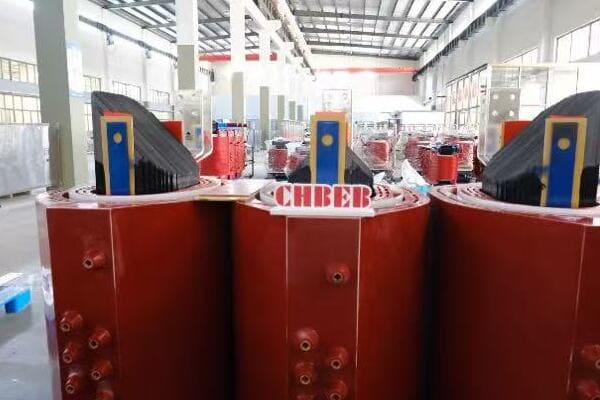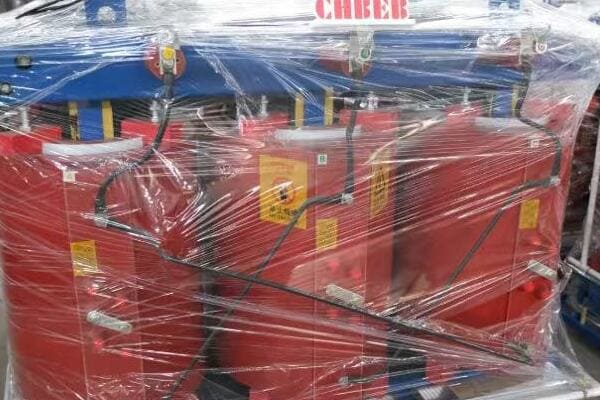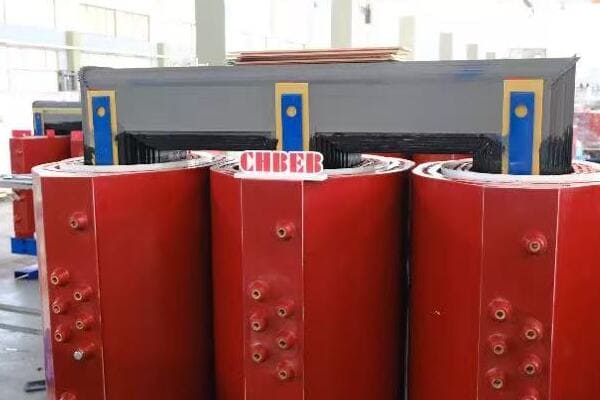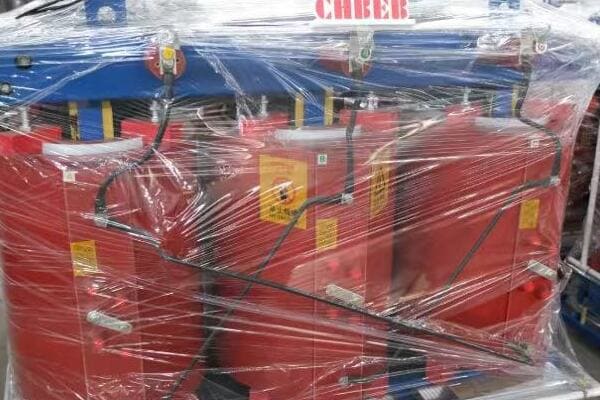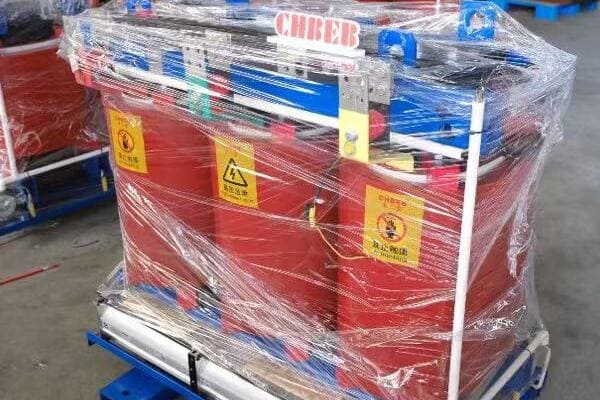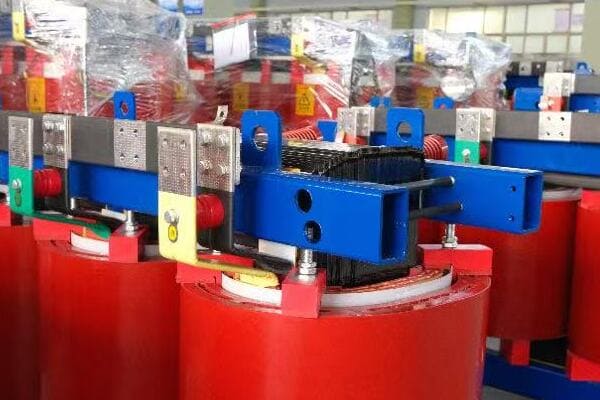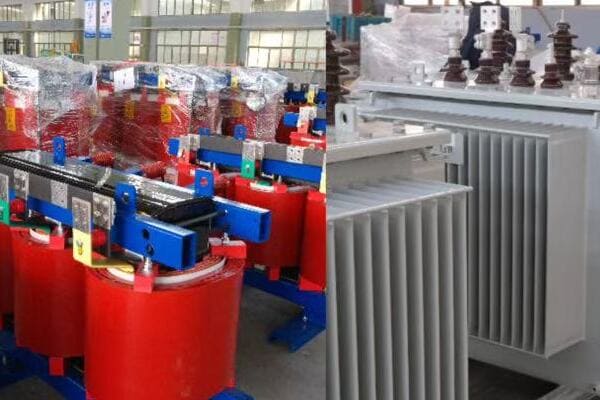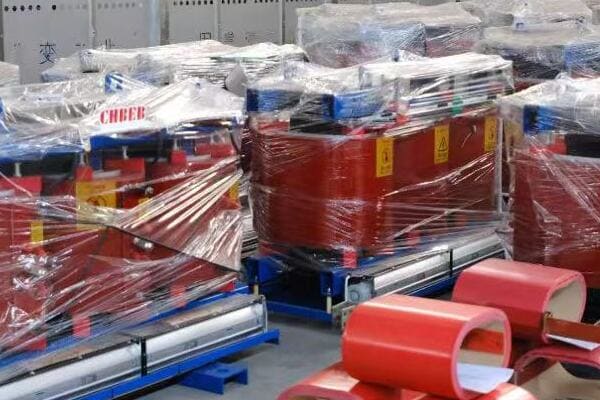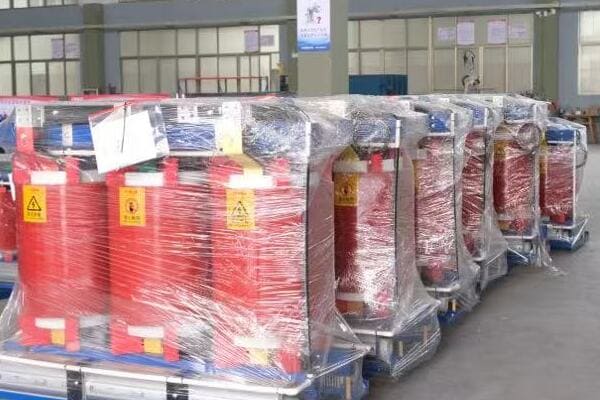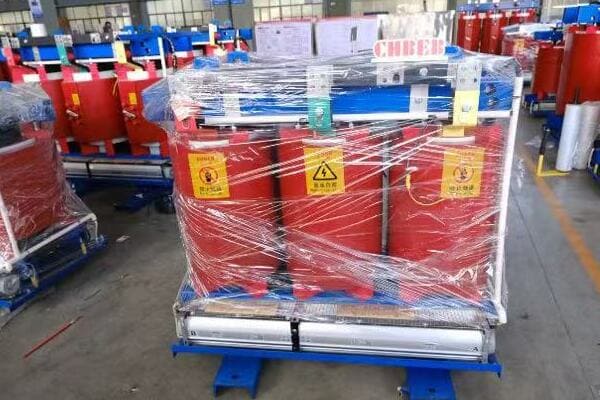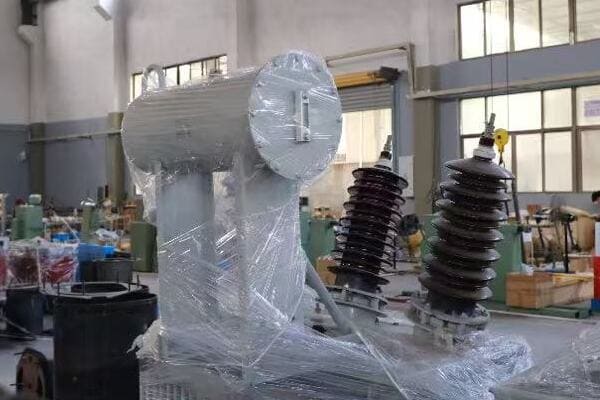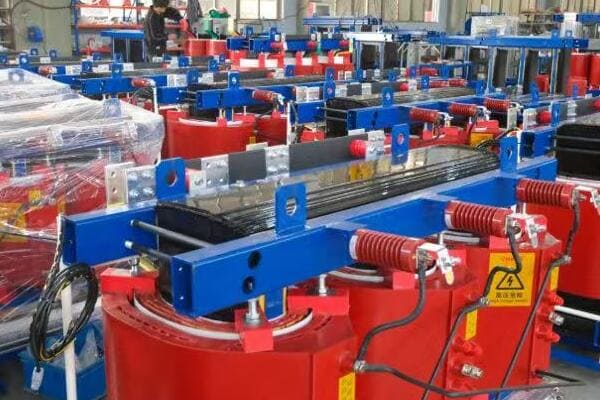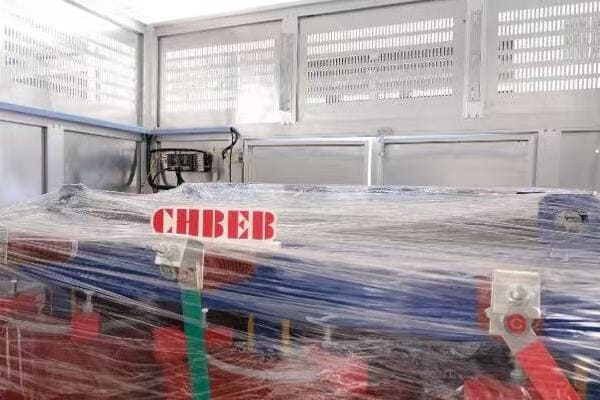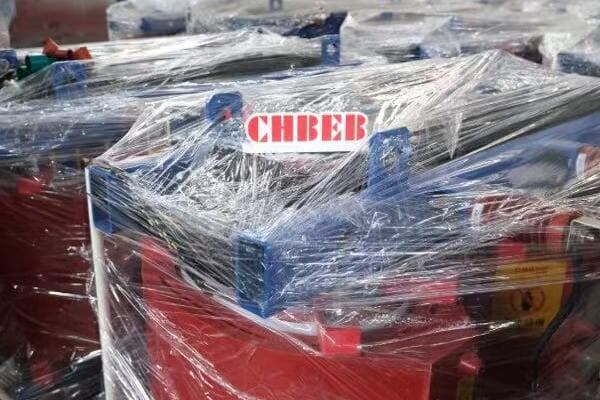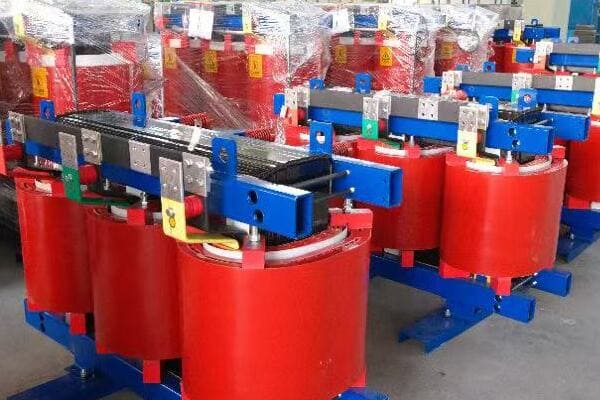Have you ever wondered what’s inside a transformer and how it actually works? You’re not alone. Many engineers and technicians find transformers mysterious, despite their crucial role in power systems. But what if you could understand these devices from the inside out?
Transformers consist of key electrical components including the magnetic core, windings, insulation, tap changers, and bushings. Each part plays a vital role in voltage regulation, energy transfer, and electrical safety. Understanding these elements helps in selecting, operating, and maintaining transformers efficiently.
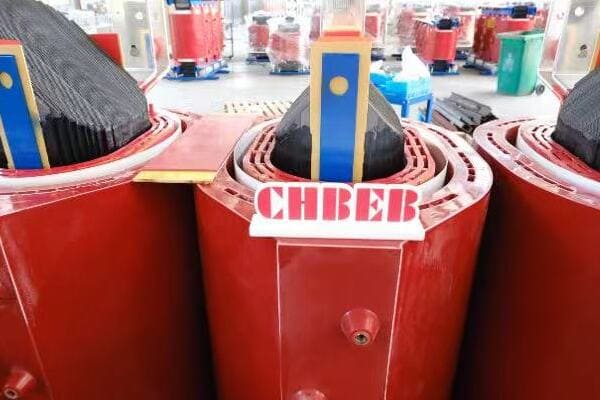
In this comprehensive guide, I’ll walk you through the main components of a transformer, explaining their functions and how they work together. Whether you’re a seasoned engineer or just starting in the field, this article will deepen your understanding of these essential power system devices.
What Are the Main Parts of a Transformer?
Have you ever looked at a transformer and wondered what’s inside that metal box or tank? Understanding the main components is crucial for anyone working with electrical systems. But what exactly are these parts, and why are they so important?
**The main parts of a transformer include:
- Magnetic Core
- Primary & Secondary Windings
- Insulation System
- Tap Changer (if present)
- Bushing Terminals
- Tank / Enclosure (for oil type)**
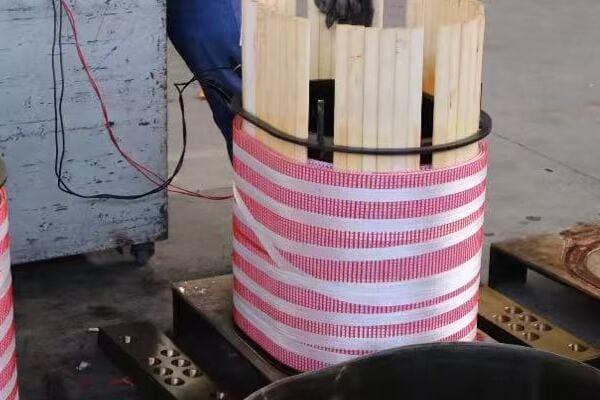
Diving Deeper into Transformer Components
Let’s explore each of these components in more detail:
Magnetic Core
The core is the heart of the transformer:
- Made from thin laminations of silicon steel
- Provides a path for magnetic flux
- Crucial for energy transfer between windings
Primary & Secondary Windings
Windings are the transformer’s electrical conductors:
- Usually made of copper or aluminum
- Primary winding receives input voltage
- Secondary winding delivers output voltage
- Number of turns determines voltage transformation ratio
Insulation System
Insulation is critical for safety and efficiency:
- Prevents short circuits between windings and core
- Can be air, oil, or solid materials like resin
- Quality of insulation affects transformer lifespan
Tap Changer
Not all transformers have tap changers, but they’re important for voltage regulation:
- Allows adjustment of turns ratio
- Can be on-load or off-load type
- Critical for maintaining stable output voltage
Bushing Terminals
Bushings are the connection points to the outside world:
- Insulated passages for conductors
- Allow safe connection of high voltage cables
- Often made of porcelain or composite materials
Tank / Enclosure
For oil-filled transformers, the tank is crucial:
- Contains the insulating oil
- Provides structural support
- Helps in heat dissipation
I once worked on a project where we had to troubleshoot a faulty transformer. By understanding these components, we quickly identified that the issue was with the tap changer, not the core or windings as initially suspected. This knowledge saved significant time and resources in the repair process.
Understanding these main components is just the beginning. Each part plays a crucial role in the transformer’s operation and efficiency. In the following sections, we’ll dive deeper into each component, exploring their functions and importance in more detail.
Transformer Core: The Magnetic Heart of the Device
Have you ever wondered why transformer cores are so heavy and what makes them so special? The core is often called the heart of the transformer, but why is it so crucial to the device’s operation?
The transformer core is made from laminated silicon steel sheets, designed to guide magnetic flux efficiently. It reduces eddy current losses and plays a vital role in energy transfer. There are several core types, including shell-type, core-type, and toroidal, each with specific advantages for different applications.

Key Aspects of Transformer Cores
Let’s explore the critical features of transformer cores:
- Made from laminated silicon steel
- Guides magnetic flux efficiently
- Reduces eddy current losses
- Types: Shell-type, Core-type, Toroidal
Core Material and Construction
Transformer cores are typically made from silicon steel, also known as electrical steel:
- Silicon content reduces eddy current losses
- Laminated construction further minimizes losses
- Thickness of laminations can be as little as 0.23mm
I once visited a transformer manufacturing plant where I saw the meticulous process of assembling these cores. The precision required in stacking the laminations was impressive, highlighting the importance of core construction in transformer efficiency.
Magnetic Flux Guidance
The core’s primary function is to guide magnetic flux:
- Provides a low-reluctance path for magnetic fields
- Ensures efficient energy transfer between windings
- Shape and design optimize flux distribution
Eddy Current Loss Reduction
Minimizing eddy current losses is crucial for efficiency:
- Laminations break up eddy current paths
- Grain-oriented steel aligns magnetic domains
- Proper core design can significantly reduce overall losses
Types of Transformer Cores
Different core types suit various applications:
-
Shell-type Core:
- Windings surrounded by core material
- Good for high-current, low-voltage applications
-
Core-type:
- Core surrounded by windings
- Common in distribution transformers
-
Toroidal Core:
- Donut-shaped core with windings around the circumference
- Highly efficient, often used in small-scale applications
In a recent project, we had to choose between core-type and shell-type designs for a large power transformer. We opted for the shell-type due to its better short-circuit strength, which was crucial for the high-current application.
Core Performance Factors
Several factors influence core performance:
| Factor | Impact on Performance |
|---|---|
| Material Quality | Affects magnetic properties and losses |
| Lamination Thickness | Thinner laminations reduce eddy currents |
| Core Shape | Influences flux distribution and efficiency |
| Assembly Method | Affects overall magnetic circuit quality |
Understanding these core characteristics is essential for transformer design and selection. The core’s quality and design directly impact the transformer’s efficiency, size, and overall performance. In my experience, a well-designed core can make the difference between an average transformer and an exceptional one, especially in high-efficiency applications.
Windings: How Electricity Flows Through the Transformer
Have you ever wondered how transformers actually change voltage levels? The secret lies in the windings. But what exactly are these windings, and how do they perform this seemingly magical feat of voltage transformation?
Transformer windings are coils of wire, typically made of copper or aluminum, that carry the electric current. The number of turns in the primary and secondary windings determines the voltage ratio. These windings are insulated and designed to handle specific current loads, directly impacting the transformer’s efficiency and heat dissipation.
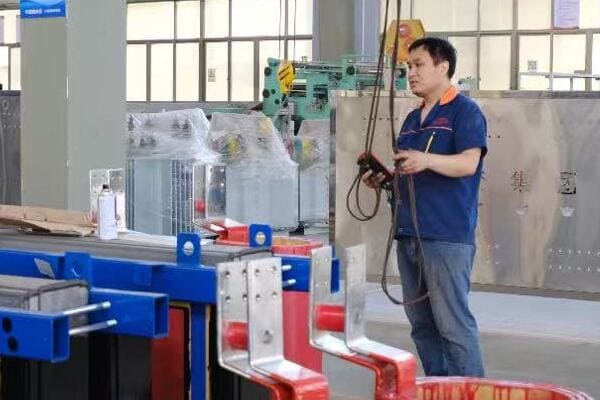
Key Aspects of Transformer Windings
Let’s explore the critical features of transformer windings:
- Made of copper or aluminum
- Determines voltage ratio
- Insulated with varnish or paper
- Impact efficiency & heat dissipation
Winding Materials
The choice of winding material is crucial:
- Copper: Higher conductivity, often used in high-performance transformers
- Aluminum: Lighter and less expensive, common in distribution transformers
I once worked on a project where we had to decide between copper and aluminum windings. We chose copper for its superior conductivity, which allowed for a more compact design in a space-constrained substation.
Voltage Ratio and Turns Ratio
The fundamental principle of transformer operation lies in the turns ratio:
- Primary to secondary turns ratio determines voltage transformation
- Voltage ratio = Turns ratio (in an ideal transformer)
- Example: 100 turns primary, 10 turns secondary = 10:1 step-down ratio
Winding Insulation
Proper insulation is critical for safety and longevity:
- Each turn is insulated to prevent short circuits
- Common insulation materials include enamel, paper, and synthetic materials
- Insulation class (e.g., Class F, Class H) determines temperature ratings
In a recent transformer repair, we discovered that degraded insulation was the root cause of a failure. This experience highlighted the importance of selecting appropriate insulation materials for the operating environment.
Winding Types and Arrangements
Different winding types suit various applications:
-
Layer Winding:
- Used in low-voltage applications
- Easy to manufacture
-
Disc Winding:
- Common in high-voltage transformers
- Better impulse voltage distribution
-
Helical Winding:
- Used for high-current applications
- Excellent cooling properties
Efficiency and Heat Dissipation
Winding design significantly impacts transformer efficiency:
- Larger conductor cross-sections reduce resistance losses
- Proper spacing allows for better cooling
- Winding arrangement affects leakage reactance
Here’s a comparison of winding characteristics:
| Characteristic | Copper Windings | Aluminum Windings |
|---|---|---|
| Conductivity | Higher | Lower |
| Weight | Heavier | Lighter |
| Cost | Higher | Lower |
| Durability | Excellent | Good |
| Heat Dissipation | Better | Good |
Understanding winding design and materials is crucial for optimizing transformer performance. In my experience, careful consideration of winding parameters can lead to significant improvements in efficiency, reliability, and lifespan of transformers. Whether you’re designing, selecting, or maintaining transformers, a solid grasp of winding principles is essential for making informed decisions.
Insulation System: Ensuring Electrical Safety and Longevity
Have you ever considered what keeps the high-voltage parts of a transformer from short-circuiting? The answer lies in the insulation system. But why is this system so critical, and how does it contribute to the safety and longevity of transformers?
The insulation system in transformers is crucial for electrical safety and operational longevity. It includes materials like Class F/H insulation for dry-type transformers, resin-encapsulated windings for cast resin types, and paper/oil combinations for oil-immersed units. Proper insulation prevents arcing, flashover, and failure, ensuring safe and efficient transformer operation.
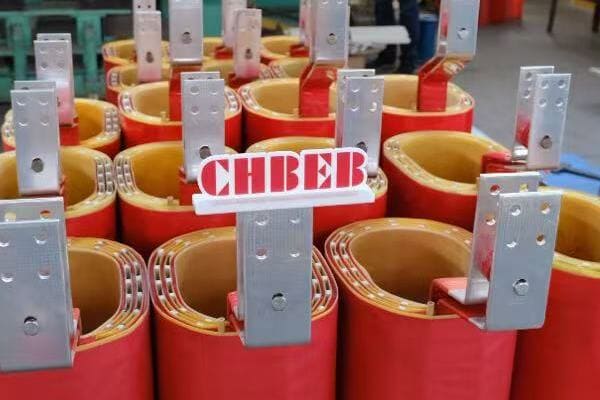
Key Aspects of Transformer Insulation Systems
Let’s explore the critical features of transformer insulation:
- Class F/H insulation for dry-type
- Resin encapsulated windings (for cast resin)
- Paper/oil for oil-immersed units
- Prevents arc, flashover, or failure
Insulation Classes
Insulation classes define temperature capabilities:
- Class F: Rated for 155°C
- Class H: Rated for 180°C
- Higher classes allow for higher operating temperatures
I once worked on upgrading a transformer from Class F to Class H insulation. This change allowed the transformer to handle higher loads without overheating, significantly improving its capacity and efficiency.
Dry-Type Transformer Insulation
Dry-type transformers use solid insulation systems:
- Typically use Class F or H insulation materials
- Often include epoxy resin impregnation or encapsulation
- Provides excellent fire safety and environmental benefits
Cast Resin Transformers
Cast resin transformers offer unique insulation properties:
- Windings are encapsulated in epoxy resin
- Provides excellent moisture and pollution resistance
- Ideal for harsh environments or indoor installations
In a recent project for a coastal industrial facility, we chose cast resin transformers specifically for their resistance to salt air and humidity, ensuring long-term reliability in the challenging environment.
Oil-Immersed Transformer Insulation
Oil-immersed transformers use a combination of solid and liquid insulation:
- Paper insulation on windings
- Mineral oil or synthetic fluids as insulating and cooling medium
- Offers excellent heat dissipation properties
Insulation System Components
A comprehensive insulation system includes:
- Turn-to-turn insulation
- Layer-to-layer insulation
- Winding-to-core insulation
- Winding-to-tank insulation (for oil-type)
Environmental and Safety Considerations
Modern insulation systems focus on safety and environmental aspects:
- Fire-resistant materials in dry-type transformers
- Biodegradable oils in some liquid-filled transformers
- Reduced use of harmful substances (e.g., PCBs)
Here’s a comparison of insulation types:
| Insulation Type | Advantages | Considerations |
|---|---|---|
| Dry-Type (Class F/H) | Fire-resistant, environmentally friendly | Limited overload capacity |
| Cast Resin | Excellent for harsh environments | Higher initial cost |
| Oil-Immersed | High overload capacity, efficient cooling | Requires oil maintenance |
Understanding insulation systems is crucial for ensuring transformer reliability and safety. In my experience, proper insulation selection and maintenance can significantly extend a transformer’s lifespan and prevent catastrophic failures. Whether you’re specifying a new transformer or maintaining existing ones, considering the insulation system is key to ensuring long-term performance and safety.
Other Key Components: Tap Changers, Bushings, Cooling Systems
Have you ever wondered how transformers maintain stable output voltages or connect to power lines safely? The answer lies in components like tap changers and bushings. But what exactly are these parts, and how do they contribute to a transformer’s functionality?
Transformers incorporate several key components beyond the core and windings. Tap changers adjust voltage ratios, bushings provide insulated connections for high/low voltage lines, and cooling systems manage heat dissipation. These components are crucial for voltage regulation, safe operation, and efficient performance of the transformer.
Essential Auxiliary Components of Transformers
Let’s explore these critical components:
- Tap Changer – Adjusts voltage ratio
- Bushings – Insulated terminals for HV/LV connection
- Cooling System – AN, AF, ONAN, ONAF, ANAF, etc.
Tap Changers
Tap changers are vital for voltage regulation:
- Allow adjustment of turns ratio
- Can be on-load (OLTC) or off-load type
- Critical for maintaining stable output voltage under varying load conditions
I once worked on a project where implementing an on-load tap changer significantly improved voltage stability in a rural distribution network, reducing complaints about voltage fluctuations.
Bushings
Bushings are crucial for safe electrical connections:
- Provide insulated passage for conductors through transformer tank or enclosure
- Come in various types: solid, oil-filled, or gas-filled
- Rated for specific voltage levels and current capacities
In a recent high-voltage transformer installation, selecting the right bushings was critical. We chose composite bushings over traditional porcelain for their better seismic performance and reduced maintenance needs.
Cooling Systems
Efficient cooling is essential for transformer performance and longevity:
- Types include:
- AN (Air Natural)
- AF (Air Forced)
- ONAN (Oil Natural Air Natural)
- ONAF (Oil Natural Air Forced)
- OFAF (Oil Forced Air Forced)
- Choice depends on transformer size, load, and environment
During a transformer upgrade project, we switched from ONAN to ONAF cooling, which allowed for a 20% increase in capacity without changing the core and windings.
Comparison of Auxiliary Components
Here’s a quick overview of these components:
| Component | Function | Types | Considerations |
|---|---|---|---|
| Tap Changer | Voltage adjustment | OLTC, Off-load | Load requirements, regulation needs |
| Bushings | Insulated connections | Solid, Oil-filled, Gas-filled | Voltage rating, environmental factors |
| Cooling System | Heat dissipation | AN, AF, ONAN, ONAF, OFAF | Load profile, ambient conditions |
Additional Important Components
Other key components include:
- Pressure Relief Devices: Protect against internal pressure build-up
- Buchholz Relay (for oil-type): Detects gas accumulation or oil loss
- Temperature Indicators: Monitor winding and oil temperatures
- Oil Preservation Systems: Maintain oil quality in oil-type transformers
Understanding these auxiliary components is crucial for proper transformer operation and maintenance. In my experience, paying attention to these elements can significantly enhance a transformer’s performance, reliability, and lifespan. Whether you’re designing a new installation or managing existing transformers, knowledge of these components is essential for making informed decisions and ensuring optimal operation.
Visual Diagram: Inside a Power Transformer
Have you ever wished you could see inside a power transformer to understand how all its components fit together? While opening up a live transformer is obviously not an option, a detailed visual diagram can provide invaluable insights into its internal structure and operation.
A comprehensive visual diagram of a power transformer reveals the intricate arrangement of its core, windings, insulation, and auxiliary components. This visual representation helps in understanding the spatial relationships between parts, the flow of magnetic flux, and the overall design principles that make transformers such efficient devices for voltage transformation.
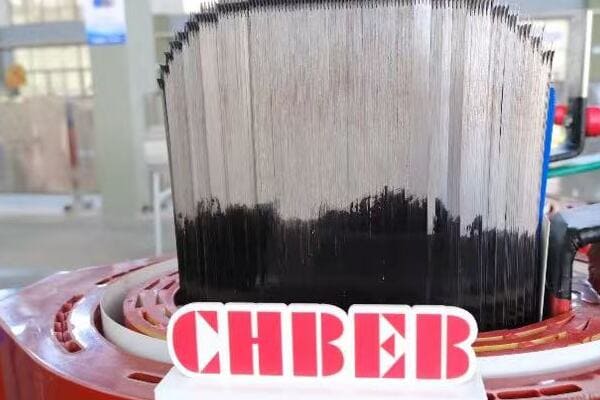
Key Elements in a Power Transformer Diagram
Let’s explore the essential components typically shown in a transformer diagram:
- Magnetic Core
- Primary and Secondary Windings
- Insulation Layers
- Cooling Ducts
- Tap Changer Mechanism
- Bushings
- Tank or Enclosure
- Cooling Radiators (for oil-filled types)
Understanding the Diagram
A well-designed transformer diagram offers several insights:
- Spatial Arrangement: Shows how components are positioned relative to each other
- Flux Path: Illustrates the magnetic circuit through the core
- Insulation Placement: Highlights critical areas of electrical isolation
- Cooling Mechanisms: Demonstrates how heat is dissipated
I once used a detailed transformer diagram to explain to a client why a particular design was more suitable for their application. The visual representation made it much easier to convey complex concepts about flux distribution and cooling efficiency.
Core and Winding Configuration
The diagram typically shows:
- Core shape (e.g., shell-type, core-type)
- Winding arrangement (concentric or sandwich)
- Relation between primary and secondary windings
Insulation and Cooling
Key features to observe:
- Insulation layers between windings and core
- Oil flow paths in oil-immersed transformers
- Air gaps for cooling in dry-type units
Auxiliary Components
Look for these important elements:
- Tap changer location and mechanism
- Bushing placements and design
- Cooling radiators or fans
Interpreting the Diagram
Here’s how different aspects of the diagram relate to transformer function:
| Diagram Element | Functional Significance |
|---|---|
| Core Shape | Influences magnetic flux path and efficiency |
| Winding Layout | Affects voltage regulation and short-circuit strength |
| Insulation Placement | Critical for preventing electrical breakdown |
| Cooling Paths | Determines heat dissipation capacity |
| Tap Changer Position | Indicates voltage adjustment capability |
Practical Applications of Transformer Diagrams
Understanding these diagrams is crucial for several reasons:
- Design Optimization: Engineers use them to refine transformer designs
- Maintenance Planning: Technicians refer to them for servicing procedures
- Fault Diagnosis: Helps in identifying potential failure points
- Education and Training: Excellent tools for teaching transformer principles
In my experience, a good transformer diagram is worth a thousand words when it comes to understanding these complex devices. Whether you’re a student learning about transformers for the first time or an experienced engineer working on advanced designs, a clear, comprehensive diagram is an invaluable resource.
Summary Table – Transformer Components and Their Functions
Are you looking for a quick reference guide to transformer components and their roles? Understanding the function of each part is crucial for anyone working with or studying transformers. But how can we summarize this complex information in an easily digestible format?
This summary table provides a concise overview of key transformer components and their functions. From the core that conducts magnetic flux to the bushings that provide safe connections, each element plays a vital role in the transformer’s operation. This table serves as a quick reference for engineers, technicians, and students alike.

Comprehensive Component Function Table
Here’s a detailed breakdown of transformer components and their functions:
| Component | Material | Function |
|---|---|---|
| Core | Silicon steel | Conducts magnetic flux |
| Windings | Copper/aluminum | Carries electric current |
| Insulation | Resin, paper, oil | Prevents short circuits |
| Tap Changer | Mechanical/electronic | Regulates output voltage |
| Bushings | Porcelain/composite | Provides safe connections |
| Tank/Enclosure | Steel | Contains and protects internal components |
| Cooling System | Various | Dissipates heat |
| Pressure Relief Device | Mechanical | Protects against overpressure |
| Buchholz Relay | Mechanical/electronic | Detects faults in oil-filled transformers |
| Temperature Indicators | Electronic | Monitors operating temperature |
Practical Applications of This Table
This summary table is more than just a list; it’s a powerful tool for various applications:
- Quick Reference: Ideal for field technicians needing rapid information
- Educational Aid: Helps students grasp the basics of transformer construction
- Design Checklist: Useful for engineers ensuring all components are considered
- Maintenance Guide: Assists in identifying components during servicing
I often refer to a similar table when conducting transformer training sessions. It provides a structured way to introduce each component and its role in the overall system.
Component Interrelationships
Understanding how these components work together is crucial:
- Core and Windings: Form the heart of the transformer’s electromagnetic system
- Insulation and Cooling: Work in tandem to maintain safe operating temperatures
- Tap Changer and Bushings: Essential for voltage regulation and power distribution
Material Choices and Their Impact
The choice of materials for each component significantly affects performance:
- Core Material: Influences efficiency and losses
- Winding Material: Impacts current-carrying capacity and size
- Insulation Type: Determines temperature ratings and environmental suitability
Maintenance Considerations
Different components require varying levels of maintenance:
| Component | Maintenance Frequency | Key Checks |
|---|---|---|
| Core | Low | Insulation resistance |
| Windings | Low | Resistance measurements |
| Insulation | Medium | Dielectric strength tests |
| Tap Changer | High | Contact wear, oil quality |
| Bushings | Medium | Surface contamination, oil levels |
In my experience, understanding the function and maintenance needs of each component is crucial for effective transformer management. This table serves as an excellent starting point for developing comprehensive maintenance strategies.
By familiarizing yourself with this summary table, you’ll have a solid foundation for understanding transformer operation, troubleshooting issues, and making informed decisions in transformer selection and maintenance. Whether you’re a seasoned professional or new to the field, this overview of components and their functions is an invaluable resource in your transformer knowledge toolkit.
Conclusion
Understanding the key components of transformers – from the core and windings to insulation and auxiliary parts – is crucial for effective design, operation, and maintenance. Each element plays a vital role in the transformer’s functionality, efficiency, and safety. By grasping these fundamentals, you’re better equipped to work with and manage these essential power system devices.
Remember, at chbeb-ele, we’re not just sharing information – we’re empowering you to be part of the solution in creating a secure, clean, and efficient energy future. Let’s continue this journey together.
Are you worried about potential issues with your dry type transformer installation? You’re not alone. Many engineers and technicians face challenges when setting up these crucial pieces of equipment. But what if you could avoid the most common pitfalls and ensure a flawless installation?
Improper ventilation, grounding, cable termination, and installation in unsuitable environments are common mistakes when setting up dry-type transformers. This guide outlines the top 5 errors and shows how to prevent them—ensuring safer operation, longer service life, and compliance with electrical standards.
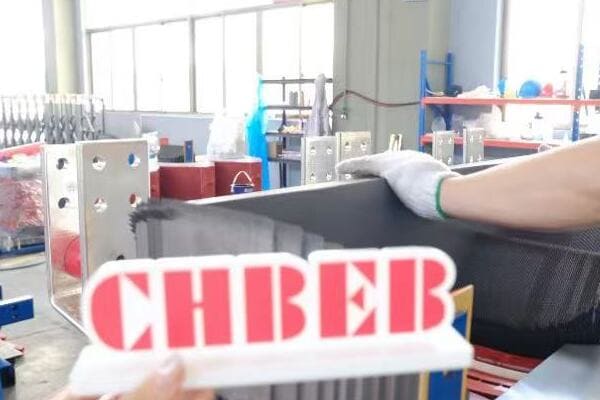
In this comprehensive guide, I’ll walk you through the five most common installation mistakes I’ve encountered in my years of experience with dry type transformers. More importantly, I’ll provide you with practical solutions to avoid these errors, ensuring your transformer operates safely and efficiently for years to come.
Mistake #1 – Ignoring Ventilation Requirements
Have you ever wondered why some transformers overheat even when they’re not overloaded? The answer often lies in poor ventilation. But why is proper airflow so crucial for dry type transformers, and how can you ensure your installation doesn’t fall into this common trap?
Adequate ventilation is critical for dry type transformers to dissipate heat effectively. Ignoring clearance requirements or obstructing airflow can lead to overheating, reduced efficiency, and premature failure. Proper installation requires following IEC 60076-11 specifications for air gaps and avoiding placement in sealed rooms or near heat sources.
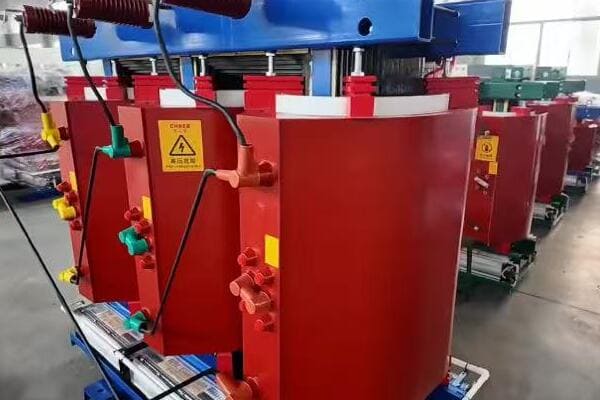
Key Ventilation Considerations
To ensure proper cooling of your dry type transformer, keep these points in mind:
- Transformers need minimum clearance on all sides
- Obstructed airflow = overheating risk
- Avoid placing in sealed rooms or near heat sources
- Follow IEC 60076-11 air gap specs
Understanding Clearance Requirements
Proper clearance is essential for effective heat dissipation:
- Top clearance: Usually the most critical, as heat rises
- Side clearances: Allow for convection currents
- Bottom clearance: Ensures air intake isn’t obstructed
I once consulted on a project where a transformer was installed in a tight utility closet. Despite being correctly sized for the load, it consistently overheated. The problem? Insufficient clearance on all sides, restricting airflow. We solved the issue by relocating the transformer to a more spacious area, immediately resolving the overheating problems.
Avoiding Airflow Obstructions
Even with proper clearance, obstructions can impede cooling:
- Keep areas around the transformer free of stored items
- Ensure ventilation openings in enclosures are not blocked
- Consider the impact of nearby equipment on air circulation
In a recent industrial installation, we discovered that large storage shelves had been placed too close to the transformer, blocking airflow on one side. This simple oversight led to localized overheating. Rearranging the storage area to maintain proper clearances solved the issue.
Environmental Considerations
The transformer’s environment plays a crucial role in cooling efficiency:
- Avoid sealed rooms without proper ventilation systems
- Be cautious of installing near heat-generating equipment
- Consider ambient temperature fluctuations in the installation area
I recall a data center project where a dry type transformer was initially placed near a bank of servers. The combined heat output created a hot spot, compromising the transformer’s efficiency. Relocating the transformer to a cooler area of the facility significantly improved its performance and lifespan.
Compliance with IEC 60076-11
Following international standards ensures optimal performance:
- Adhere to specified minimum clearances
- Consider using forced air cooling for high-load applications
- Regularly inspect and maintain ventilation systems
Here’s a quick reference table for typical clearance requirements:
| Position | Minimum Clearance | Recommended Clearance |
|---|---|---|
| Top | 300 mm | 500 mm |
| Sides | 200 mm | 300 mm |
| Front | 600 mm | 1000 mm |
| Rear | 200 mm | 300 mm |
Note: These are general guidelines. Always consult your transformer’s specific installation manual for exact requirements.
By paying close attention to ventilation requirements, you’re not just avoiding a common installation mistake; you’re ensuring the longevity and efficiency of your dry type transformer. Proper airflow is the key to maintaining optimal operating temperatures, preventing premature insulation breakdown, and ultimately, safeguarding your investment in this critical piece of equipment.
Mistake #2 – Incorrect Grounding Connections
Have you ever wondered why proper grounding is so crucial for dry type transformers? Many installers underestimate its importance, leading to potential safety hazards and equipment damage. But what exactly constitutes correct grounding, and how can you ensure your installation meets the necessary standards?
Correct grounding is essential for the safety and proper operation of dry type transformers. Using designated grounding lugs, ensuring continuity between the enclosure and system ground, and avoiding the use of mounting bolts for grounding are key. Poor grounding can lead to high fault currents, electric shock risks, and equipment failure.
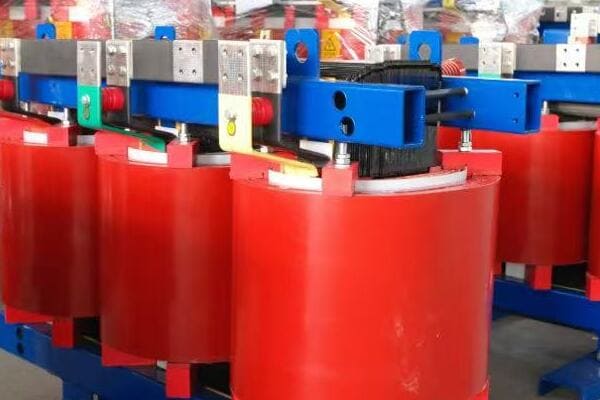
Essential Grounding Practices
To ensure proper grounding of your dry type transformer, keep these points in mind:
- Use designated grounding lugs, not mounting bolts
- Ensure continuity between enclosure and system ground
- Poor grounding = high fault current risk
Using Proper Grounding Points
Correct grounding starts with using the right connection points:
- Locate and use the designated grounding lugs or terminals
- Never rely on mounting bolts or structural components for grounding
- Ensure grounding points are clean and free of paint or corrosion
I once inspected a transformer installation where the technician had used a mounting bolt for grounding, assuming it provided a sufficient connection. This mistake could have led to dangerous voltage potentials on the transformer casing. We immediately corrected the issue by installing a proper ground connection to the designated lug.
Ensuring Ground Continuity
Continuity between the transformer enclosure and the system ground is crucial:
- Use appropriately sized grounding conductors
- Minimize the length of grounding cables to reduce impedance
- Regularly test ground continuity as part of maintenance routines
In a recent industrial project, we discovered intermittent ground faults. Upon investigation, we found that the grounding conductor was undersized for the application, leading to poor continuity. Upgrading to a larger gauge conductor resolved the issue and improved overall system safety.
Understanding the Risks of Poor Grounding
Inadequate grounding can lead to several serious issues:
- Increased risk of electric shock to personnel
- Potential for equipment damage during fault conditions
- Interference with sensitive electronic equipment
I recall a case where poor grounding led to mysterious equipment malfunctions in a nearby control room. The improperly grounded transformer was allowing stray currents to affect sensitive instrumentation. Correcting the grounding not only resolved the safety concern but also eliminated the operational issues.
Best Practices for Grounding Installation
Follow these guidelines to ensure proper grounding:
- Use copper conductors for grounding whenever possible
- Ensure all connections are tight and protected from corrosion
- Implement a regular inspection and testing schedule for ground connections
Here’s a quick reference table for grounding conductor sizing:
| Transformer kVA | Minimum Grounding Conductor Size (AWG/kcmil) |
|---|---|
| Up to 50 | 8 |
| 51-150 | 6 |
| 151-300 | 4 |
| 301-500 | 2 |
| Over 500 | 0 |
Note: Always consult local electrical codes and manufacturer specifications for exact requirements.
By paying close attention to grounding connections, you’re not just avoiding a common installation mistake; you’re ensuring the safety of personnel and the protection of your equipment. Proper grounding is fundamental to the safe and reliable operation of dry type transformers, providing a path for fault currents and helping to maintain stable voltage levels throughout your electrical system.
Mistake #3 – Improper Cable Termination
Are you confident that your transformer’s cable connections are secure and efficient? Many installers overlook the critical importance of proper cable termination, leading to potential hazards and performance issues. But what constitutes correct cable termination, and how can you ensure your installation meets the highest standards of safety and efficiency?
Proper cable termination is crucial for the safe and efficient operation of dry type transformers. This involves using the correct torque, avoiding cable stress, and ensuring clean, flush connections. Improper termination can lead to overheating, arcing, and even catastrophic failure of the transformer.
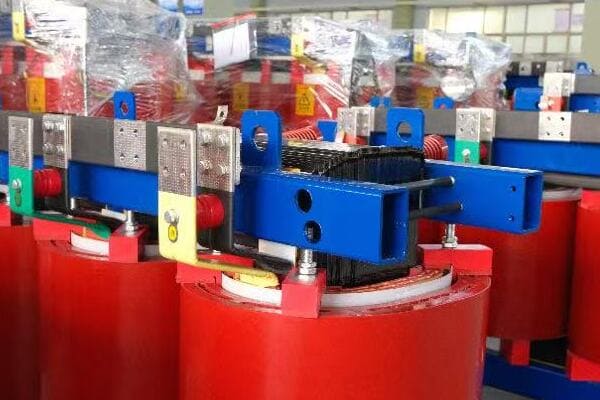
Key Aspects of Proper Cable Termination
To ensure correct cable termination for your dry type transformer, focus on these critical points:
- Use proper torque (as per terminal label)
- Avoid bending or stressing cable entries
- Ensure lug-to-bar contact is clean & flush
Applying Correct Torque
Using the right amount of torque is essential for secure connections:
- Always refer to the manufacturer’s specifications for torque values
- Use a calibrated torque wrench to achieve precise tightening
- Over-torquing can damage terminals, while under-torquing leads to loose connections
I once investigated a transformer failure where the primary cause was a loose connection due to under-torqued terminals. This simple oversight led to localized heating, eventually causing insulation breakdown and a costly outage. Since then, I always emphasize the importance of proper torque application in every installation.
Preventing Cable Stress
Proper cable management is crucial to prevent stress on terminations:
- Use appropriate cable support methods to reduce strain on connections
- Avoid sharp bends in cables, especially near termination points
- Allow sufficient slack in cables to accommodate thermal expansion and vibration
In a recent industrial installation, we observed premature cable insulation failure near the transformer terminals. Upon closer inspection, we found that the cables were installed with too tight a bend radius, causing stress and eventual breakdown. Rerouting the cables with proper support and gentler bends resolved the issue.
Ensuring Clean and Flush Connections
The quality of the physical connection is paramount:
- Clean all contact surfaces thoroughly before termination
- Ensure lugs are properly sized for the cable and terminal
- Verify that the lug-to-bar contact is flush and free of gaps
I recall a case where intermittent faults were traced back to contamination on the transformer terminals. A thin film of oil from the manufacturing process had been left on the terminals, preventing proper contact. A thorough cleaning and re-termination solved the problem, highlighting the importance of clean connections.
Best Practices for Cable Termination
Follow these guidelines to ensure optimal cable termination:
- Use compression lugs for larger cables to ensure better contact
- Implement a regular inspection schedule for all terminations
- Consider using infrared thermography to detect potential hot spots at connections
Here’s a quick reference table for common cable termination issues and solutions:
| Issue | Potential Consequences | Solution |
|---|---|---|
| Loose connections | Overheating, arcing | Apply correct torque, regular retightening |
| Contaminated surfaces | Poor contact, increased resistance | Clean thoroughly before termination |
| Improper lug size | Incomplete contact, overheating | Use correctly sized lugs for cable and terminal |
| Cable stress | Insulation damage, connection failure | Proper cable support and routing |
By paying close attention to cable termination details, you’re not just avoiding a common installation mistake; you’re ensuring the long-term reliability and safety of your dry type transformer. Proper termination is crucial for maintaining efficient power transfer, preventing localized heating, and ultimately, safeguarding your electrical system against failures and downtime.
Mistake #4 – Installing in Contaminated or Humid Locations
Have you considered how the environment affects your dry type transformer’s performance and lifespan? Many installers overlook the critical impact of location, leading to premature failures and reduced efficiency. But what exactly constitutes an unsuitable environment, and how can you ensure your transformer is protected against these challenges?
Installing dry type transformers in contaminated or humid environments without proper protection can lead to insulation degradation, reduced efficiency, and premature failure. Proper installation requires considering factors like air quality, humidity levels, and potential contaminants. Using appropriate enclosures or selecting transformers with enhanced environmental protection (e.g., E2, E3 ratings) is crucial for these challenging locations.
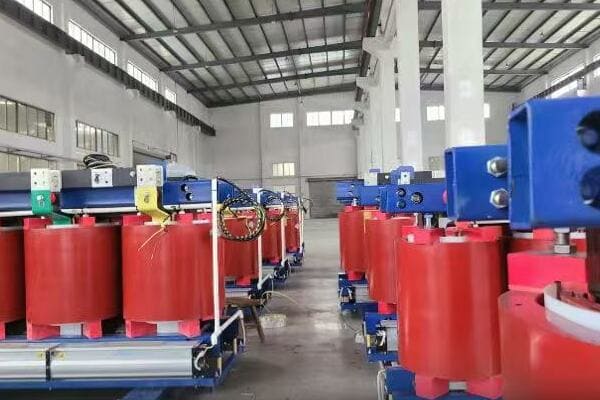
Key Considerations for Environmental Protection
When installing dry type transformers in challenging environments, keep these points in mind:
- Avoid corrosive gas/dust without E2 protection
- Use dry-type units with H-class resin for high humidity
- Add enclosures or filters if in industrial zones
Understanding Environmental Ratings
Dry type transformers come with different environmental protection ratings:
- E0: Basic protection, suitable for clean, dry environments
- E1: Light environmental protection
- E2: Enhanced protection against moisture and pollution
- E3: Highest level of protection for severe environments
I once consulted on a project where a standard E0-rated transformer was installed in a coastal industrial facility. Within months, we observed significant degradation due to salt air and industrial pollutants. Replacing it with an E2-rated unit resolved the issues and significantly extended the transformer’s lifespan.
Dealing with High Humidity
Humidity can be particularly challenging for dry type transformers:
- Consider using transformers with H-class insulation in high-humidity areas
- Implement dehumidification systems in transformer rooms if necessary
- Regular inspections for signs of moisture ingress are crucial
In a recent project in a tropical climate, we installed dry type transformers with H-class resin and additional enclosure ventilation. This combination effectively protected the units from the high ambient humidity, ensuring reliable operation in challenging conditions.
Protection Against Contaminants
Industrial environments often present risks from airborne contaminants:
- Use filtered enclosures in areas with high dust or particulate levels
- Consider sealed designs for environments with corrosive gases
- Regular cleaning and maintenance are essential in contaminated areas
I recall a case where a transformer in a cement plant was failing prematurely due to dust accumulation. We resolved the issue by installing a custom-designed filtered enclosure, which significantly improved the transformer’s performance and lifespan.
Best Practices for Challenging Environments
Follow these guidelines to protect your transformer in difficult conditions:
- Conduct a thorough environmental assessment before installation
- Choose the appropriate environmental rating based on the location
- Implement additional protective measures as needed (e.g., enclosures, filtration)
- Establish a rigorous maintenance schedule for transformers in harsh environments
Here’s a quick reference table for environmental considerations:
| Environmental Factor | Potential Impact | Protective Measure |
|---|---|---|
| High Humidity | Insulation degradation | H-class resin, dehumidification |
| Airborne Dust | Reduced cooling, insulation damage | Filtered enclosures, regular cleaning |
| Corrosive Gases | Accelerated component deterioration | Sealed designs, E2/E3 ratings |
| Salt Air | Corrosion of metal parts | Enhanced corrosion protection, E2/E3 ratings |
By carefully considering the installation environment and implementing appropriate protective measures, you’re not just avoiding a common mistake; you’re ensuring the longevity and reliability of your dry type transformer. Proper environmental protection is crucial for maintaining optimal performance, preventing premature failures, and ultimately, maximizing the return on your investment in this critical equipment.
Mistake #5 – Skipping Torque Checks and Final Testing
Are you confident that your newly installed dry type transformer is ready for safe, efficient operation? Many installers make the critical mistake of rushing through or completely skipping final checks and tests. But why are these final steps so crucial, and what risks do you run by overlooking them?
Skipping torque checks and final testing can lead to immediate failures or long-term reliability issues in dry type transformers. Proper installation requires verifying all connections with a torque wrench, performing insulation resistance tests, and conducting no-load tests before energization. These steps ensure safety, compliance, and optimal performance of the transformer.
Essential Final Checks and Tests
To ensure your dry type transformer is properly installed and ready for operation, focus on these critical steps:
- Check all terminals with torque wrench
- Perform insulation resistance tests
- Run no-load test before energization
- Document commissioning checklist
Importance of Torque Checks
Proper torque on all connections is crucial for safe and efficient operation:
- Use a calibrated torque wrench to verify all electrical connections
- Follow manufacturer’s specifications for torque values
- Re-check torque after initial heat cycles, as connections may loosen
I once investigated a transformer failure that occurred just weeks after installation. The root cause? A single loose connection that had been overlooked during final checks. This oversight led to localized heating, eventual arcing, and a costly shutdown. Since then, I always emphasize the critical importance of thorough torque checks as part of the final installation process.
Conducting Insulation Resistance Tests
Insulation resistance testing is crucial for verifying the integrity of the transformer’s insulation:
- Use a megohmmeter to test insulation resistance between windings and to ground
- Compare results to manufacturer’s specifications
- Investigate any unexpectedly low readings before energization
In a recent project, our insulation resistance test revealed unexpectedly low values. Further investigation uncovered moisture ingress during transportation. By identifying this issue before energization, we avoided potential insulation failure and were able to properly dry out the transformer before putting it into service.
Performing No-Load Tests
No-load testing provides valuable information about the transformer’s core performance:
- Measure input voltage, current, and power under no-load conditions
- Compare results to factory test reports
- Investigate any significant deviations from expected values
I recall a case where a no-load test revealed abnormally high current draw. This led us to discover a manufacturing defect in the core, which could have caused significant inefficiency and potential failure if not caught during this crucial test.
Documenting the Commissioning Process
Proper documentation is essential for future reference and maintenance:
- Create a comprehensive commissioning checklist
- Record all test results and observations
- Include photographs of key installation aspects
Here’s a sample commissioning checklist:
| Task | Verified (✔) | Notes |
|---|---|---|
| Clearance around unit | ☐ | |
| Grounding connections | ☐ | |
| Cable termination checked | ☐ | |
| Torque measurements | ☐ | |
| Insulation resistance test | ☐ | |
| No-load test | ☐ | |
| Visual inspection complete | ☐ |
Best Practices for Final Checks and Testing
Follow these guidelines to ensure thorough final checks:
- Allocate sufficient time for testing – rushing can lead to oversights
- Use calibrated test equipment for accurate results
- Have a second technician verify critical measurements
- Address any anomalies or unexpected results before energization
By meticulously performing these final checks and tests, you’re not just avoiding a common installation mistake; you’re ensuring the safety, reliability, and efficiency of your dry type transformer from day one. These steps are crucial for catching any issues that may have been overlooked during the installation process and provide a baseline for future maintenance and troubleshooting.
Installation Checklist for Dry Type Transformers
Are you looking for a comprehensive guide to ensure your dry type transformer installation is flawless? Look no further. This checklist covers all the critical steps you need to follow for a safe, efficient, and compliant installation.
A thorough installation checklist for dry type transformers includes verifying proper ventilation, correct grounding, secure cable terminations, environmental suitability, and comprehensive final testing. Following this checklist ensures optimal performance, safety compliance, and longevity of the transformer.
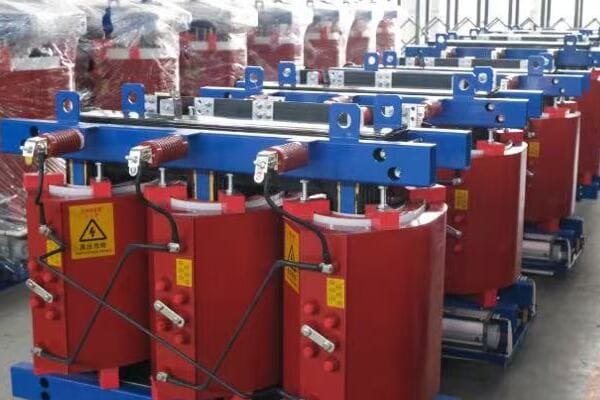
Complete Installation Checklist
Use this comprehensive checklist to guide your dry type transformer installation:
| Task | Verified (✔) | Notes |
|---|---|---|
| Ventilation and Clearance | ||
| Minimum clearance on all sides met | ☐ | |
| No obstructions to airflow | ☐ | |
| Room temperature within specs | ☐ | |
| Grounding | ||
| Proper grounding lug used | ☐ | |
| Grounding conductor sized correctly | ☐ | |
| Continuity to system ground verified | ☐ | |
| Cable Termination | ||
| Cables properly supported | ☐ | |
| Correct lugs used | ☐ | |
| Torque applied as per specs | ☐ | |
| Environmental Considerations | ||
| Transformer rating matches environment | ☐ | |
| Protection from contaminants in place | ☐ | |
| Humidity levels within acceptable range | ☐ | |
| Final Checks and Testing | ||
| All connections torque checked | ☐ | |
| Insulation resistance test performed | ☐ | |
| No-load test conducted | ☐ | |
| Visual inspection complete | ☐ | |
| Documentation | ||
| All test results recorded | ☐ | |
| Installation photos taken | ☐ | |
| Commissioning report completed | ☐ |
Using the Checklist Effectively
To make the most of this checklist:
- Review it before starting the installation to ensure you have all necessary tools and equipment.
- Use it as a step-by-step guide during the installation process.
- Have a second person verify each item for added safety and accuracy.
- Keep the completed checklist as part of your permanent installation records.
By following this comprehensive checklist, you’ll significantly reduce the risk of installation errors and ensure your dry type transformer is set up for optimal performance and longevity.
Conclusion
Avoiding these top 5 installation mistakes—improper ventilation, incorrect grounding, faulty cable termination, unsuitable environmental placement, and skipping final checks—is crucial for the safe and efficient operation of dry type transformers. By following the provided checklist and best practices, you can ensure a reliable, long-lasting installation that meets all safety and performance standards.
Remember, at chbeb-ele, we’re not just sharing information – we’re empowering you to be part of the solution in creating a secure, clean, and efficient energy future. Let’s continue this journey together.
Are you concerned about the environmental impact of your power distribution system? You’re not alone. Many engineers and facility managers are seeking greener alternatives to traditional oil-filled transformers. But what if there was a solution that could significantly reduce environmental risks while enhancing safety and compliance?
Dry-type transformers offer key environmental benefits by eliminating oil, reducing fire risks, and meeting green compliance standards like RoHS and REACH. Their design supports safer indoor use, lowers maintenance impact, and aligns with LEED and sustainable infrastructure goals.
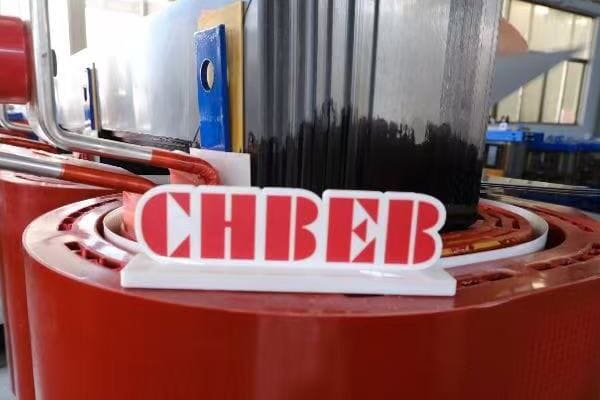
In this comprehensive guide, I’ll walk you through the environmental advantages of dry type transformers. From their inherently greener design to their role in sustainable building projects, you’ll discover why these transformers are becoming the go-to choice for environmentally conscious power distribution solutions.
Why Dry Type Transformers Are Greener by Design?
Have you ever wondered why dry type transformers are considered more environmentally friendly than their oil-filled counterparts? The answer lies in their fundamental design. But what specific features make them a greener choice for modern power distribution needs?
Dry type transformers are inherently greener due to their oil-free design. This eliminates the risk of oil leaks or spills, removes the need for oil handling and disposal, and significantly reduces the environmental footprint during operation. Their design also makes them safer for indoor and high-density urban areas.
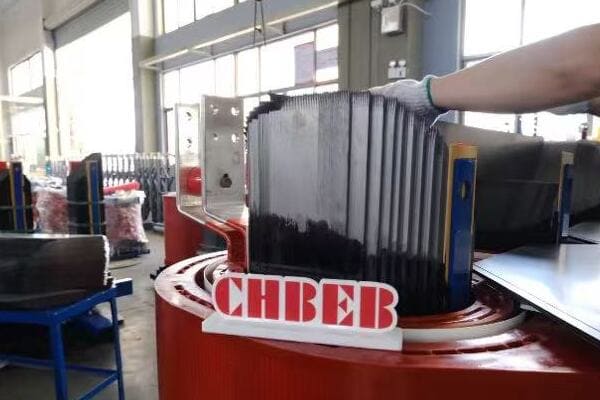
Key Environmental Advantages of Dry Type Transformers
Let’s explore the green features of dry type transformers:
- No risk of oil leaks or spills
- No need for oil handling, storage, or disposal
- Lower environmental footprint during operation
- Safer for indoor and high-density areas
Elimination of Oil-Related Risks
The absence of oil in dry type transformers is a game-changer for environmental safety:
- Zero risk of soil or water contamination from oil leaks
- No need for costly oil containment systems
- Reduced fire hazard and associated environmental risks
I once worked on a project replacing oil-filled transformers in an environmentally sensitive area near a water source. The switch to dry type units eliminated the constant worry about potential oil spills and their devastating environmental impact.
Simplified Maintenance and Reduced Waste
Dry type transformers offer significant environmental benefits through their maintenance profile:
- No oil testing or replacement required
- Reduced waste generation throughout the transformer’s lifecycle
- Lower risk of contamination during maintenance procedures
In a recent industrial project, we calculated that switching to dry type transformers would eliminate the need to dispose of thousands of liters of transformer oil over the equipment’s lifetime, significantly reducing the facility’s environmental footprint.
Enhanced Safety in Urban Environments
The design of dry type transformers makes them ideal for densely populated areas:
- Reduced fire load in buildings
- No oil smoke or fumes in case of failure
- Safer installation in multi-story buildings and underground facilities
I recall a project for a high-rise office building where the use of dry type transformers allowed for safer, more flexible installation options, reducing the overall environmental impact of the building’s power infrastructure.
Lower Carbon Footprint in Manufacturing and Transportation
The production and transportation of dry type transformers often have a lower environmental impact:
- No need for oil production and transportation
- Generally lighter weight, reducing transportation emissions
- Simpler manufacturing process with fewer environmentally sensitive materials
Here’s a quick comparison of environmental aspects:
| Aspect | Dry Type Transformer | Oil-Filled Transformer |
|---|---|---|
| Oil Spill Risk | None | Present |
| Maintenance Waste | Minimal | Significant (oil disposal) |
| Fire Safety | High | Moderate |
| Urban Suitability | Excellent | Limited |
| Manufacturing Impact | Lower | Higher |
By choosing dry type transformers, you’re not just selecting a piece of equipment; you’re making a decision that positively impacts the environment throughout the transformer’s entire lifecycle. From manufacturing to installation, operation, and eventual decommissioning, dry type transformers offer a greener alternative at every stage.
Fire Safety Advantages: F1 and Self-Extinguishing Materials?
Are you worried about fire risks associated with electrical equipment in your facility? You’re not alone. Fire safety is a top concern for many building managers and engineers. But did you know that dry type transformers offer significant fire safety advantages over traditional oil-filled units?
Dry type transformers excel in fire safety due to their F1 class insulation and self-extinguishing materials. The absence of flammable oil significantly reduces fire load, making them compliant with strict NFPA and IEC fire zone restrictions. This makes them ideal for hospitals, schools, and high-rise buildings where fire safety is paramount.
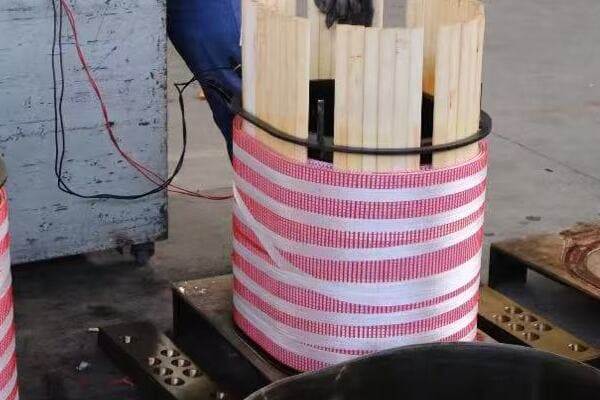
Key Fire Safety Features of Dry Type Transformers
Let’s explore the fire safety advantages in detail:
- F1 class insulation (IEC 60076-11)
- Self-extinguishing resin (halogen-free)
- No flammable oil = lower fire load
- Compliant with NFPA / IEC fire zone restrictions
F1 Class Insulation: The Gold Standard in Fire Safety
F1 class insulation is a game-changer for transformer fire safety:
- Highest fire safety classification for transformers
- Limited combustibility and flame propagation
- Minimal emission of toxic gases in case of fire
I once worked on a hospital renovation project where F1 class dry type transformers were essential. Their superior fire safety characteristics not only met stringent regulations but also provided peace of mind for the hospital administration, knowing that patient safety was enhanced.
Self-Extinguishing Materials: Active Fire Prevention
The use of self-extinguishing resins adds an extra layer of fire protection:
- Actively resists flame spread
- Halogen-free composition reduces toxic emissions
- Contributes to overall building fire safety
In a recent data center project, we chose dry type transformers with self-extinguishing resins. This decision was crucial in meeting the client’s strict fire safety requirements and insurance standards for critical infrastructure.
Reduced Fire Load: A Safer Building Environment
The absence of oil significantly reduces the fire load in buildings:
- No risk of oil-fueled fires
- Lower overall fire risk for the facility
- Simplified fire protection systems in transformer rooms
I recall a high-rise office project where using dry type transformers allowed us to place electrical rooms on higher floors. This was possible due to the reduced fire load, offering more flexible building design options while maintaining stringent safety standards.
Compliance with Fire Zone Restrictions
Dry type transformers easily meet strict fire safety regulations:
- Compliant with NFPA 70 requirements for indoor installations
- Meet IEC standards for fire-resistant electrical equipment
- Ideal for use in designated fire zones within buildings
Here’s a comparison of fire safety aspects:
| Aspect | Dry Type (F1 Class) | Oil-Filled Transformer |
|---|---|---|
| Fire Resistance | High | Moderate |
| Toxic Emissions | Minimal | Potentially High |
| Fire Load | Low | High |
| Indoor Use Safety | Excellent | Limited |
| Compliance with Fire Codes | Easy | Often Challenging |
By choosing F1 class dry type transformers with self-extinguishing materials, you’re not just buying a transformer; you’re investing in the safety of your facility and its occupants. These transformers provide a level of fire safety that is unmatched by traditional oil-filled units, making them the preferred choice for environments where safety cannot be compromised.
RoHS, REACH, and Other Green Compliance Standards?
Are you struggling to navigate the complex world of environmental compliance for your electrical equipment? You’re not alone. Many professionals find it challenging to keep up with evolving green standards. But what if your transformer choice could simplify this process and ensure you’re meeting all necessary environmental regulations?
Dry type transformers are designed to meet stringent environmental standards including RoHS and REACH. They typically use compliant materials free from restricted substances like lead, mercury, and cadmium. Many are manufactured in ISO 14001 certified facilities, ensuring environmental management best practices throughout production.
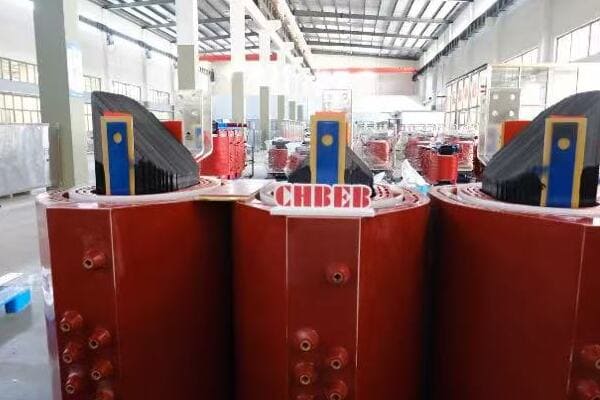
Green Compliance Checklist for Dry Type Transformers
When selecting a dry type transformer, look for these key compliance features:
✅ RoHS-compliant (no lead, mercury, cadmium, etc.)
✅ REACH-compliant materials
✅ Halogen-free insulation system
✅ UL / CE / ISO 14001 certified manufacturing
RoHS Compliance: Eliminating Hazardous Substances
RoHS (Restriction of Hazardous Substances) compliance is crucial for environmental safety:
- Ensures the transformer is free from restricted substances
- Reduces environmental impact during manufacturing and disposal
- Supports global efforts to reduce electronic waste
I once worked on a project exporting transformers to the European Union. RoHS compliance was non-negotiable, and our dry type units easily met these stringent requirements, simplifying the export process and ensuring market access.
REACH Compliance: Safe Chemical Management
REACH (Registration, Evaluation, Authorization and Restriction of Chemicals) compliance demonstrates responsible chemical use:
- Ensures safe use of chemicals in transformer production
- Provides transparency about substances used
- Supports long-term environmental and health protection
In a recent project for a multinational corporation, REACH compliance was a key factor in their supplier selection process. Our ability to provide fully compliant dry type transformers was a significant advantage in securing the contract.
Halogen-Free Insulation: A Cleaner, Safer Choice
Halogen-free insulation systems offer environmental and safety benefits:
- Reduced toxic emissions in case of fire
- Lower environmental impact during production and disposal
- Improved air quality in indoor installations
I recall a data center project where the client specifically requested halogen-free transformers to align with their strict environmental policies. This choice not only met their green requirements but also enhanced the overall safety of their facility.
Certified Manufacturing Processes
Transformers produced in certified facilities ensure environmental best practices:
- ISO 14001 certification guarantees environmental management standards
- UL and CE certifications often include environmental considerations
- Demonstrates commitment to sustainable manufacturing practices
Here’s a comparison of environmental compliance aspects:
| Compliance Aspect | Typical Dry Type Transformer | Traditional Oil-Filled Transformer |
|---|---|---|
| RoHS Compliance | Fully Compliant | May Require Special Versions |
| REACH Compliance | Generally Compliant | Varies |
| Halogen-Free | Often Standard | Rarely Available |
| Certified Manufacturing | Common (ISO 14001) | Varies |
By choosing dry type transformers that meet these green compliance standards, you’re not just purchasing equipment; you’re making a statement about your commitment to environmental responsibility. These transformers help you meet regulatory requirements, support sustainable practices, and contribute to a cleaner, safer environment for all.
Ideal for Green Buildings and LEED Projects?
Are you involved in green building projects or aiming for LEED certification? You might be wondering how your choice of electrical equipment can contribute to these goals. What if I told you that the right transformer selection could significantly boost your project’s green credentials?
Dry type transformers are ideal for green buildings and LEED projects due to their energy efficiency, reduced environmental impact, and safety features. They contribute to LEED credits in Energy & Atmosphere categories, support indoor air quality targets, and improve overall building energy performance ratings.

How Dry Type Transformers Support Green Building Initiatives
Let’s explore how these transformers fit into various green building scenarios:
| Project Type | Transformer Feature | Green Certification Support |
|---|---|---|
| LEED Building | Low-loss + no oil | Contributes to Energy & Atmosphere credits |
| Hospital | Fire safe, no emissions | Supports indoor air quality targets |
| Data Center | High-efficiency + compact | Improves energy performance ratings |
LEED Buildings: Boosting Energy & Atmosphere Credits
Dry type transformers can significantly contribute to LEED certification:
- Energy efficiency reduces overall building power consumption
- No-oil design aligns with sustainable site development goals
- Low electromagnetic emissions support healthy indoor environments
I recently worked on a LEED Gold office building project where the use of high-efficiency dry type transformers directly contributed to achieving additional points in the Energy & Atmosphere category. This helped push the project from Silver to Gold certification status.
Hospitals: Enhancing Safety and Air Quality
In healthcare settings, dry type transformers offer unique advantages:
- Fire safety features crucial for patient areas
- No oil means no risk of contamination
- Low noise operation supports healing environments
During a major hospital expansion project, we implemented dry type transformers throughout the facility. This choice not only met strict safety regulations but also supported the hospital’s goals for improved indoor air quality and patient comfort.
Data Centers: Maximizing Efficiency and Reliability
For data centers, dry type transformers provide essential benefits:
- High efficiency reduces overall energy costs
- Compact design allows for better space utilization
- Improved reliability with lower maintenance needs
In a recent hyperscale data center project, the use of advanced dry type transformers played a crucial role in achieving the facility’s aggressive power usage effectiveness (PUE) targets, directly impacting its green certification level.
Green Building Performance Metrics
Here’s how dry type transformers can impact various green building metrics:
- Energy Efficiency: Can reduce losses by up to 60% compared to standard units
- Indoor Environmental Quality: Zero emissions contribute to better air quality
- Innovation in Design: Advanced models can serve as showcase green technology
- Sustainable Sites: No oil eliminates risks of soil or water contamination
Consider this comparison for green building applications:
| Aspect | Dry Type Transformer | Oil-Filled Alternative |
|---|---|---|
| LEED Credit Potential | High | Limited |
| Indoor Air Quality Impact | Positive | Potential Concern |
| Energy Efficiency | Very High | Moderate to High |
| Safety in Green Spaces | Excellent | Good |
| Lifecycle Environmental Impact | Low | Moderate |
By choosing dry type transformers for your green building or LEED project, you’re not just selecting a piece of equipment; you’re making a strategic decision that aligns with and enhances your overall sustainability goals. These transformers offer a perfect blend of efficiency, safety, and environmental responsibility, making them an ideal choice for projects where green credentials are a priority.
Reduced Maintenance = Lower Environmental Impact?
Have you ever considered how equipment maintenance affects your facility’s environmental footprint? Many overlook this aspect, but it’s a crucial factor in long-term sustainability. So, how can the choice of a transformer impact your maintenance needs and, by extension, your environmental impact?
Dry type transformers significantly reduce maintenance requirements compared to oil-filled units. This translates to lower environmental impact through reduced waste generation, eliminated risk of oil contamination, and a longer service life. The simplicity of their maintenance regime also means fewer resources are needed over the transformer’s lifecycle.
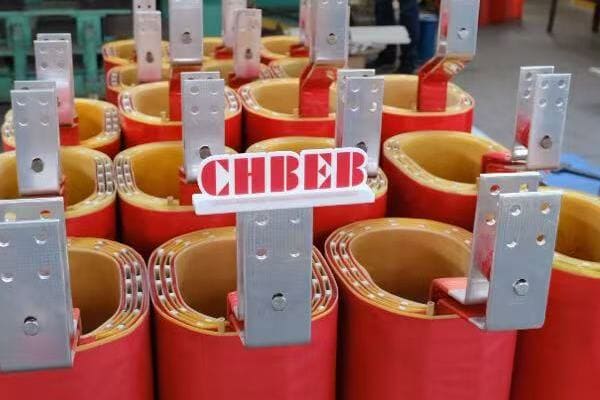
Key Environmental Benefits of Reduced Maintenance
Let’s explore how the low-maintenance nature of dry type transformers contributes to environmental protection:
- No oil testing or replacement
- No risk of oil contamination
- No need for containment pits
- Long service life reduces waste generation
Elimination of Oil-Related Maintenance
The absence of oil in dry type transformers removes several maintenance-related environmental risks:
- No periodic oil testing or filtration required
- Eliminates the need for oil disposal and replacement
- Reduces the risk of spills during maintenance procedures
I recall a project where we replaced oil-filled transformers with dry types in a water treatment facility. The elimination of oil-related maintenance not only reduced costs but also removed the constant worry about potential contamination of the water supply.
Simplified Inspection and Cleaning Procedures
Dry type transformers require minimal maintenance:
- Simple visual inspections are often sufficient
- Occasional cleaning with compressed air or vacuum
- No need for specialized oil handling equipment
In a recent data center project, the simplified maintenance of dry type transformers was a key factor in their selection. This not only reduced the environmental impact of maintenance activities but also minimized the risk of human error during servicing.
Extended Service Life and Reduced Waste
The durability of dry type transformers contributes to waste reduction:
- Typical lifespan of 20-30 years, often longer than oil-filled units
- Fewer replacements mean less manufacturing and disposal waste
- Many components are recyclable at end-of-life
I worked on an industrial facility upgrade where we calculated the lifecycle impact of switching to dry type transformers. The reduced need for replacements and maintenance over a 25-year period resulted in a significant reduction in waste generation and resource consumption.
Environmental Impact of Maintenance Activities
Consider these environmental aspects of transformer maintenance:
| Aspect | Dry Type Transformer | Oil-Filled Transformer |
|---|---|---|
| Waste Generation | Minimal | Significant (oil, filters) |
| Contamination Risk | Very Low | Moderate to High |
| Resource Consumption | Low | Higher (oil, parts) |
| Frequency of Intervention | Low | Regular |
| End-of-Life Disposal | Simpler, More Recyclable | Complex, Potential Hazardous Waste |
Case Study: Long-Term Environmental Impact
In a recent project for a large commercial complex, we conducted a 20-year environmental impact assessment comparing dry type and oil-filled transformers. Here are some key findings:
- Waste Reduction: The dry type option generated 95% less maintenance-related waste over its lifetime.
- Carbon Footprint: Reduced maintenance activities led to a 30% lower carbon footprint from service-related travel and operations.
- Water Protection: Elimination of oil removed the risk of water contamination, a critical factor for the nearby wetland ecosystem.
This study clearly demonstrated the long-term environmental benefits of choosing low-maintenance dry type transformers.
By opting for dry type transformers, you’re not just simplifying your maintenance routine; you’re making a choice that has far-reaching positive impacts on the environment. From reduced waste generation to lower risk of contamination, the benefits accumulate over the transformer’s entire lifecycle, contributing significantly to your facility’s overall environmental performance.
A Sustainable Choice for the Future of Power Distribution?
Are you wondering how your transformer choices today will impact the future of power distribution? As we move towards a more sustainable world, it’s crucial to consider how our infrastructure decisions align with long-term environmental goals. But how exactly do dry type transformers fit into this vision of a greener future?
Dry type transformers represent a sustainable choice for future power distribution needs. They align with global decarbonization goals, integrate well with renewable energy infrastructure, and are increasingly preferred in urban planning and ESG-driven procurement. Their eco-friendly design makes them ideal for the evolving landscape of sustainable power systems.
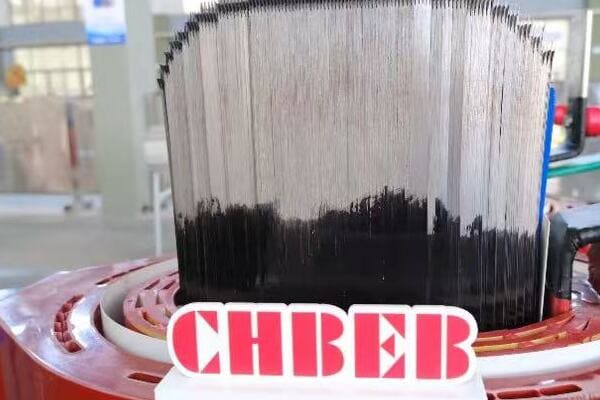
Key Aspects of Dry Type Transformers in Future Sustainability
Let’s explore how dry type transformers contribute to sustainable power distribution:
Alignment with Global Decarbonization Goals
Dry type transformers support the transition to a low-carbon economy:
- Higher efficiency reduces overall energy consumption and related emissions
- No oil means no risk of greenhouse gas emissions from leaks or disposal
- Longer lifespan reduces the carbon footprint associated with manufacturing and replacement
I recently consulted on a city-wide energy upgrade project where the switch to high-efficiency dry type transformers was projected to reduce the city’s carbon emissions by thousands of tons annually, directly contributing to their climate action plan.
Integration with Renewable Energy Infrastructure
These transformers are well-suited for renewable energy systems:
- Can handle the variable loads typical of solar and wind power
- Compact design ideal for offshore wind platforms and solar farms
- Environmental safety crucial for remote or sensitive installation sites
In a large-scale solar farm project, we implemented dry type transformers specifically designed for renewable applications. Their ability to handle fluctuating loads and withstand outdoor conditions was crucial for the project’s success and long-term sustainability.
Urban Planning and Smart City Initiatives
Dry type transformers are becoming a preferred choice in urban development:
- Safer for high-density areas due to reduced fire risk
- Lower noise levels suitable for residential and mixed-use zones
- Compact design allows for more flexible urban substation planning
During a recent smart city planning initiative, the use of dry type transformers allowed for more integrated power distribution within the urban landscape. Their safety and compact nature enabled innovative designs that blended substations seamlessly into the cityscape.
ESG-Driven Procurement Trends
Environmental, Social, and Governance (ESG) considerations are driving transformer choices:
- No-oil design aligns with environmental protection goals
- Improved safety features support social responsibility aspects
- Transparency in materials and manufacturing supports governance objectives
I’ve observed a growing trend among corporate clients where ESG factors are becoming primary drivers in equipment selection. In several recent projects, the environmental benefits of dry type transformers were key in meeting the clients’ sustainability reporting requirements.
Public Sector Leadership
Government and public institutions are increasingly mandating eco-friendly options:
- Many public projects now require "non-oil" electrical equipment
- Educational institutions leading in adopting sustainable technologies
- Healthcare facilities prioritizing patient and environmental safety
In a recent government infrastructure project, the specification explicitly called for dry type transformers as part of their commitment to sustainable and safe public facilities.
Here’s a comparison of how dry type transformers align with future sustainability trends:
| Sustainability Aspect | Dry Type Transformer | Traditional Oil-Filled |
|---|---|---|
| Carbon Footprint | Lower | Higher |
| Renewable Energy Compatibility | Excellent | Good |
| Urban Integration | Highly Suitable | Challenging |
| ESG Alignment | Strong | Moderate |
| Future-Proofing | High | Moderate |
By choosing dry type transformers, you’re not just making a decision for today; you’re investing in a sustainable future for power distribution. These transformers represent a forward-thinking approach that aligns with global environmental goals, adapts to the changing landscape of energy generation, and meets the evolving demands of urban development and corporate responsibility.
As we look to the future, the role of dry type transformers in creating a more sustainable and resilient power infrastructure becomes increasingly clear. Their environmental benefits, safety features, and adaptability make them an ideal choice for those looking to build power systems that will stand the test of time while minimizing environmental impact.
Conclusion
Dry type transformers offer significant environmental benefits through their oil-free design, enhanced fire safety, and compliance with green standards. They reduce maintenance-related environmental impacts and align with sustainable building practices. As we move towards a greener future in power distribution, dry type transformers stand out as a responsible and forward-thinking choice.
Are you struggling to choose the perfect dry type transformer for your project? You’re not alone. Many engineers and project managers find themselves overwhelmed by the myriad of options available. But what if you could easily navigate this complex decision-making process?
Selecting the right dry type transformer involves understanding your application environment, considering key parameters like power rating and efficiency, matching transformer types to project categories, ensuring compliance with safety standards, and balancing budget constraints with performance needs. This guide provides a step-by-step approach to help you make an informed decision.
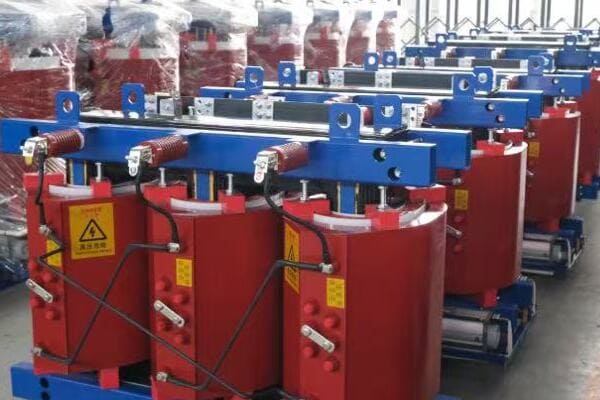
In this comprehensive guide, I’ll walk you through the essential factors to consider when selecting a dry type transformer for industrial, commercial, or renewable energy projects. Whether you’re designing a new electrical system or upgrading an existing one, this article will equip you with the knowledge to make the best choice for your specific needs.
Understand Your Application Environment
Have you ever wondered why some transformers fail prematurely in certain environments? The answer often lies in mismatching the transformer to its application environment. But how can you ensure you’re choosing a transformer that will thrive in your specific conditions?
Understanding your application environment is crucial for selecting the right dry type transformer. Key factors include indoor vs outdoor installation, ambient temperature and humidity levels, and load variability. These conditions significantly impact transformer performance, lifespan, and maintenance requirements.
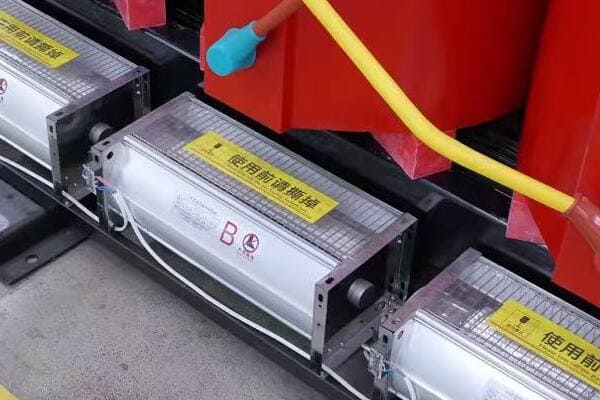
Diving Deeper into Application Environments
Let’s explore the key aspects of application environments that influence transformer selection:
Indoor vs Outdoor Installations
The location of your transformer plays a crucial role in its design and protection requirements:
- Indoor installations: Often require less environmental protection but may need enhanced fire safety features.
- Outdoor installations: Need robust protection against weather, UV radiation, and potential physical damage.
I once worked on a project where an indoor-rated transformer was mistakenly installed outdoors. Within months, we saw significant degradation due to moisture ingress. This experience underscored the importance of matching the transformer’s environmental rating to its actual installation location.
Ambient Temperature and Humidity Levels
Temperature and humidity can significantly impact transformer performance and lifespan:
- High temperatures: Can accelerate insulation aging and reduce efficiency.
- High humidity: Increases the risk of partial discharges and insulation breakdown.
In a recent project in a tropical climate, we opted for a transformer with enhanced cooling and specially treated insulation to withstand the high heat and humidity. This choice resulted in significantly improved performance and reliability compared to standard models.
Load Variability and Peak Demand
Understanding your load profile is essential for proper transformer sizing:
- Stable loads: Allow for more precise sizing and potentially smaller transformers.
- Variable loads: May require oversizing or special designs to handle peak demands.
I recall a renewable energy project where the highly variable load from wind turbines initially caused overheating in standard transformers. By implementing transformers with advanced cooling systems and higher short-term overload capacity, we were able to resolve the issue and optimize the system’s performance.
Here’s a quick reference table for environmental considerations:
| Environment Factor | Impact on Transformer Selection |
|---|---|
| Indoor Installation | Focus on fire safety, noise reduction |
| Outdoor Installation | Emphasis on weather protection, UV resistance |
| High Temperature | Need for enhanced cooling systems |
| High Humidity | Requires moisture-resistant insulation |
| Variable Load | May need oversizing or special designs |
Understanding these environmental factors is the first step in selecting the right dry type transformer. By carefully considering your specific application environment, you can ensure that the transformer you choose will operate efficiently, safely, and reliably throughout its intended lifespan. Remember, a transformer that’s perfectly suited for one environment may fail prematurely in another, so taking the time to assess these factors thoroughly is crucial for the success of your project.
Key Selection Parameters for Dry Type Transformers
Are you finding it challenging to navigate the technical specifications of dry type transformers? You’re not alone. Many professionals struggle to identify which parameters are truly critical for their projects. But what if you had a clear guide to the most important factors to consider?
Key selection parameters for dry type transformers include rated power and voltage class, impedance and efficiency, cooling method, fire safety class, and physical dimensions. Understanding these factors is crucial for choosing a transformer that meets your project’s specific requirements and ensures optimal performance and safety.
Essential Parameters for Transformer Selection
Let’s break down the critical factors you need to consider:
- Rated power & voltage class
- Impedance and efficiency
- Cooling method (AN / AF / ANAF)
- Fire safety class (F1 / E2 / C2)
- Mounting & footprint size
Rated Power and Voltage Class
The rated power (kVA) and voltage class are fundamental specifications:
- Rated power: Determines the transformer’s capacity to handle your load.
- Voltage class: Must match your system’s primary and secondary voltage requirements.
I once consulted on a project where the client initially underestimated their power needs. By carefully analyzing their future expansion plans, we were able to recommend a higher-rated transformer that accommodated their growth without requiring a costly upgrade later.
Impedance and Efficiency
These factors affect system performance and operating costs:
- Impedance: Influences fault current levels and voltage regulation.
- Efficiency: Directly impacts energy costs over the transformer’s lifetime.
In a recent industrial project, we opted for a slightly more expensive but higher efficiency transformer. The energy savings over just five years more than justified the initial cost difference, highlighting the importance of considering long-term operational costs.
Cooling Method
The cooling method affects the transformer’s capacity and installation requirements:
- AN (Air Natural): Simplest, but limited capacity.
- AF (Air Forced): Higher capacity, but requires fan maintenance.
- ANAF (Air Natural Air Forced): Flexible for varying loads.
For a data center project with variable loads, we chose an ANAF system. This allowed for efficient operation during low-load periods while providing extra cooling capacity during peak times.
Fire Safety Class
Critical for indoor installations and sensitive environments:
- F1: Limited flammability
- E2: Environmental hazard containment
- C2: Climatic hazard protection
In a hospital renovation project, selecting a transformer with F1 and E2 classifications was crucial for meeting strict safety regulations and ensuring patient safety.
Mounting and Footprint Size
Physical dimensions can be a critical factor, especially in retrofit projects:
- Consider available space and access for installation and maintenance.
- Factor in ventilation requirements based on the cooling method.
I recall a challenging urban substation upgrade where space was at a premium. By selecting a compact cast resin transformer with optimized cooling, we were able to increase capacity without expanding the existing transformer vault.
Here’s a quick reference table for these key parameters:
| Parameter | Importance | Considerations |
|---|---|---|
| Rated Power | Critical | Current and future load requirements |
| Voltage Class | Critical | Must match system voltages |
| Impedance | Important | Affects system fault levels |
| Efficiency | High | Impacts long-term operating costs |
| Cooling Method | Important | Affects capacity and maintenance needs |
| Fire Safety | Critical for indoor | Regulatory and safety requirements |
| Size | Varies | Installation space constraints |
By carefully considering these key parameters, you can ensure that the dry type transformer you select not only meets your current needs but also provides the flexibility and efficiency required for long-term success. Remember, the goal is to balance these factors to find the optimal solution for your specific project requirements.
Matching Transformer Types to Project Categories
Are you unsure which type of dry transformer is best suited for your specific project? You’re not alone. Many professionals find it challenging to match transformer types to different project categories. But what if you had a clear guide to help you make the right choice for your industrial, commercial, or renewable energy project?
Different project categories require specific transformer types. Industrial plants often need cast resin transformers with AF cooling for high loads and ambient heat. Commercial buildings benefit from AN cooling for silent operation. Renewable energy stations require ANAF or ANCF types to handle variable loads and outdoor conditions.
Detailed Transformer Type Recommendations
Let’s explore the best transformer types for various project categories:
| Project Type | Recommended Type | Key Feature |
|---|---|---|
| Industrial Plant | Cast Resin, AF Cooling | Handles high loads & ambient heat |
| Commercial Building | AN Cooling, Low Noise | Silent & maintenance-friendly |
| Renewable Station | ANAF / ANCF | Variable load, outdoor protection |
Industrial Plant Applications
For industrial environments, cast resin transformers with AF (Air Forced) cooling are often the best choice:
- High load capacity: Suitable for heavy industrial machinery.
- Ambient heat tolerance: Can withstand high temperatures common in industrial settings.
- Durability: Resistant to industrial pollutants and vibrations.
I once worked on a steel mill project where we implemented cast resin transformers with enhanced AF cooling. This choice allowed for reliable operation in the high-heat, dusty environment, significantly reducing downtime compared to their previous oil-filled units.
Commercial Building Applications
In commercial settings, AN (Air Natural) cooling with a focus on low noise is typically preferred:
- Silent operation: Crucial for office environments and public spaces.
- Low maintenance: Ideal for buildings with limited technical staff.
- Fire safety: Often comes with higher fire resistance ratings.
For a recent high-rise office project, we selected low-noise AN cooled transformers. The absence of cooling fans not only reduced noise but also simplified maintenance, a key factor for the building management team.
Renewable Energy Station Applications
Renewable energy projects often benefit from ANAF (Air Natural Air Forced) or ANCF (Air Natural Closed Forced) systems:
- Variable load handling: Adapts to fluctuating power generation.
- Outdoor protection: Designed to withstand diverse weather conditions.
- Efficiency: Optimized for the unique demands of renewable energy systems.
In a large solar farm project, we implemented ANAF transformers. Their ability to switch between natural and forced air cooling based on load allowed for efficient operation during both peak sunlight hours and lower generation periods.
Additional Considerations
When matching transformer types to projects, also consider:
- Future expansion: Choose a type that allows for potential load increases.
- Environmental factors: Consider local climate and pollution levels.
- Regulatory requirements: Ensure compliance with local and industry standards.
Here’s a more detailed comparison table:
| Feature | Industrial | Commercial | Renewable |
|---|---|---|---|
| Typical Load | High, consistent | Moderate, cyclical | Variable |
| Environment | Harsh, hot | Clean, controlled | Outdoor, variable |
| Noise Tolerance | Moderate | Low | High |
| Maintenance | Regular | Minimal | Periodic |
| Key Priority | Reliability | Quiet operation | Adaptability |
By carefully matching transformer types to your specific project category, you can ensure optimal performance, efficiency, and longevity of your electrical system. Remember, while these guidelines are generally applicable, each project has unique characteristics that may influence the final choice. Always consider your specific requirements and consult with experts when making your selection.
Certification and Safety Compliance Checklist
Are you concerned about ensuring your dry type transformer meets all necessary safety and compliance standards? You’re not alone. Navigating the complex world of certifications and safety requirements can be daunting. But what if you had a simple checklist to ensure your transformer meets all the crucial standards?
Ensuring compliance with safety standards and certifications is crucial when selecting a dry type transformer. Key requirements include IEC 60076-11 compliance, CE/UL/ISO certification, RoHS and fire safety class adherence, and availability of type test reports. Meeting these standards ensures safety, reliability, and legal compliance of your transformer installation.
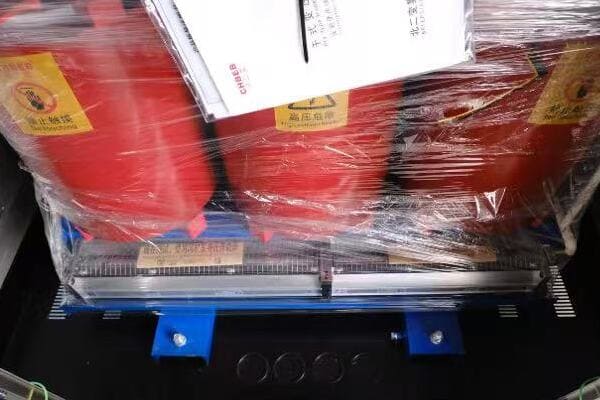
Essential Certification and Safety Checklist
Use this checklist to verify your transformer’s compliance:
✅ IEC 60076-11 compliance
✅ CE/UL/ISO certification
✅ RoHS & fire safety class
✅ Type test report availability
Let’s dive deeper into each of these critical compliance areas:
IEC 60076-11 Compliance
This international standard is specific to dry-type transformers:
- Covers design, testing, and application guidelines.
- Ensures global compatibility and quality standards.
I recall a project where a client initially considered a non-IEC compliant transformer to save costs. We demonstrated how IEC compliance not only ensured better quality but also simplified future maintenance and parts replacement, ultimately convincing them to choose a compliant model.
CE/UL/ISO Certification
These certifications are crucial for different markets and applications:
- CE: Essential for European markets, indicates compliance with EU health, safety, and environmental standards.
- UL: Important for North American markets, focuses on product safety.
- ISO: Demonstrates quality management in manufacturing processes.
In a recent global project, having transformers with both CE and UL certifications allowed for seamless deployment across multiple countries, saving time and reducing compliance headaches.
RoHS and Fire Safety Class
These standards address specific safety and environmental concerns:
- RoHS: Ensures the transformer is free from hazardous substances.
- Fire safety classes (e.g., F1, E2, C2): Indicate the transformer’s behavior under fire conditions.
For a data center project, selecting transformers with high fire safety class ratings was crucial. It not only met stringent building codes but also reduced insurance costs for the client.
Type Test Report Availability
Type test reports provide crucial performance and safety data:
- Verify the transformer’s performance under various conditions.
- Include tests for temperature rise, short circuit withstand, and noise levels.
I always advise clients to review these reports thoroughly. In one case, this careful review revealed that a transformer, while meeting basic specifications, wouldn’t perform optimally under the specific high-altitude conditions of the installation site, leading us to select a more suitable model.
Additional Compliance Considerations
Consider these additional factors for comprehensive compliance:
- Local regulations: Some regions may have specific requirements beyond international standards.
- Industry-specific standards: Certain industries (e.g., healthcare, military) may have additional compliance needs.
- Environmental certifications: Increasingly important for green building projects and corporate sustainability goals.
Here’s a quick reference table for compliance requirements:
| Compliance Area | Importance | Key Benefit |
|---|---|---|
| IEC 60076-11 | Critical | Ensures global quality standards |
| CE Certification | Essential for EU | Demonstrates EU safety compliance |
| UL Certification | Critical for NA | Indicates product safety for North America |
| ISO Certification | Important | Verifies quality manufacturing processes |
| RoHS Compliance | Environmental | Ensures absence of hazardous substances |
| Fire Safety Class | Safety Critical | Determines behavior under fire conditions |
| Type Test Reports | Verification | Provides performance and safety data |
By ensuring your chosen transformer meets these certification and safety compliance standards, you not only guarantee its quality and reliability but also protect your project from potential legal and safety issues. Remember, compliance isn’t just a box-ticking exercise – it’s a crucial step in ensuring the long-term success and safety of your transformer installation.
Budget vs Performance: How to Make the Tradeoff
Are you struggling to balance your budget constraints with the need for high-performance transformers? You’re not alone. Many project managers find themselves torn between cost-saving measures and ensuring optimal system performance. But what if you could find the sweet spot that offers the best value for your investment?
Balancing budget and performance in dry type transformer selection involves considering initial costs against lifecycle expenses, evaluating energy efficiency for long-term savings, assessing maintenance requirements, and weighing customization needs. The goal is to find a solution that offers the best total cost of ownership while meeting performance requirements.
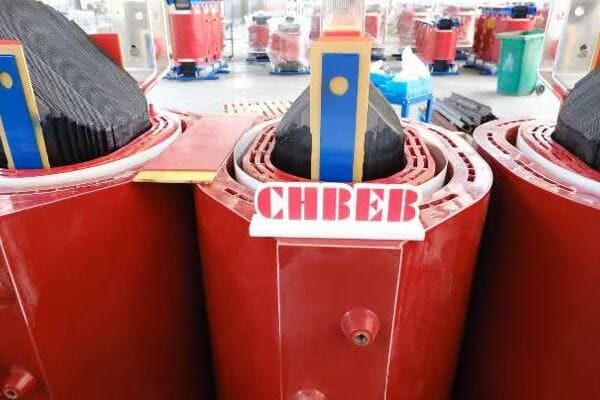
Key Factors in the Budget-Performance Balance
Let’s explore the critical aspects to consider:
- Initial cost vs lifecycle cost
- Energy efficiency ROI
- Maintenance & spare parts availability
- Customization flexibility
Initial Cost vs Lifecycle Cost
While the upfront price is important, it’s crucial to consider the total cost of ownership:
- Initial cost: Includes purchase price and installation.
- Lifecycle cost: Encompasses energy consumption, maintenance, and potential replacements.
I once worked with a client who initially opted for the cheapest transformer option. However, after we conducted a 20-year lifecycle cost analysis, they realized that a more expensive, higher-efficiency model would actually save them money in the long run due to lower energy losses.
Energy Efficiency ROI
Investing in energy-efficient transformers can lead to significant long-term savings:
- Higher efficiency models cost more upfront but consume less energy over time.
- ROI calculation should consider local electricity rates and expected load profiles.
In a recent industrial project, we chose a transformer with 20% lower losses than the standard model. The extra cost was recovered in just 3 years through energy savings, with substantial benefits accruing over the transformer’s 25-year lifespan.#### Maintenance & Spare Parts Availability
Consider the long-term costs and implications of maintenance:
- Lower-cost transformers might require more frequent maintenance or have shorter lifespans.
- Availability and cost of spare parts can significantly impact long-term expenses.
I recall a project where a client chose a less common transformer model to save on initial costs. However, when a critical component failed, the long lead time for spare parts resulted in costly downtime that far exceeded the initial savings.
Customization Flexibility
Sometimes, paying more for a customized solution can be more cost-effective:
- Standard models might require expensive modifications to fit specific needs.
- Custom solutions can optimize performance for unique environments or load profiles.
In a recent renewable energy project, we opted for a slightly more expensive custom-designed transformer. This decision allowed for better integration with the variable load profile of wind turbines, ultimately improving overall system efficiency and reducing operational costs.
Making the Right Decision
To help you make an informed decision, consider the following steps:
-
Calculate Total Cost of Ownership (TCO):
- Include initial cost, energy losses, maintenance, and expected lifespan.
- Use this formula: TCO = Initial Cost + (Annual Energy Cost + Annual Maintenance Cost) × Expected Lifespan
-
Evaluate Energy Efficiency:
- Compare annual energy costs of different models.
- Consider future energy price trends in your calculations.
-
Assess Maintenance Requirements:
- Factor in the cost and frequency of required maintenance.
- Consider the availability and cost of spare parts.
-
Consider Future Needs:
- Will your load requirements change over time?
- Is there potential for system expansion?
-
Analyze Environmental Impact:
- More efficient transformers have a lower carbon footprint.
- Some regions offer incentives for energy-efficient choices.
Here’s a comparison table to help visualize the tradeoffs:
| Factor | Economy Model | Mid-Range Model | High-Performance Model |
|---|---|---|---|
| Initial Cost | Low | Medium | High |
| Energy Efficiency | Basic | Good | Excellent |
| Maintenance Needs | Frequent | Moderate | Minimal |
| Customization | Limited | Some Options | Highly Flexible |
| Lifespan | Shorter | Average | Longer |
| Best For | Short-term projects, budget constraints | Balanced performance and cost | Long-term efficiency, specific needs |
Remember, the cheapest option isn’t always the most cost-effective in the long run. By carefully considering these factors and calculating the total cost of ownership, you can make a decision that balances your budget constraints with performance needs, ensuring the best value for your investment over the transformer’s entire lifespan.
Need Help Choosing?
Are you still feeling uncertain about which dry type transformer is best for your project? Don’t worry – you’re not alone in this complex decision-making process. But what if you could get expert guidance tailored specifically to your project’s unique requirements?
Selecting the right dry type transformer involves balancing numerous factors including application environment, technical specifications, compliance requirements, and budget constraints. Our team of experienced engineers can provide personalized recommendations based on your specific project needs, ensuring you get the optimal solution for your industrial, commercial, or renewable energy application.
How We Can Help
At chbeb-ele, we understand that every project is unique. That’s why we offer personalized consultation services to help you make the best choice. Here’s how we can assist:
-
Project Assessment:
- We’ll analyze your specific application requirements.
- Our team will consider factors like load profile, environmental conditions, and space constraints.
-
Technical Matching:
- We’ll match your needs with the most suitable transformer specifications.
- Our recommendations will balance performance, efficiency, and cost-effectiveness.
-
Compliance Verification:
- We’ll ensure all recommended options meet relevant safety and regulatory standards.
- Our team stays up-to-date with the latest industry certifications and requirements.
-
Cost-Benefit Analysis:
- We’ll provide a detailed comparison of initial costs vs. long-term benefits.
- Our analysis will help you understand the total cost of ownership for different options.
-
Custom Solutions:
- If standard options don’t fit, we can explore custom-designed transformers.
- Our engineering team can develop tailored solutions for unique project needs.
Why Choose Our Expertise?
- Decades of Industry Experience: Our team has worked on diverse projects across industrial, commercial, and renewable energy sectors.
- Up-to-Date Knowledge: We stay current with the latest transformer technologies and industry trends.
- Unbiased Recommendations: We’re not tied to any single manufacturer, ensuring you get the best solution, not just the most profitable for us.
- Post-Selection Support: Our assistance doesn’t end with your purchase – we offer ongoing support for installation and maintenance queries.
Take the Next Step
Don’t let uncertainty hold your project back. Reach out to us for expert guidance on selecting the perfect dry type transformer for your needs.
📩 Get a Tailored Recommendation:
Contact our engineering team today for a custom transformer selection consultation. We’ll help you find a solution that saves energy, reduces risk, and extends equipment life – all while meeting your budget requirements.
🔍 What to Prepare:
To make the most of our consultation, have the following information ready:
- Project type and location
- Expected load profile and capacity requirements
- Environmental conditions of the installation site
- Any specific compliance or certification needs
- Budget constraints and long-term operational goals
Remember, the right transformer choice can significantly impact your project’s success, efficiency, and long-term costs. Let our expertise guide you to the best decision for your unique needs.
Conclusion
Selecting the right dry type transformer is crucial for project success. Consider your application environment, key technical parameters, project category, safety compliance, and budget-performance balance. By carefully evaluating these factors and seeking expert advice when needed, you can ensure optimal performance, efficiency, and longevity for your transformer installation.
I believe that sharing knowledge is crucial in this rapidly changing field. That’s why I’m committed to providing accessible, in-depth information about power systems, including topics like transformer selection and application. My goal is to help professionals like Jacky, an experienced electrical engineering designer, stay updated on the latest developments and best practices in power equipment design and application.
At chbeb-ele, we’re dedicated to empowering a secure, clean, and efficient energy future. We continue to share our knowledge and insights, building a community of informed professionals who can contribute to shaping the future of energy systems.
I encourage you to explore more of our content, engage with our community, and share your own experiences. Together, we can work towards more efficient, reliable, and sustainable energy solutions.
Thank you for joining me in this exploration of dry type transformer selection. Stay curious, stay informed, and let’s keep pushing the boundaries of what’s possible in power distribution and electrical engineering.
Remember, at chbeb-ele, we’re not just sharing information – we’re empowering you to be part of the solution in creating a secure, clean, and efficient energy future. Let’s continue this journey together.
Dry-type transformers use three common cooling systems: AN (Air Natural), AF (Air Forced), and ANAF (a hybrid of both). AN uses passive airflow, AF employs fans for enhanced cooling, while ANAF combines both approaches for optimal efficiency. Selecting the right method depends on factors such as load requirements, environment, and maintenance capabilities.
Are you struggling to choose the right cooling method for your dry-type transformer? Many engineers find this decision challenging, but understanding your options can lead to optimal performance and longevity.

In this comprehensive guide, we’ll explore various cooling methods for dry-type transformers, from basic natural air cooling to advanced hybrid systems. Whether you’re designing a new electrical system or upgrading an existing one, this article will help you make an informed decision about the best cooling method for your transformer.
The Importance of Cooling in Dry-Type Transformers
Proper cooling is crucial for the performance and longevity of dry-type transformers. Without effective heat dissipation, transformers can suffer from reduced efficiency, shortened lifespan, and potential failure.
Cooling systems in dry-type transformers manage heat generated during operation. Effective cooling prevents insulation degradation, maintains efficiency, and extends service life. The choice of cooling method impacts performance, installation options, maintenance needs, and safety compliance.

Key Factors Influenced by Cooling Efficiency
- Operational Performance
- Transformer Lifespan
- Installation Flexibility
- Maintenance Requirements
- Safety and Compliance
Impact on Performance and Lifespan
Effective cooling systems:
- Maintain optimal operating temperature
- Prevent hotspots in windings
- Ensure consistent performance under varying loads
💡 Project Insight: In a recent data center upgrade, replacing an undersized cooling system increased transformer efficiency by 15% and extended its projected lifespan by a decade.
Installation and Maintenance Considerations
The choice of cooling method affects:
- Space requirements for installation
- Noise levels in the surrounding area
- Maintenance schedules and costs
🔍 Field Example: For a remote industrial site, we chose AN cooling despite its lower capacity because the minimal maintenance requirements were crucial for the location’s limited access.
AN Cooling – Air Natural System Explained
AN (Air Natural) cooling is the most basic method for dry-type transformers, relying on passive airflow for heat dissipation.
AN cooling uses natural convection to dissipate heat. Hot air rises from the transformer, creating airflow that cools the unit. This method is ideal for indoor environments with low to medium loads, offering silent operation and minimal maintenance.
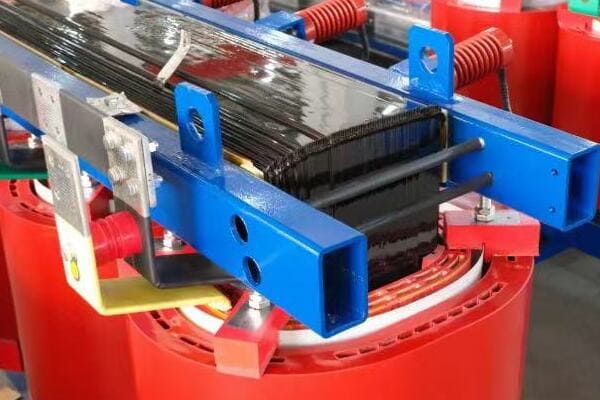
Key Features of AN Cooling
- No fans or moving parts
- Silent operation
- Minimal maintenance requirements
- Suitable for clean, indoor environments
Advantages and Limitations
| Advantages | Limitations |
|---|---|
| Silent operation | Limited cooling capacity |
| Low maintenance | Not suitable for high ambient temperatures |
| Lower initial cost | Requires adequate space for air circulation |
💡 Project Insight: In a multi-story office complex, we installed AN-cooled transformers on each floor. The absence of fans meant zero noise pollution, crucial for the working environment.
AF Cooling – Air Forced System Explained
AF (Air Forced) cooling enhances heat dissipation in dry-type transformers through the use of fans.
AF cooling uses fans to force air over windings, boosting heat removal for higher load capacity. This method is ideal for compact installations or environments with higher ambient temperatures.

Key Features of AF Cooling
- Active air circulation via fans
- Higher cooling capacity than AN systems
- Ability to handle greater loads and power densities
- Adaptable to varying load conditions
Advantages and Limitations
| Advantages | Limitations |
|---|---|
| Higher cooling capacity | Requires regular maintenance |
| Compact installation possible | Generates operational noise |
| Handles variable loads | Higher energy consumption |
🔍 Field Example: In a manufacturing plant upgrade, replacing AN-cooled transformers with AF units allowed for a 30% increase in production equipment without expanding the electrical room.
Advanced Cooling Methods – ANAF, ANCF and More
Advanced cooling methods combine the benefits of different approaches to meet complex transformer needs.
ANAF (Air Natural, Air Forced) and ANCF (Air Natural, Closed-loop Forced) are hybrid cooling systems. ANAF switches between passive and active cooling based on load, while ANCF uses sealed air channels for harsh environments. These methods offer enhanced performance and adaptability.
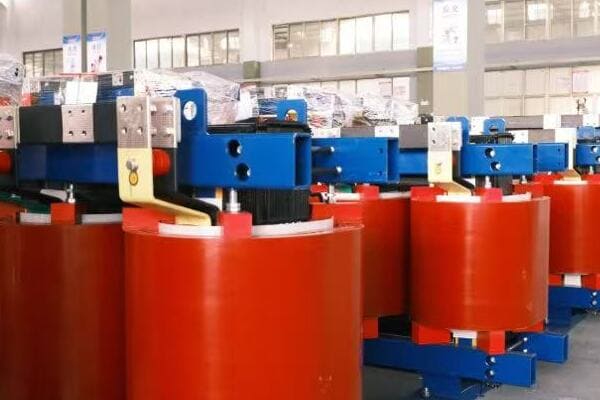
Types of Advanced Cooling Systems
- ANAF (Air Natural, Air Forced)
- ANCF (Air Natural, Closed-loop Forced)
- Heat pipe assisted cooling
- Phase change material (PCM) integration
Advantages of Advanced Cooling Methods
- Adaptability to varying load conditions
- Enhanced protection in harsh environments
- Improved energy efficiency
- Extended transformer lifespan
💡 Project Insight: For a coastal industrial facility, we implemented an ANCF system to protect against corrosive sea air. This solution increased reliability and reduced maintenance costs significantly.
Comparative Table – AN vs AF vs ANAF
Choosing the right cooling method requires understanding the key differences between systems.
| Feature | AN (Air Natural) | AF (Air Forced) | ANAF (Air Natural, Air Forced) |
|---|---|---|---|
| Cooling Method | Passive airflow | Fan-assisted airflow | Hybrid (passive + active) |
| Cooling Efficiency | Low to Moderate | High | Very High |
| Noise Level | Silent | Moderate | Low to Moderate |
| Maintenance | Very low | Medium | Medium to High |
| Load Capacity | Low to Medium | High | Very High |
| Ideal Application | Indoor, low load | Industrial, mid-load | Variable load, harsh conditions |
Selecting the Optimal Cooling System for Your Project
Selecting the appropriate cooling system is crucial for optimal transformer performance.
Cooling System Selection Checklist
Before choosing a cooling system, evaluate these key parameters for your project:
Checklist for Cooling Selection:
- ✅ Installation environment (indoor/outdoor)
- ✅ Load profile (stable/variable)
- ✅ Ambient conditions (temperature, humidity, contaminants)
- ✅ Noise restrictions
- ✅ Maintenance capabilities
- ✅ Energy efficiency requirements
- ✅ Budget constraints
Decision Matrix for Cooling System Selection
| Factor | Favors AN | Favors AF | Favors ANAF |
|---|---|---|---|
| Environment | Indoor, clean | Outdoor, variable | Harsh, contaminated |
| Load | Stable, low to medium | High, consistent | Variable, high peaks |
| Noise Concern | High | Low | Moderate |
| Maintenance | Minimal available | Regular possible | Specialized available |
💡 Project Insight: For a data center with variable loads and high efficiency requirements, we chose an ANAF system over standard AF. This decision improved cooling performance and resulted in substantial energy savings over time.
Conclusion: Cooling Efficiency Determines Performance
Choosing the right cooling method for dry-type transformers is crucial for optimal performance and longevity. AN, AF, and ANAF systems each have their strengths for different applications. Consider environmental factors, load profiles, and maintenance capabilities when selecting. The right cooling system ensures efficiency, reliability, and cost-effectiveness in your transformer operations.
📩 Need help selecting a dry-type transformer cooling system?
Contact our experts for a custom AN, AF or hybrid transformer recommendation. Get a tailored recommendation that saves energy, reduces risk, and extends equipment life.
Are you struggling to navigate the complex world of step down transformer applications across different regions? You’re not alone. Many manufacturers and buyers find themselves puzzled by the varying requirements and preferences in North America, Europe, and the Middle East. But what if you could gain a clear understanding of these regional differences and use this knowledge to your advantage?
Step down transformer applications vary significantly across North America, Europe, and the Middle East due to differences in grid standards, environmental conditions, and regulatory requirements. North America focuses on utility applications with UL standards, Europe prioritizes energy efficiency and indoor safety, while the Middle East demands high capacity and climate-adapted solutions.

In this comprehensive guide, I’ll walk you through the key differences in step down transformer applications across these three major markets. Whether you’re a manufacturer looking to expand globally or a buyer seeking the best sourcing strategy, this article will provide you with valuable insights to make informed decisions in the diverse world of power distribution.
Why Regional Applications of Step Down Transformers Differ?
Have you ever wondered why a transformer that works perfectly in one country might be unsuitable in another? You’re not alone. Many industry professionals are puzzled by these regional variations. But what exactly causes these differences, and why are they so important to understand?
**Regional applications of step down transformers differ due to variations in:
- Grid frequency and voltage standards
- Environmental conditions and climate challenges
- Regulatory frameworks and safety standards
- Local market demands and project types
Understanding these factors is crucial for successful transformer deployment across different regions.**

Diving Deeper into Regional Transformer Differences
Let’s explore the key factors that contribute to these regional variations:
1. Grid Frequency and Voltage Standards
Different regions have adopted different electrical standards:
- North America: 60 Hz frequency, common voltages include 13.2kV and 34.5kV
- Europe and Middle East: 50 Hz frequency, typical voltages are 11kV and 22kV
I once worked on a project where a European manufacturer tried to enter the North American market without properly adapting their 50 Hz designs. The result was overheating issues and efficiency losses, highlighting the critical importance of understanding these fundamental differences.
2. Environmental and Climate Challenges
Each region presents unique environmental considerations:
- North America: Wide range of climates, from arctic to subtropical
- Europe: Generally temperate, with focus on urban environments
- Middle East: Extreme heat, sand, and dust challenges
3. Regulatory Frameworks and Safety Standards
Compliance requirements vary significantly:
- North America: ANSI C57 series and UL certification
- Europe: IEC standards and EcoDesign Directive
- Middle East: Often a mix of IEC and region-specific standards
4. Local Market Demands and Project Types
Typical applications differ across regions:
- North America: Focus on utility-scale and industrial applications
- Europe: Emphasis on urban distribution and renewable energy integration
- Middle East: Large infrastructure projects and oil & gas industry needs
Here’s a comparison table of these regional factors:
| Factor | North America | Europe | Middle East |
|---|---|---|---|
| Frequency | 60 Hz | 50 Hz | 50 Hz |
| Common Voltages | 13.2kV, 34.5kV | 11kV, 22kV | 11kV-33kV |
| Key Standards | ANSI C57, UL | IEC, EcoDesign | IEC, BS |
| Environmental Focus | Diverse climates | Urban, indoor | Extreme heat, dust |
| Typical Applications | Utility, industrial | Urban distribution, renewables | Infrastructure, oil & gas |
In my experience, understanding these regional differences is crucial for successful international projects. I recall a case where a Middle Eastern client initially specified European-style dry-type transformers for a large industrial complex. After a thorough analysis of the local conditions, including extreme temperatures and dusty environment, we recommended oil-immersed units with specialized cooling systems. This adaptation to regional needs significantly improved the project’s long-term reliability.
The impact of regulatory frameworks on transformer design and selection cannot be overstated. In a recent project for a multinational corporation, we had to navigate the complexities of meeting both North American UL requirements and European EcoDesign standards for a global product line. This experience highlighted the need for a flexible design approach that can accommodate diverse regional regulations.
Environmental considerations often lead to innovative solutions. In a project in the Middle East, we developed a hybrid cooling system for step-down transformers that combined the efficiency of oil-immersion with advanced air-cooling technology. This design addressed the challenges of extreme heat while meeting the high-capacity needs of the region’s rapidly growing infrastructure.
The trend towards renewable energy integration is shaping transformer requirements differently across regions. In Europe, I’ve seen a growing demand for compact, eco-friendly transformers suitable for urban solar installations and wind farms. In contrast, North American projects often require larger, utility-scale units for expansive solar and wind projects.
Lastly, the increasing focus on smart grid technologies is adding another layer of complexity to regional differences. In a recent European project, we integrated advanced monitoring and communication capabilities into medium-voltage transformers to support grid optimization. The same level of smart functionality was not required in a similar Middle Eastern project, where robustness and cooling efficiency were the primary concerns.
Understanding these regional differences in step down transformer applications is essential for anyone involved in the global power industry. Whether you’re designing, manufacturing, or procuring transformers, recognizing how grid standards, environmental conditions, regulations, and market demands vary across North America, Europe, and the Middle East is crucial for project success. By appreciating these nuances, you can better adapt your strategies, products, or specifications to meet the unique needs of each market, ensuring optimal performance and compliance in diverse global settings.
North America – Utility-Focused and UL-Driven Market?
Are you finding it challenging to navigate the North American transformer market? You’re not alone. Many manufacturers and suppliers struggle to meet the specific requirements of this region. But what exactly makes the North American market unique, and how can you position yourself for success in this demanding environment?
**The North American step down transformer market is characterized by:
- 60Hz frequency standard
- Common voltages: 13.2kV / 34.5kV
- ANSI C57 and UL certification requirements
- Focus on utility applications, data centers, and industrial distribution
- Preference for pad-mounted and pole-mounted step-down types
These factors create a utility-focused, UL-driven market with stringent safety and reliability standards.**
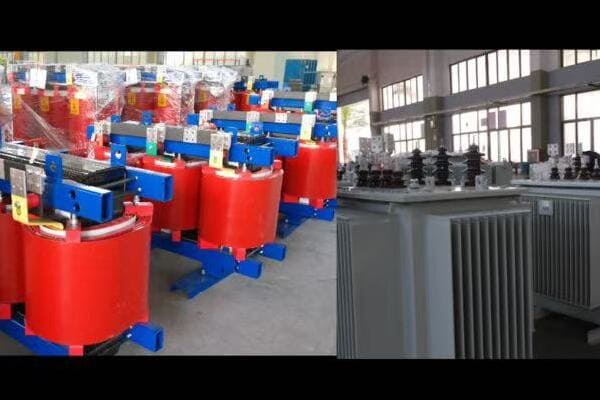
Exploring the North American Transformer Market
Let’s dive deeper into the key aspects that define the North American step down transformer market:
1. Technical Standards and Certifications
North America has distinct technical requirements:
- 60Hz frequency (unlike the 50Hz standard in many other countries)
- ANSI C57 series standards for transformer design and testing
- UL (Underwriters Laboratories) certification for safety
I once worked with a European manufacturer trying to enter the U.S. market. Their biggest challenge was adapting their 50Hz designs to meet 60Hz requirements while also obtaining UL certification. It was a complex process, but crucial for market entry.
2. Key Market Segments
Major buyers in the North American market include:
- Public and private utility companies
- Data centers and tech companies
- Industrial facilities
- Renewable energy projects
3. Product Preferences
Popular transformer types in North America:
- Pad-mounted transformers for urban and suburban distribution
- Pole-mounted transformers for rural areas
- Liquid-filled units for utility-scale applications
- Dry-type transformers for indoor and sensitive environments
4. Regulatory and Environmental Considerations
Unique aspects of the North American market:
- Strict environmental regulations (e.g., PCB-free oil requirements)
- Energy efficiency standards (DOE efficiency levels)
- Seismic design requirements in certain regions
Here’s a breakdown of typical North American transformer applications:
| Application | Typical Voltage | Preferred Type | Key Requirement |
|---|---|---|---|
| Utility Distribution | 34.5kV / 13.2kV | Pad-mounted | High reliability |
| Data Centers | 34.5kV / 480V | Dry-type | High efficiency |
| Industrial | 13.2kV / 480V | Liquid-filled | Overload capacity |
| Renewable Energy | 34.5kV / 13.2kV | Pad-mounted | Smart grid compatibility |
In my experience, success in the North American market often hinges on understanding and meeting these stringent standards. I recall a project where a non-North American manufacturer lost a major utility contract because their transformers, while high-quality, didn’t fully comply with specific ANSI and UL requirements. This experience underscored the importance of thorough market research and product adaptation.
The focus on energy efficiency in the North American market is intensifying. I recently consulted on a data center project where the client specified transformers that exceeded the Department of Energy’s efficiency standards. This trend towards high-efficiency units is driven by both regulatory pressures and the desire to reduce operational costs over the transformer’s lifetime.
Safety considerations are paramount in the North American market. In a recent industrial project, we had to redesign the transformer installation to meet stringent fire safety codes specific to the local jurisdiction. This level of attention to safety and compliance is typical in North America and can significantly impact project timelines and costs.
The growing renewable energy sector is creating new demands in the North American transformer market. I’m currently involved in a large-scale solar farm project where the transformers need to handle variable loads and integrate with advanced grid management systems. This has led to innovations in transformer design, particularly in smart monitoring and control capabilities.
Lastly, the trend towards grid modernization is influencing transformer specifications in North America. Utilities are increasingly demanding transformers with built-in monitoring and communication capabilities. In a recent grid upgrade project, the ability to integrate transformers with advanced asset management systems was a key selection criterion, highlighting the growing importance of "smart" features in the North American market.
The North American step down transformer market, with its focus on utility applications and UL-driven standards, presents both challenges and opportunities for manufacturers and suppliers. Success in this market requires a deep understanding of technical standards, a commitment to safety and reliability, and the ability to provide innovative solutions that meet the evolving needs of utilities, data centers, and the growing renewable energy sector. For those who can navigate these requirements, the North American market offers a stable, high-value environment with significant opportunities for growth and technological advancement.
Europe – Energy Efficiency and Indoor Fire Safety Drive Demand?
Are you finding it challenging to keep up with the evolving European transformer market? You’re not alone. Many manufacturers and suppliers struggle to meet Europe’s stringent energy efficiency standards and fire safety regulations. But what exactly makes the European market unique, and how can you turn these challenges into opportunities?
**The European step down transformer market is characterized by:
- 50Hz frequency standard
- Common voltages: 11kV / 22kV
- IEC 60076 and EcoDesign Directive compliance
- Focus on urban buildings, renewables, and underground systems
- Preference for dry-type and eco-efficient transformers
These factors create a market driven by energy efficiency and indoor fire safety concerns.**

Diving into the European Transformer Market Landscape
Let’s explore the key aspects that define the European step down transformer market:
1. Regulatory Environment
Europe’s transformer market is heavily influenced by regulations:
- IEC (International Electrotechnical Commission) standards
- EU EcoDesign Directive (implementing regulation 548/2014)
- EN 50588-1 for distribution transformers
- Fire safety standards (e.g., F1 class for indoor installations)
I once worked on a project helping a non-European manufacturer adapt their products for the EU market. The most challenging aspect was meeting the stringent efficiency requirements of the EcoDesign Directive. It required significant redesigns but ultimately led to a more competitive product line.
2. Key Market Drivers
Major factors shaping the European market:
- Urban densification and smart city initiatives
- Renewable energy integration
- Grid modernization and energy efficiency goals
- Strict fire safety regulations for indoor installations
3. Product Preferences
Popular transformer types in Europe:
- Dry-type transformers for urban and sensitive environments
- Low-loss amorphous core transformers
- Compact designs for space-constrained urban substations
- Smart transformers with monitoring capabilities
4. Environmental and Safety Considerations
Unique aspects of European transformer requirements:
- Emphasis on total cost of ownership (TCO) including energy losses
- Noise reduction for urban installations
- Use of biodegradable insulating fluids
- Stringent fire safety requirements for indoor transformers
Here’s a breakdown of typical European transformer applications:
| Application | Typical Voltage | Preferred Type | Key Requirement |
|---|---|---|---|
| Urban Distribution | 11kV / 400V | Dry-type | Fire safety, low noise |
| Renewable Integration | 22kV / 400V | Eco-efficient | Smart grid compatibility |
| Industrial | 11kV / 400V | Low-loss liquid-filled | Energy efficiency |
| Commercial Buildings | 11kV / 400V | Cast resin | Fire resistance |
In my experience, success in the European market often hinges on a company’s ability to innovate in energy efficiency and environmental sustainability. I recall a project where we introduced a new line of ultra-low-loss transformers. Despite the higher initial cost, these units were highly successful due to their lower total cost of ownership, aligning perfectly with European buyers’ long-term perspective.
The push for smart grid technologies is reshaping the European transformer market. In a recent project for a major utility in Germany, we implemented transformers with advanced monitoring and communication capabilities. This trend towards "smart transformers" is rapidly becoming the norm, driven by the need for more flexible and responsive grid management.
Fire safety considerations are paramount, especially in urban environments. I recently consulted on a project for a high-rise building in Paris where the fire safety regulations necessitated the use of F1 class dry-type transformers. This requirement, common in many European cities, is driving innovation in transformer design for indoor applications.
The renewable energy sector is a major driver of innovation in the European transformer market. In a wind farm project off the coast of Denmark, we faced unique challenges in designing transformers that could handle the variable loads typical of wind power while meeting strict efficiency standards. This project exemplified the kind of specialized solutions that are increasingly in demand across Europe.
Lastly, the trend towards circular economy principles is influencing transformer design and procurement in Europe. I’m currently advising on a project where the client is specifically requesting transformers with high recyclability and using eco-friendly materials. This focus on lifecycle environmental impact is becoming increasingly common and is shaping the future of transformer technology in Europe.
The European step down transformer market, with its focus on energy efficiency and indoor fire safety, presents a unique landscape of challenges and opportunities. Success in this market requires a commitment to environmental sustainability, technological innovation, and a deep understanding of complex regulatory requirements. For manufacturers and suppliers who can meet these high standards, Europe offers a sophisticated market with a strong emphasis on quality, efficiency, and long-term value. As the continent continues its transition towards a more sustainable and intelligent energy infrastructure, the demand for advanced, efficient, and environmentally friendly transformer solutions will only grow.
Middle East – High Capacity + Harsh Climate Adaptation?
Are you grappling with the unique challenges of supplying transformers to the Middle East market? You’re not alone. Many manufacturers find themselves struggling to meet the demanding requirements of this region. But what exactly makes the Middle Eastern market so distinct, and how can you adapt your products to excel in this challenging environment?
**The Middle Eastern step down transformer market is characterized by:
- 50Hz frequency standard
- Common voltages: 11kV–33kV
- Need for adaptation to extreme heat and sandy conditions
- Focus on high-capacity units for oil & gas, infrastructure megaprojects, and desalination plants
- Preference for oil-immersed step-down transformers with IP-rated enclosures
These factors create a market demanding robust, high-capacity transformers capable of withstanding harsh environmental conditions.**
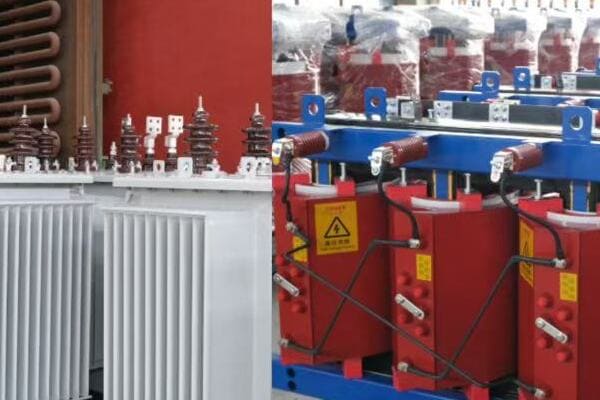
Exploring the Middle Eastern Transformer Market
Let’s dive deeper into the key aspects that define the Middle Eastern step down transformer market:
1. Environmental Challenges
The Middle East presents unique environmental hurdles:
- Extreme heat (often exceeding 50°C/122°F)
- Sand and dust accumulation
- High humidity in coastal areas
- Corrosive atmospheres in industrial zones
I once worked on a project for a large oil refinery in Saudi Arabia where standard transformers were failing due to the extreme heat and sand ingress. We had to completely redesign the cooling system and develop specialized filters to ensure reliable operation in these harsh conditions.
2. Key Market Segments
Major buyers in the Middle Eastern market include:
- Oil and gas industry
- Large-scale infrastructure projects
- Desalination plants
- Rapidly growing urban developments
3. Product RequirementsPopular transformer features in the Middle East:
- High-capacity oil-immersed units
- Enhanced cooling systems (ONAF, OFAF)
- IP55 or higher-rated enclosures for dust and sand protection
- Corrosion-resistant materials and coatings
- Smart monitoring systems for remote locations
4. Regulatory and Technical Considerations
Unique aspects of the Middle Eastern market:
- Mix of IEC and region-specific standards
- Emphasis on reliability and minimal downtime
- Growing focus on energy efficiency (especially in UAE and Saudi Arabia)
- Increasing demand for smart grid compatibility
Here’s a breakdown of typical Middle Eastern transformer applications:
| Application | Typical Voltage | Preferred Type | Key Requirement |
|---|---|---|---|
| Oil & Gas | 33kV / 11kV | Oil-immersed | Explosion-proof |
| Desalination | 33kV / 6.6kV | Oil-immersed | Corrosion resistance |
| Urban Infrastructure | 11kV / 400V | Dry-type (indoor) | Fire safety |
| Industrial | 33kV / 11kV | Oil-immersed | High capacity |
In my experience, success in the Middle Eastern market often hinges on a manufacturer’s ability to adapt to extreme environmental conditions. I recall a project for a major offshore oil platform where standard transformers were failing within months due to the combination of heat, humidity, and salt spray. We developed a custom-designed transformer with enhanced cooling, specialized insulation, and a robust enclosure. This unit not only survived but thrived in the harsh conditions, operating reliably for years.
The demand for high-capacity transformers in the Middle East is driven by massive infrastructure projects. I recently consulted on a new city development in the UAE where the power requirements were staggering. We had to design and implement a network of high-capacity transformers capable of handling not just current needs but also projected future growth. This forward-thinking approach is typical in the region’s fast-paced development landscape.
Energy efficiency is becoming an increasingly important factor, even in oil-rich nations. In a recent project in Qatar, we were tasked with upgrading an existing power distribution network with more efficient transformers. The focus was on reducing energy losses and operational costs, reflecting a growing awareness of energy conservation in the region.
The integration of renewable energy sources, particularly solar, is creating new challenges and opportunities. I’m currently involved in a large-scale solar farm project in the UAE where we’re developing specialized transformers to handle the variable loads and harsh desert conditions. These units need to combine high efficiency with robust design to withstand sand, heat, and UV radiation.
Smart grid technologies are also gaining traction in the Middle East. In a recent project for a new industrial city in Saudi Arabia, we implemented a network of smart transformers with advanced monitoring and control capabilities. This system allows for real-time load management and predictive maintenance, crucial in a region where downtime can be extremely costly.
Lastly, the trend towards urbanization and the development of "smart cities" is influencing transformer requirements. In projects like Dubai’s Smart City initiative, we’re seeing increased demand for compact, low-noise transformers suitable for urban environments. These units need to combine the robustness required for the Middle Eastern climate with the aesthetic and noise considerations of modern urban planning.
The Middle Eastern step down transformer market, with its focus on high capacity and harsh climate adaptation, presents unique challenges and opportunities. Success in this market requires a deep understanding of environmental factors, a commitment to reliability and efficiency, and the ability to provide innovative solutions that meet the evolving needs of rapidly developing economies. For manufacturers who can meet these demanding requirements, the Middle East offers a dynamic and growing market with significant opportunities for technological advancement and business growth.
Comparative Table – Regional Transformer Preferences at a Glance?
Are you finding it challenging to keep track of the different transformer preferences across North America, Europe, and the Middle East? You’re not alone. Many professionals struggle with the complexity of regional variations. But what if you had a clear, comprehensive comparison of these critical factors at your fingertips?
This comparative table provides a concise overview of key transformer preferences in North America, Europe, and the Middle East. It highlights differences in frequency, standards, typical products, and application focus, offering valuable insights for manufacturers and buyers navigating these diverse markets.
Detailed Comparison of Regional Transformer Preferences
Let’s break down the key characteristics of transformer preferences in these major markets:
| Region | Frequency | Standard | Typical Product | Application Focus |
|---|---|---|---|---|
| North America | 60 Hz | ANSI / UL | Pad-mounted, outdoor type | Utilities, data centers |
| Europe | 50 Hz | IEC, EcoDir | Dry-type, low loss units | Smart grid, city buildings |
| Middle East | 50 Hz | IEC / BS | Oil-immersed, sealed units | Oil & gas, high-load systems |
This table encapsulates years of experience and countless projects I’ve been involved with across these regions. Let me share some insights on how these differences play out in real-world scenarios.
Frequency Standards
The difference between 60 Hz in North America and 50 Hz in Europe and the Middle East is more than just a number. I once worked on a project where a European manufacturer tried to enter the U.S. market without properly adapting their 50 Hz designs. The result was overheating issues and efficiency losses. This experience underscored the critical importance of frequency considerations in transformer design and selection.
Certification and Standards
The regulatory landscape varies significantly:
- North America: ANSI standards focus on reliability and safety, with UL certification being crucial for many applications.
- Europe: IEC standards are prevalent, with the additional layer of EcoDesign requirements pushing for higher efficiency.
- Middle East: While IEC standards are common, there’s often a mix with British Standards (BS) and region-specific requirements.
I recall a project where we had to redesign a transformer line to meet the stringent efficiency requirements of the European EcoDesign directive. While challenging, this process ultimately led to innovations that improved our products globally.
Typical Products
Product preferences reflect local conditions and priorities:
- North America: Pad-mounted transformers are popular for their compact design and suitability for outdoor environments.
- Europe: Dry-type, low-loss transformers are favored, aligning with the region’s focus on energy efficiency and fire safety in urban areas.
- Middle East: Oil-immersed, sealed units dominate due to their ability to withstand extreme heat and dusty conditions.
In a recent project in the UAE, we found that while there was interest in dry-type transformers for certain indoor applications, oil-immersed units still dominated due to their superior cooling capabilities in the harsh desert climate.
Application Focus
Each region has its primary focus:
- North America: Utilities and data centers drive much of the demand, reflecting the region’s advanced power grid and digital infrastructure.
- Europe: Smart grid integration and urban building applications are key, driven by the push for energy efficiency and sustainable urban development.
- Middle East: Oil & gas industry needs and high-load systems for massive infrastructure projects shape the market.
I’ve seen these focuses shape project outcomes significantly. In a European smart grid project, the client was willing to pay a premium for ultra-high efficiency transformers with advanced monitoring capabilities, citing long-term energy savings and grid optimization as justification.
Emerging Trends
It’s worth noting some emerging trends that are beginning to influence these regional preferences:
- Renewable Energy Integration: All regions are seeing increased demand for transformers capable of handling variable loads from renewable sources, though the scale and specific requirements differ.
- Digitalization: The integration of smart monitoring and control features is gaining traction across all markets, albeit at different paces.
- Environmental Considerations: While most pronounced in Europe, environmental factors are increasingly influencing transformer choices in North America and, to a lesser extent, the Middle East.
This comparative table of regional transformer preferences underscores the complexity of the global market. For manufacturers, it highlights the need for adaptable designs and a thorough understanding of regional requirements. For buyers, it emphasizes the importance of specifying the right transformer for their specific location and application.
As we navigate these diverse markets, staying informed about these regional differences and emerging global trends is crucial. Whether you’re a manufacturer looking to expand your market reach or a buyer seeking the best solution for your project, understanding these nuances in transformer preferences is key to making informed decisions in the ever-evolving world of power distribution.
Sourcing & Export Tips for Regional Markets?
Are you finding it challenging to navigate the complexities of sourcing and exporting transformers to different regional markets? You’re not alone. Many manufacturers and suppliers struggle with the diverse requirements and regulations across North America, Europe, and the Middle East. But what if you had a set of proven strategies to help you succeed in these international markets?
**Key sourcing and export tips for regional transformer markets include:
- Align certifications with regional standards (IEC, ANSI, UL, CE)
- Prepare comprehensive test reports and FAT documentation in advance
- Partner with region-aware logistics providers
- Anticipate and plan for varying delivery timelines per region
- Develop region-specific marketing and technical materials
These strategies can significantly improve your success in global transformer markets.**
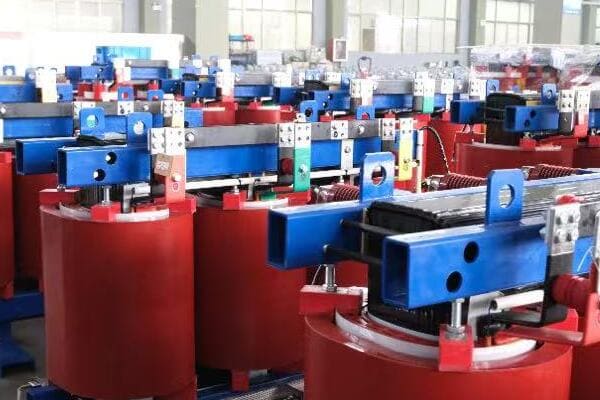
Detailed Sourcing and Export Strategies for Regional Markets
Let’s explore these tips in more depth:
1. Align Certifications with Regional Standards
- For North America: Focus on ANSI C57 series and UL certification
- For Europe: Ensure compliance with IEC standards and CE marking
- For Middle East: Consider both IEC and region-specific certifications (e.g., SASO for Saudi Arabia)
I once worked with a manufacturer who initially struggled in the U.S. market because their transformers were designed solely to IEC standards. After obtaining UL certification and adapting their designs to meet ANSI requirements, their sales in North America increased significantly.
2. Prepare Comprehensive Documentation
- Develop detailed test reports tailored to each region’s requirements
- Prepare Factory Acceptance Test (FAT) protocols in advance
- Create region-specific technical datasheets and user manuals
3. Partner with Region-Aware Logistics Providers
- Choose logistics partners with experience in transformer shipping
- Understand regional import regulations and customs procedures
- Plan for proper handling of oil-filled transformers during transport
4. Anticipate Regional Delivery Timelines
- North America: Plan for longer lead times due to UL certification processes
- Europe: Consider the impact of EcoDesign regulations on production schedules
- Middle East: Factor in potential delays due to customs clearance and local inspections
5. Develop Region-Specific Marketing Materials
- Customize product brochures to highlight features relevant to each market
- Prepare case studies that resonate with regional applications
- Adapt your website and online presence for regional search engines and languages
Here’s a comparison of key export considerations for different regions:
| Export Aspect | North America | Europe | Middle East |
|---|---|---|---|
| Key Certification | UL Listing | CE Marking | IEC + Local Standards |
| Documentation Focus | Safety compliance | Energy efficiency | Reliability in harsh conditions |
| Typical Shipping Method | Container / Flatbed | Container / RoRo | Container / Breakbulk |
| Import Regulations | Strict | Moderate | Varies by country |
| Local Presence Importance | High | Moderate | Very High |
In my experience, successful exporting often comes down to understanding and adapting to local market nuances. I recall a European manufacturer who struggled initially in the Middle Eastern market due to their lack of local representation. After establishing a partnership with a well-connected local distributor, they saw a significant uptick in their project wins and customer satisfaction.
The importance of proper documentation cannot be overstated, especially when dealing with different regulatory environments. In a recent project exporting transformers to North America, we developed a comprehensive UL compliance package that included not just test reports, but also detailed design documentation and material certifications. This proactive approach significantly streamlined the certification process and reduced time-to-market.
Logistics planning is crucial, particularly for large transformers. I worked on a project shipping extra-large transformers to a remote site in the Middle East. By engaging a specialized heavy-lift logistics provider early in the process, we were able to optimize the route, considering factors like road capacities, port facilities, and local transportation regulations. This careful planning prevented costly delays and ensured safe delivery.
Customization of marketing and technical materials for each region can significantly impact your success. In a recent initiative targeting the European market, we developed a series of case studies focusing on eco-efficient transformer installations in urban environments. This targeted approach resonated strongly with European buyers, leading to increased inquiries and sales.
The trend towards digital marketing and virtual product demonstrations is changing how transformers are exported and sold globally. In response to travel restrictions, we recently developed a virtual showroom with 3D models and interactive specifications of our transformer range. This tool proved invaluable for reaching international clients, especially in markets where in-person visits were challenging.
Lastly, staying informed about geopolitical developments and trade agreements is crucial for long-term export success. I’m currently advising several manufacturers on how to navigate changing tariff structures and local content requirements in various markets. Being proactive in understanding and adapting to these macro-level changes can give you a significant competitive advantage.
Exporting transformers successfully to different regional markets requires a combination of technical expertise, market understanding, and strategic planning. By aligning your certifications, preparing comprehensive documentation, partnering with experienced logistics providers, anticipating regional timelines, and developing targeted marketing materials, you can significantly enhance your chances of success in the global transformer market. Remember, exporting is not just about selling a product; it’s about building lasting relationships and establishing your brand in diverse international markets.
Summary: Region-Specific Needs, Global Opportunities?
Are you wondering how to balance regional market specifics with global expansion opportunities in the transformer industry? You’re not alone. Many manufacturers and buyers struggle to navigate the complex interplay between local requirements and global trends. But what if you could turn these regional differences into a strategic advantage in the global market?
The transformer market shows distinct regional characteristics: North America focuses on utility applications and UL standards, Europe prioritizes energy efficiency and indoor safety, while the Middle East emphasizes high capacity and climate adaptation. Understanding these regional nuances is key to identifying global opportunities and developing successful market strategies.
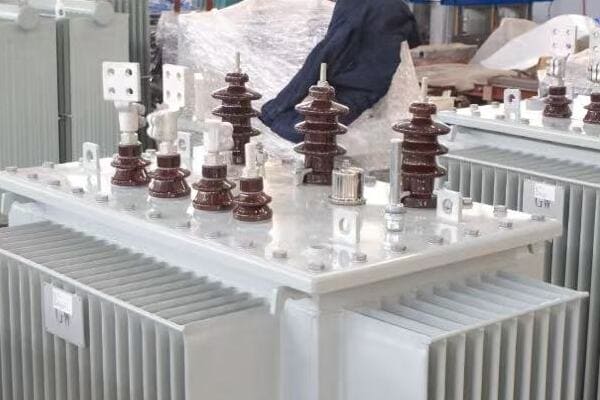
Synthesizing Regional Insights for Global Success
Let’s explore how understanding regional differences can lead to global opportunities:
Leveraging Regional Strengths
Each region offers unique strengths:
- North America: Advanced grid technologies and data center expertise
- Europe: Leadership in energy efficiency and eco-friendly designs
- Middle East: Experience in harsh environment adaptations and high-capacity systems
I once worked with a manufacturer who successfully combined European efficiency standards with Middle Eastern ruggedization techniques to create a highly competitive product line for the global market. This approach allowed them to offer advanced technology with exceptional durability, opening doors in multiple regions.
Cross-Pollination of Technologies
Opportunities arise from applying regional innovations globally:
- Adapting European eco-design principles for North American markets
- Implementing Middle Eastern cooling technologies in hot climate applications worldwide
- Applying North American smart grid solutions in developing markets
Standardization vs. Customization
Balancing global standards with local needs:
- Developing core designs that can be easily adapted to regional requirements
- Creating modular solutions that allow for local customization
- Establishing global quality standards while accommodating regional preferences
In a recent project, I advised a manufacturer on developing a "global platform" for their transformer line. This approach involved creating a standardized core design that could be easily modified to meet different regional standards. The result was a more efficient product development cycle and greater flexibility in addressing diverse market needs.
Navigating Regulatory Landscapes
Turning compliance challenges into opportunities:
- Using stringent European efficiency standards as a benchmark for global quality
- Leveraging North American safety certifications to enhance product credibility worldwide
- Applying lessons from Middle Eastern durability requirements to improve product reliability globally
I recall working with a company that initially saw Europe’s strict efficiency regulations as a barrier. However, by embracing these standards and applying them across their entire product line, they positioned themselves as global leaders in high-efficiency transformers, opening new markets beyond Europe.
Global Trends Shaping Regional Markets
Identifying overarching trends that influence all regions:
- Increasing focus on renewable energy integration
- Growing demand for smart grid technologies
- Rising importance of cybersecurity in power systems
Here’s a comparison of how global trends manifest in different regions:
| Global Trend | North America Impact | Europe Impact | Middle East Impact |
|---|---|---|---|
| Renewable Energy | Large-scale integration | Distributed generation | Emerging solar projects |
| Smart Grid | Advanced analytics | Consumer engagement | Infrastructure modernization |
| Cybersecurity | Critical infrastructure protection | Data privacy focus | Oil & gas sector security |
In my experience, companies that successfully navigate the global transformer market are those that can adapt global trends to regional contexts. For instance, I worked with a manufacturer who developed a range of smart transformers with modular communication interfaces. This allowed them to easily adapt their products to different smart grid standards across regions, from the advanced analytics focus in North America to the consumer engagement emphasis in Europe.
The importance of understanding local business cultures cannot be overstated. I’ve seen cases where technically superior products failed in certain markets due to a lack of cultural alignment in sales and support approaches. Successful global players invest heavily in local market intelligence and relationship-building.
Sustainability is becoming a global driver, but with regional nuances. In Europe, this often translates to stringent efficiency standards and eco-friendly materials. In North America, there’s a growing focus on lifecycle assessment and recyclability. In the Middle East, we’re seeing increased interest in energy-efficient transformers as part of broader urban sustainability initiatives. Companies that can address these varied sustainability concerns are well-positioned for global success.
The trend towards digitalization is creating new opportunities across all regions. I’m currently advising several companies on developing IoT-enabled transformers that can be remotely monitored and managed. While the specific applications vary by region – from grid optimization in North America to predictive maintenance in Europe and rapid fault response in the Middle East – the underlying technology has global appeal.
Lastly, the increasing interconnectedness of global power grids is driving demand for transformers that can operate seamlessly across different standards. I recently worked on a project involving cross-border power transmission between North America and Mexico, which required transformers capable of handling multiple voltage standards and frequencies. This type of project highlights the growing need for flexible, globally-oriented transformer solutions.
In conclusion, success in the global transformer market requires a nuanced understanding of regional differences combined with the ability to identify and leverage global trends. By focusing on regional strengths while maintaining a global perspective, manufacturers and buyers can turn market complexities into strategic advantages. Whether it’s adapting European efficiency standards for Middle Eastern markets, applying North American grid resilience technologies globally, or leveraging Middle Eastern expertise in harsh environment adaptations for other challenging climates, the key lies in seeing regional diversity as an opportunity rather than a challenge.
As we look to the future, those who can balance regional expertise with global vision will be best positioned to capitalize on the evolving opportunities in the worldwide transformer market. Remember, in today’s interconnected world, regional focus and global opportunity are not mutually exclusive – they are complementary strategies for achieving success in the dynamic and diverse global transformer industry.
Conclusion
Understanding regional differences in transformer markets is crucial for global success. North America, Europe, and the Middle East each offer unique challenges and opportunities. By adapting strategies to local needs while leveraging global trends, companies can achieve significant growth and innovation in the diverse world of power distribution.
📩 Need help choosing the right transformer for the U.S., Europe, or Middle East?
Get a tailored recommendation or request a regional compliance quotation today.
Are you struggling to choose between dry and oil-filled step down transformers for your project? You’re not alone. Many engineers and project managers find themselves puzzled by the pros and cons of each type. But what if you could easily identify which transformer is best suited for your specific needs?
Dry and oil step down transformers differ in cooling method, fire risk, maintenance needs, application suitability, and initial cost. Dry types excel in indoor, fire-sensitive environments, while oil-filled units are preferred for outdoor, high-capacity applications. Understanding these differences is crucial for selecting the right transformer for your project.
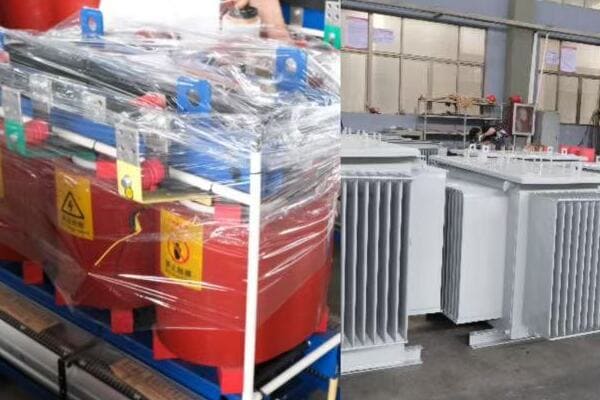
In this comprehensive guide, I’ll walk you through the five key differences between dry and oil step down transformers. We’ll explore their unique characteristics, ideal applications, and how to choose the best option for your specific project requirements. Whether you’re designing a new electrical system or upgrading an existing one, this article will help you make an informed decision.
What Are Step Down Transformers and Where Are They Used?
Have you ever wondered how the high voltage electricity from power lines is converted to a usable level for your home or office? This is where step down transformers come into play. But what exactly are these devices, and in what situations are they crucial?
Step down transformers reduce voltage from a higher to a lower level, making electricity safe and usable for various applications. They are commonly used in power distribution systems, industrial facilities, commercial buildings, and residential areas to convert high transmission voltages to lower, more practical levels.
Diving Deeper into Step Down Transformers
Let’s explore the key aspects of step down transformers:
Function and Importance
Step down transformers serve to:
- Reduce voltage levels for safe distribution and use
- Enable efficient power transmission over long distances
- Provide appropriate voltage levels for different applications
I once worked on a project upgrading a small town’s electrical grid. The role of step down transformers in safely bringing high transmission voltages down to levels suitable for homes and businesses was crucial. It really highlighted for me how these devices are the unsung heroes of our electrical infrastructure.
Common Applications
Step down transformers are used in various settings:
- Utility power distribution (e.g., neighborhood substations)
- Industrial facilities (powering machinery and equipment)
- Commercial buildings (office complexes, shopping centers)
- Residential areas (apartment buildings, housing developments)
Types of Step Down Transformers
Two main types are commonly used:
- Dry-type transformers
- Oil-immersed transformers
Each type has its own set of characteristics, advantages, and ideal applications, which we’ll explore in detail throughout this article.
Key Considerations in Selection
When choosing a step down transformer, several factors come into play:
- Installation environment (indoor vs outdoor)
- Required power capacity
- Safety considerations (e.g., fire risk)
- Maintenance requirements
- Environmental conditions
Here’s a quick overview of typical step down transformer applications:
| Application | Typical Voltage Step Down | Common Type Used |
|---|---|---|
| Utility Distribution | 33kV to 415V | Oil-immersed |
| Industrial | 11kV to 415V | Dry or Oil (depending on environment) |
| Commercial Building | 11kV to 415V | Dry-type |
| Residential | 11kV to 240V | Oil-immersed (pole-mounted) |
In my experience, the choice between dry and oil-filled step down transformers often comes down to the specific requirements of the installation site. I recall a project for a new hospital where we opted for dry-type transformers due to their lower fire risk and suitability for indoor installation. On the other hand, for a rural electrification project, oil-filled transformers were the clear choice due to their higher capacity and ability to withstand outdoor conditions.
The importance of proper transformer selection cannot be overstated. I’ve seen cases where the wrong choice led to significant issues down the line. In one industrial project, an oil-filled transformer was initially selected for an indoor application. The fire safety concerns and additional containment requirements quickly became apparent, leading to a costly replacement with a dry-type unit.
It’s also worth noting that the trend towards more compact and efficient buildings is influencing step down transformer selection. In a recent urban development project, space constraints led us to choose compact dry-type transformers that could be safely installed closer to the point of use, reducing power losses in the building’s distribution system.
The growing focus on renewable energy integration is also impacting step down transformer applications. I’m currently involved in a solar farm project where specialized step down transformers are crucial for integrating the variable output of solar panels with the local distribution grid. This application requires transformers with specific voltage regulation capabilities to handle the fluctuating input from renewable sources.
Understanding the basic function and applications of step down transformers is crucial for anyone involved in electrical system design or facility management. These devices play a vital role in making electrical power usable and safe across a wide range of settings. As we delve deeper into the differences between dry and oil-filled types, keep in mind that the best choice will always depend on your specific application, environment, and project requirements.
Dry vs Oil Transformers: 5 Core Differences That Matter?
Are you finding it challenging to decide between dry and oil transformers for your project? You’re not alone. Many professionals struggle with this choice, given the significant differences between these two types. But what exactly sets them apart, and how do these differences impact your decision?
**The 5 core differences between dry and oil transformers are:
- Cooling method (air vs oil)
- Fire risk (low vs moderate)
- Maintenance requirements (minimal vs regular)
- Application suitability (indoor/commercial vs outdoor/utility)
- Initial cost (higher for dry-type)
Understanding these differences is crucial for selecting the right transformer for your specific needs.**

Detailed Comparison of Dry and Oil Transformers
Let’s dive deeper into each of these key differences:
| Feature | Dry-Type | Oil-Immersed |
|---|---|---|
| Cooling | Air (natural/forced) | Mineral Oil |
| Fire Risk | Low (F1 certified) | Moderate (requires protection) |
| Maintenance | Minimal | Regular oil testing |
| Application | Indoor / commercial | Outdoor / utility-grade |
| Initial Cost | Higher | Lower |
1. Cooling Method
Dry-type transformers:
- Use air for cooling (natural or forced)
- No liquid coolant involved
Oil-immersed transformers:
- Use mineral oil as both coolant and insulator
- More efficient cooling, especially for larger sizes
I once worked on a project where we replaced an oil-filled transformer with a dry-type in a data center. The elimination of oil significantly simplified the installation and reduced fire safety concerns, despite the need for additional cooling considerations.
2. Fire Risk
Dry-type transformers:
- Low fire risk (often F1 fire safety class certified)
- Ideal for indoor and sensitive environments
Oil-immersed transformers:
- Moderate fire risk due to flammable oil
- Require additional fire protection measures
3. Maintenance Requirements
Dry-type transformers:
- Minimal maintenance (mainly periodic cleaning)
- No oil testing or replacement needed
Oil-immersed transformers:
- Regular oil testing and potential oil replacement
- More complex maintenance procedures
4. Application Suitability
Dry-type transformers:
- Ideal for indoor installations (commercial buildings, hospitals)
- Suitable for environments with strict fire safety regulations
Oil-immersed transformers:
- Preferred for outdoor installations and utility-grade applications
- Better for high-capacity needs and harsh environments
5. Initial Cost
Dry-type transformers:
- Generally higher initial cost
- Cost difference can be offset by lower installation and maintenance expenses
Oil-immersed transformers:
- Lower initial purchase cost
- Additional costs for oil containment and fire protection systems
In my experience, these differences significantly impact the decision-making process. I recall a project for a chemical plant where the corrosive atmosphere made oil-filled transformers a risky choice due to potential oil degradation. We opted for specially designed dry-type units, which, despite the higher initial cost, proved more reliable and cost-effective in the long run.
The choice between dry and oil transformers often involves balancing multiple factors. In a recent urban redevelopment project, space constraints and fire safety regulations initially pointed towards dry-type transformers. However, the high power requirements and outdoor installation needs for some areas led us to a hybrid solution, using dry-type for indoor substations and oil-filled for outdoor high-capacity needs.
Environmental considerations are increasingly influencing this decision. I’m currently advising on a project where the client’s sustainability goals are pushing us towards dry-type transformers, despite their higher upfront cost. The reduced environmental risk and alignment with green building certifications are seen as long-term benefits that outweigh the initial investment.
The trend towards smart grids and digital monitoring is also impacting transformer selection. In a recent smart city project, we found that dry-type transformers were easier to equip with advanced monitoring systems, providing better integration with the city’s power management infrastructure.
Lastly, it’s worth noting that advancements in materials and design are continually narrowing the gap between dry and oil transformers in terms of efficiency and capacity. I’m seeing new high-capacity dry-type designs that are challenging the traditional dominance of oil-filled units in utility-scale applications, offering compelling alternatives in situations where fire safety is a primary concern.
Understanding these five core differences between dry and oil transformers is crucial for making an informed decision. Each type has its strengths and ideal applications, and the best choice depends on a careful evaluation of your specific project requirements, including installation environment, safety considerations, maintenance capabilities, and long-term operational needs.
When Should You Use a Dry-Type Step Down Transformer?
Are you wondering if a dry-type step down transformer is the right choice for your project? You’re not alone. Many engineers and project managers grapple with this decision, weighing the pros and cons. But in what specific situations does a dry-type transformer truly shine?
Dry-type step down transformers are ideal for:
✅ Hospitals and indoor facilities
✅ Fire-sensitive or public areas
✅ Schools, data centers, and urban buildings
They excel in environments where fire safety, low maintenance, and environmental considerations are paramount.
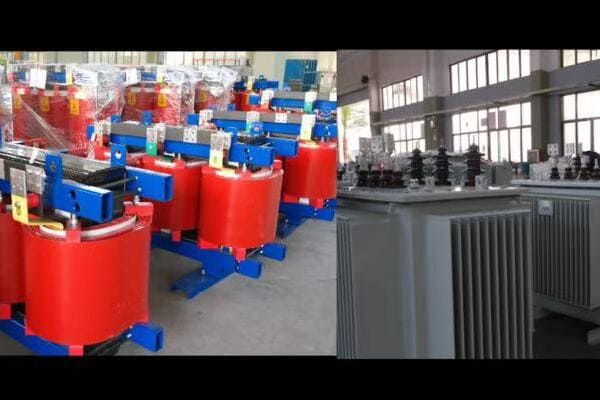
Exploring the Ideal Applications for Dry-Type Transformers
Let’s dive deeper into when and why you should choose a dry-type step down transformer:
1. Indoor Installations
Dry-type transformers are perfect for indoor use due to:
- No risk of oil leaks
- Reduced fire hazard
- Compact design suitable for limited spaces
I once worked on a project retrofitting an old office building with a new power distribution system. The limited space and strict fire safety regulations made dry-type transformers the obvious choice. Their compact size allowed for installation in small electrical rooms, while their inherent fire safety eliminated the need for expensive fire suppression systems.
2. Environmentally Sensitive Areas
Advantages in environmentally critical locations:
- No risk of oil spills or contamination
- Easier compliance with environmental regulations
- Suitable for areas near water sources or protected environments
3. High-Traffic Public Spaces
Benefits in public areas:
- Enhanced safety for occupants
- Lower noise levels compared to oil-filled units
- Reduced maintenance disruptions
4. Specialized Industries
Ideal for specific sectors:
- Healthcare facilities (hospitals, clinics)
- Educational institutions (schools, universities)
- Technology centers (data centers, research facilities)
5. Urban and Commercial Buildings
Advantages in urban settings:
- Easier to meet building codes and regulations
- Simplified installation without oil containment needs
- Reduced insurance costs due to lower fire risk
Here’s a comparison of scenarios where dry-type transformers are particularly beneficial:
| Application | Key Advantage of Dry-Type | Alternative Consideration |
|---|---|---|
| Hospitals | Enhanced patient safety | Higher initial cost |
| Data Centers | Reduced fire risk to IT equipment | Cooling efficiency in high-load scenarios |
| Schools | Low maintenance in budget-constrained environments | Potential capacity limitations for larger campuses |
| High-Rise Buildings | Ease of installation at heights | Load capacity for entire building |
| Renewable Energy Integration | Environmentally friendly alignment | Outdoor durability for some installations |
In my experience, the decision to use dry-type transformers often comes down to a combination of safety, environmental, and practical considerations. I recall a project for a new hospital wing where the choice of dry-type transformers was driven not just by fire safety regulations, but also by the need to minimize maintenance activities in sensitive medical areas. The peace of mind provided by their low-risk profile was invaluable in this critical healthcare environment.
The trend towards green building certifications is also influencing the choice of dry-type transformers. In a recent LEED-certified office complex project, the use of dry-type units contributed significantly to the building’s environmental and safety scores. Their energy efficiency and lack of chemical coolants aligned perfectly with the project’s sustainability goals.
In urban renewal projects, I’ve found dry-type transformers to be particularly advantageous. During the renovation of a historic building into a mixed-use space, the ability to install dry-type transformers without extensive modifications for oil containment was crucial. It allowed us to preserve more of the building’s original structure while still meeting modern power needs.
The growing focus on workplace safety is another factor favoring dry-type transformers. In a recent industrial facility upgrade, we chose dry-type units for areas where workers would be in close proximity to electrical equipment. The reduced fire risk and absence of potential oil leaks significantly enhanced the overall safety of the work environment.
Lastly, the compatibility of dry-type transformers with smart building technologies is becoming increasingly important. In a cutting-edge smart office project, we integrated dry-type transformers with advanced power monitoring systems. Their design made it easier to implement sensors and communication devices, facilitating real-time energy management and predictive maintenance.
Choosing a dry-type step down transformer is often the best decision in environments where safety, environmental concerns, and ease of maintenance are top priorities. Their suitability for indoor installations, public spaces, and specialized industries makes them an excellent choice for a wide range of modern applications. While they may have a higher initial cost, the long-term benefits in terms of safety, reduced maintenance, and environmental compatibility often outweigh this factor. As always, the final decision should be based on a careful evaluation of your specific project requirements and long-term operational needs.
When Is an Oil-Immersed Transformer the Better Option?
Are you wondering if an oil-immersed transformer might be the right choice for your project? You’re not alone. Many engineers and project managers find themselves weighing the benefits of oil-filled units against dry-type alternatives. But in what scenarios do oil-immersed transformers truly excel?
Oil-immersed transformers are typically the better option for:
✅ High-capacity or utility distribution applications
✅ Outdoor substations or rural grid installations
✅ Projects with long operating lifespans
They shine in environments requiring high power capacity, outdoor durability, and cost-effective long-term operation.
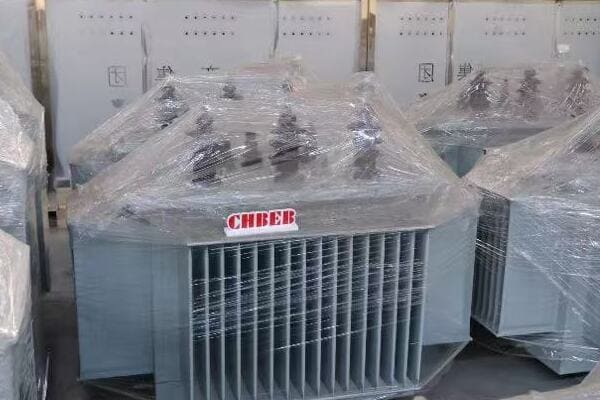
Exploring the Ideal Applications for Oil-Immersed Transformers
Let’s dive deeper into when and why you should choose an oil-immersed step down transformer:
1. High-Capacity Power Distribution
Oil-immersed transformers excel in high-power scenarios:
- Superior cooling efficiency for large power ratings
- Better overload capacity
- Ideal for utility-scale power distribution
I once worked on a major upgrade project for a regional power distribution network. The high power requirements and need for reliable operation under varying load conditions made oil-immersed transformers the clear choice. Their ability to handle large power capacities efficiently was crucial for maintaining a stable power supply across the network.
2. Outdoor and Harsh Environments
Advantages in challenging outdoor settings:
- Excellent weather resistance
- Better performance in extreme temperatures
- Suitable for remote or exposed locations
3. Long-Term Cost Effectiveness
Benefits over extended operational periods:
- Lower initial cost compared to equivalent dry-type units
- Longer lifespan with proper maintenance
- Potential for refurbishment to extend service life
4. Voltage Regulation and Efficiency
Technical advantages:
- Better voltage regulation under varying loads
- Higher efficiency, especially in larger sizes
- Lower no-load losses
5. Flexibility in Installation
Adaptability to various settings:
- Suitable for both indoor (with proper safeguards) and outdoor installations
- Scalable from small pole-mounted units to large substation transformers
Here’s a comparison of scenarios where oil-immersed transformers are particularly beneficial:
| Application | Key Advantage of Oil-Immersed | Consideration | |||
|---|---|---|---|---|---|
| Utility Substations | High capacity and efficiency | Environmental safeguards needed | Rural Electrification | Durability in remote locations | Maintenance logistics |
| Industrial Plants | Ability to handle heavy loads | Fire safety measures required | |||
| Renewable Energy Farms | Cost-effective for large installations | Environmental impact of oil | |||
| Long-Distance Transmission | Excellent cooling for continuous operation | Higher transportation and installation costs |
In my experience, the decision to use oil-immersed transformers often comes down to a balance of power requirements, environmental conditions, and long-term operational costs. I recall a project for a large industrial complex where we initially considered dry-type transformers due to fire safety concerns. However, the high power demands and the need for outdoor installation in a harsh coastal environment ultimately led us to choose oil-immersed units. Their superior cooling efficiency and ability to withstand the corrosive sea air proved invaluable in ensuring reliable power supply to the facility.
The cost-effectiveness of oil-immersed transformers over long operational periods can be significant. In a recent utility-scale project, we conducted a detailed lifecycle cost analysis comparing oil-immersed and dry-type options. Despite higher maintenance requirements, the oil-immersed transformers showed a lower total cost of ownership over a 30-year period, primarily due to their lower initial cost and higher efficiency.
In renewable energy applications, particularly large wind and solar farms, oil-immersed transformers often prove to be the most practical choice. I worked on a major offshore wind farm project where the transformers needed to handle variable loads and withstand harsh marine conditions. The robust design and excellent cooling properties of oil-immersed units made them ideal for this challenging environment.
The ability to refurbish oil-immersed transformers is another significant advantage. I’ve been involved in several projects where decades-old oil-immersed transformers were successfully refurbished, extending their operational life by many years. This level of longevity and repairability is generally not achievable with dry-type units, making oil-immersed transformers a more sustainable choice in some contexts.
It’s worth noting that advancements in transformer oil technology are addressing some of the traditional concerns associated with oil-immersed units. In a recent project, we used biodegradable ester fluids instead of mineral oil, significantly reducing environmental risks while maintaining the performance benefits of oil-immersed design. This innovation is making oil-immersed transformers a more attractive option even in environmentally sensitive areas.
The scalability of oil-immersed transformers is another key advantage. I’ve worked on projects ranging from small rural electrification initiatives using pole-mounted transformers to massive utility substations. The ability of oil-immersed technology to scale effectively across such a wide range of applications provides flexibility in system design and future expansion.
Lastly, the integration of smart monitoring technologies is enhancing the appeal of oil-immersed transformers. In a recent grid modernization project, we implemented advanced sensor systems in oil-immersed units, allowing for real-time monitoring of oil quality, temperature, and load conditions. This capability not only improves reliability but also optimizes maintenance schedules, addressing one of the traditional drawbacks of oil-immersed technology.
Choosing an oil-immersed step down transformer is often the best decision in scenarios requiring high power capacity, outdoor durability, and long-term cost-effectiveness. Their suitability for utility-scale applications, harsh environments, and long operational lifespans makes them an excellent choice for many large-scale and industrial projects. While they require more maintenance and environmental considerations compared to dry-type units, the benefits in terms of performance, efficiency, and long-term value often outweigh these factors. As always, the final decision should be based on a careful evaluation of your specific project requirements, environmental conditions, and long-term operational strategy.
Selection Checklist: How to Decide Based on Your Project Needs?
Are you feeling overwhelmed by the decision between dry and oil-immersed transformers? You’re not alone. Many professionals find themselves at a crossroads when selecting the right transformer for their project. But what if you had a simple checklist to guide your decision-making process?
To choose between dry and oil-immersed transformers, consider:
✅ Is the installation indoor or outdoor?
✅ Do you have fire safety restrictions?
✅ What’s your target capacity (kVA)?
✅ Are maintenance costs a concern?
✅ Do you need IEC/ANSI/UL certification?
These key questions will help you align your choice with your project’s specific requirements.

Comprehensive Transformer Selection Checklist
Let’s break down the selection process into manageable steps:
1. Installation Environment
- [ ] Is the transformer to be installed indoors or outdoors?
- [ ] Are there space constraints at the installation site?
- [ ] What are the ambient temperature ranges?
- [ ] Is the location prone to humidity, dust, or corrosive elements?
I once consulted on a project where the client initially specified an oil-immersed transformer for an indoor installation. By walking through this checklist, we realized that the space constraints and fire safety regulations made a dry-type transformer the only viable option, potentially avoiding a costly mistake.
2. Safety Considerations
- [ ] Are there specific fire safety regulations to comply with?
- [ ] Is the transformer located near sensitive equipment or populated areas?
- [ ] Do local codes restrict the use of oil-filled equipment?
3. Power Requirements
- [ ] What is the required power capacity (kVA)?
- [ ] Are there plans for future expansion or load increases?
- [ ] What are the voltage transformation requirements?
4. Maintenance and Operational Costs
- [ ] What is your budget for ongoing maintenance?
- [ ] Do you have access to skilled personnel for oil testing and maintenance?
- [ ] How critical is minimal downtime for your operations?
5. Environmental Factors
- [ ] Are there environmental regulations concerning oil containment?
- [ ] Is the site in an environmentally sensitive area?
- [ ] Do you have corporate sustainability goals to consider?
6. Standards and Certifications
- [ ] Which standards does your project need to comply with (IEC, ANSI, UL)?
- [ ] Are there specific efficiency standards to meet?
- [ ] Do you require special certifications for insurance or regulatory purposes?
Here’s a decision matrix to help you weigh these factors:
| Factor | Favors Dry-Type | Favors Oil-Immersed |
|---|---|---|
| Location | Indoor, populated areas | Outdoor, remote sites |
| Capacity | <10 MVA typically | >10 MVA typically |
| Fire Risk | High concern | Lower concern |
| Maintenance | Minimal preferred | Regular maintenance acceptable |
| Environment | Sensitive areas | Non-sensitive areas |
| Cost Priority | Higher upfront cost acceptable | Lower initial cost preferred |
In my experience, this checklist has been invaluable in guiding clients through the decision-making process. I recall a project for a new data center where we initially leaned towards oil-immersed transformers due to their higher efficiency. However, after going through this checklist, we realized that the fire safety concerns and the need for minimal maintenance in the sensitive server environments made dry-type transformers the better choice, despite their slightly lower efficiency.
The importance of considering future needs cannot be overstated. In a recent industrial park development, we used this checklist to plan for phased expansion. By anticipating future power requirements, we were able to design a flexible system using a combination of dry-type transformers for initial, smaller loads, and leaving space for larger oil-immersed units as the park grew.
Environmental considerations often play a crucial role in the decision. I worked on a project near a protected watershed where the environmental risks associated with potential oil leaks were deemed unacceptable. The checklist helped us quickly identify dry-type transformers as the only suitable option, aligning with both regulatory requirements and the client’s corporate sustainability goals.
The maintenance factor can be particularly significant in remote or hard-to-access locations. In an offshore wind farm project, the difficulty and cost of performing regular oil maintenance led us to opt for dry-type transformers in the turbine nacelles, despite the challenging environment. This decision significantly reduced the need for costly maintenance visits.
Lastly, it’s important to consider the total cost of ownership, not just the initial investment. In a recent university campus upgrade, the checklist prompted a detailed cost analysis. While oil-immersed transformers had a lower upfront cost, the long-term savings in maintenance and the reduced insurance premiums associated with dry-type units made them more economical over the project’s lifespan.
This selection checklist serves as a comprehensive guide to navigate the complex decision between dry and oil-immersed transformers. By methodically working through these considerations, you can ensure that your choice aligns with your project’s specific needs, regulatory requirements, and long-term operational goals. Remember, the best transformer for your project is one that balances performance, safety, cost-effectiveness, and environmental responsibility in a way that best suits your unique circumstances.
Summary Table – Dry vs Oil Step-Down Transformers at a Glance?
Are you looking for a quick, comprehensive comparison between dry and oil step-down transformers? You’re not alone. Many professionals seek a concise overview to guide their decision-making process. But how can you compare these two types effectively without getting lost in technical details?
This summary table provides a side-by-side comparison of dry and oil step-down transformers, highlighting key differences in cooling, fire risk, maintenance, applications, and cost. It offers a quick reference guide for engineers and project managers to make informed decisions based on their specific project requirements.

Comprehensive Comparison: Dry vs Oil Step-Down Transformers
Let’s break down the key characteristics of both transformer types in an easy-to-reference table:
| Feature | Dry-Type Transformers | Oil-Immersed Transformers |
|---|---|---|
| Cooling Method | Air-cooled (natural or forced) | Oil-cooled |
| Fire Risk | Low (often F1 class) | Moderate (requires protection) |
| Maintenance | Minimal (periodic cleaning) | Regular (oil testing, potential replacement) |
| Typical Applications | Indoor, commercial, hospitals, data centers | Outdoor, utilities, industrial, high capacity |
| Environmental Risk | Low (no oil leakage risk) | Moderate (potential oil spills) |
| Initial Cost | Higher | Lower |
| Efficiency | Good (especially at lower capacities) | Excellent (especially at higher capacities) |
| Overload Capacity | Limited | Better |
| Noise Level | Higher | Lower |
| Size and Weight | More compact, lighter | Larger, heavier |
| Lifespan | 20-30 years typically | 30-40 years with proper maintenance |
| Suitable Environments | Indoor, clean, dry | Outdoor, varied conditions |
| Voltage Range | Up to 35 kV typically | Up to 765 kV or higher |
| Power Range | Up to 30 MVA typically | Up to hundreds of MVA |
This table encapsulates years of experience and countless projects I’ve been involved with. Let me share some insights on how these comparisons play out in real-world scenarios.
The choice between dry and oil-immersed transformers often comes down to a balance of factors. I recall a project for a new urban substation where space constraints and fire safety regulations initially pointed towards dry-type transformers. However, the high power requirements and the need for better overload capacity led us to a hybrid solution: using compact, specially designed oil-immersed units with enhanced fire protection systems.
The maintenance aspect can be a decisive factor, especially in locations with limited access to skilled technicians. In a remote solar farm project, we opted for dry-type transformers despite their slightly lower efficiency. The minimal maintenance requirements proved invaluable in reducing operational costs and ensuring consistent performance in a location where regular oil testing would have been challenging.
Environmental considerations are increasingly important in transformer selection. I worked on a project near a sensitive ecological area where the risk of oil leakage was deemed unacceptable. The use of dry-type transformers not only met environmental regulations but also simplified the permitting process, highlighting how these technical choices can have broader project impacts.
The noise factor is often overlooked but can be crucial in certain applications. In a recent residential area substation upgrade, the lower noise levels of oil-immersed transformers were a key factor in their selection, helping to maintain good relations with the local community.
It’s worth noting that advancements in technology are continually narrowing the gap between these two types. In a cutting-edge data center project, we used high-capacity dry-type transformers that rivaled oil-immersed units in efficiency, challenging traditional assumptions about their limitations.
The lifespan and long-term cost considerations can significantly influence the decision. In a large industrial complex with a 50-year planned operational life, the longer lifespan and better overload capacity of oil-immersed transformers made them more cost-effective in the long run, despite higher maintenance requirements.
Lastly, the trend towards smart grids and digital monitoring is impacting both types of transformers. In recent projects, I’ve seen advanced monitoring systems integrated into both dry and oil-immersed units, allowing for predictive maintenance and real-time performance optimization, regardless of the transformer type.
This summary table serves as a valuable tool for initial comparison, but it’s important to remember that each project has unique requirements. The best choice depends on a careful evaluation of your specific needs, including installation environment, power requirements, maintenance capabilities, and long-term operational strategy. By considering these factors in the context of your project, you can make an informed decision that balances performance, safety, cost-effectiveness, and environmental responsibility.
Conclusion
Choosing between dry and oil step-down transformers depends on specific project needs. Dry types excel in indoor, fire-sensitive environments with minimal maintenance, while oil-filled units are ideal for outdoor, high-capacity applications. Consider installation location, safety requirements, capacity needs, maintenance capabilities, and environmental factors to make the best choice for your project.
Are you struggling to navigate the complex global transformer market? You’re not alone. Many manufacturers and buyers find themselves overwhelmed by the diverse regional requirements and market trends. But what if you could gain a clear understanding of how the USA, European, and Asian markets differ, and use this knowledge to your advantage?
The global electric transformer market is shaped by distinct regional characteristics. The USA focuses on high standards and utility-driven procurement, Europe prioritizes green compliance and smart grid integration, while Asia sees rapid growth in price-sensitive segments. Understanding these differences is crucial for successful market entry and expansion.

In this comprehensive guide, I’ll walk you through the key differences and trends in the USA, European, and Asian transformer markets. Whether you’re a manufacturer looking to expand globally or a buyer seeking the best sourcing strategy, this article will provide you with valuable insights to make informed decisions in the evolving transformer industry.
Global Transformer Market Snapshot (2025 Outlook)?
Are you wondering how the global transformer market is shaping up as we approach 2025? You’re not alone. Many industry players are keen to understand the market’s trajectory and identify growth opportunities. But what are the key factors driving this market, and where are the hotspots for growth?
The global transformer market is projected to reach $XX billion by 2025, driven by renewable energy integration, urbanization, and grid modernization efforts. Key growth regions include the United States, Germany, China, and India, with emerging markets in Southeast Asia and Africa showing significant potential.

Diving Deeper into the Global Transformer Market
Let’s explore the key factors shaping the global transformer market:
Market Size and Growth Drivers
The transformer market is experiencing robust growth, primarily due to:
- Increasing electricity demand in developing countries
- Renewable energy integration challenges
- Aging grid infrastructure in developed nations
- Smart grid initiatives worldwide
I recently attended a major energy conference where industry leaders were buzzing about the unprecedented growth in the transformer market. The consensus was clear: we’re entering a golden age for transformer manufacturers and suppliers.
Regional Growth Hotspots
Key regions driving market growth include:
- North America: Focus on grid resilience and renewable integration
- Europe: Leading in eco-friendly and smart transformer technologies
- Asia-Pacific: Rapid industrialization and urbanization driving demand
- Middle East and Africa: Expanding energy access and infrastructure development
Technology Trends
Emerging technologies shaping the market:
- Smart transformers with IoT capabilities
- High-efficiency amorphous core transformers
- Eco-friendly insulating materials
- Compact and modular designs for urban applications
Here’s a breakdown of the global transformer market by region:
| Region | Market Share (2025 Est.) | Key Growth Drivers |
|---|---|---|
| Asia-Pacific | 40% | Rapid industrialization, urbanization |
| North America | 25% | Grid modernization, renewable integration |
| Europe | 20% | Smart grid initiatives, eco-regulations |
| Rest of World | 15% | Infrastructure development, energy access |
In my experience, the global transformer market is becoming increasingly interconnected. I recall a project where we sourced high-efficiency transformers from Europe for a renewable energy installation in Southeast Asia. This cross-pollination of technologies and standards is becoming more common, highlighting the importance of understanding global market dynamics.
The impact of renewable energy on the transformer market cannot be overstated. In a recent wind farm project I consulted on, the need for specialized transformers capable of handling variable loads and harsh environments was a critical factor. This trend is driving innovation in transformer design and creating new market segments.
Urbanization and smart city initiatives are also playing a significant role in shaping the market. I’m currently involved in a smart grid project where compact, IoT-enabled transformers are being deployed throughout a major metropolitan area. The demand for these advanced units is skyrocketing, especially in rapidly developing urban centers in Asia and the Middle East.
The focus on energy efficiency and environmental sustainability is influencing transformer specifications globally. In Europe, I’ve seen projects where the energy efficiency requirements for transformers exceed even the strictest global standards. This push for high-efficiency units is gradually spreading to other regions, driving up the overall quality of transformers in the market.
Lastly, the trend towards modular and mobile transformer solutions is gaining traction, especially in regions prone to natural disasters or in rapidly developing areas. I recently worked on a project in Africa where mobile transformer substations were crucial for providing quick, flexible power solutions in remote areas. This growing niche is opening up new opportunities for manufacturers who can offer innovative, adaptable designs.
As we look towards 2025, the global transformer market presents a landscape of diverse opportunities and challenges. The interplay of regional needs, technological advancements, and global trends is creating a dynamic market environment. For manufacturers, understanding these nuances is crucial for product development and market entry strategies. For buyers, it’s essential to stay informed about global trends to make optimal procurement decisions. The transformer market of 2025 will be characterized by smarter, more efficient, and more adaptable solutions, driven by the world’s ever-growing and evolving energy needs.
USA Market – High Standards, Utility-Focused Procurement?
Are you finding it challenging to navigate the USA transformer market? You’re not alone. Many manufacturers and suppliers struggle to meet the high standards and specific requirements of the American market. But what exactly makes the USA market unique, and how can you position yourself for success in this demanding environment?
**The USA transformer market is characterized by:
- 60Hz frequency standard
- ANSI and UL certification requirements
- Utility-driven procurement processes
- Preference for pad-mounted and dry-type transformers
- Focus on medium-voltage applications and data center infrastructure
These factors create a high-standard, utility-focused market with stringent quality and safety requirements.**
Exploring the Nuances of the USA Transformer Market
Let’s dive deeper into the key aspects that define the USA transformer market:
Technical Standards and Certifications
The USA market has distinct technical requirements:
- 60Hz frequency (unlike the 50Hz standard in many other countries)
- ANSI C57 series standards for transformer design and testing
- UL (Underwriters Laboratories) certification for safety
I once worked with a European manufacturer trying to enter the USA market. Their biggest challenge was adapting their 50Hz designs to meet 60Hz requirements while also obtaining UL certification. It was a complex process, but crucial for market entry.
Key Market Segments
Major buyers in the USA market include:
- Utility companies (both investor-owned and public)
- Data centers and tech companies
- Industrial facilities
- Renewable energy projects
Product Preferences
Popular transformer types in the USA:
- Pad-mounted transformers for urban and suburban distribution
- Dry-type transformers for indoor and sensitive environments
- Medium-voltage transformers for industrial applications
Procurement Processes
Unique aspects of USA procurement:
- Rigorous bidding processes for utility projects
- Long-term frame agreements with preferred suppliers
- Emphasis on total cost of ownership (TCO) rather than just initial price
Here’s a breakdown of the USA transformer market segments:
| Segment | Market Share | Key Requirements |
|---|---|---|
| Utility | 45% | High reliability, ANSI compliance |
| Industrial | 25% | Custom designs, energy efficiency |
| Commercial | 20% | Dry-type, compact designs |
| Renewable Energy | 10% | Specialized for variable loads |
In my experience, success in the USA market often hinges on understanding and meeting these stringent standards. I recall a project where a non-USA manufacturer lost a major utility contract because their transformers, while high-quality, didn’t fully comply with specific ANSI requirements. This experience underscored the importance of thorough market research and product adaptation.
The focus on energy efficiency in the USA market is intensifying. I recently consulted on a data center project where the client specified transformers that exceeded the Department of Energy’s efficiency standards. This trend towards high-efficiency units is driven by both regulatory pressures and the desire to reduce operational costs over the transformer’s lifetime.
Safety considerations are paramount in the USA market. In a recent industrial project, we had to redesign the transformer installation to meet stringent fire safety codes specific to the local jurisdiction. This level of attention to safety and compliance is typical in the USA and can significantly impact project timelines and costs.
The growing renewable energy sector is creating new demands in the USA transformer market. I’m currently involved in a large-scale solar farm project where the transformers need to handle variable loads and harsh outdoor conditions. This has led to innovations in transformer design, particularly in thermal management and insulation technologies.
Lastly, the trend towards smart grid technologies is influencing transformer specifications in the USA. Utilities are increasingly demanding transformers with built-in monitoring and communication capabilities. In a recent grid modernization project, the ability to integrate transformers with advanced grid management systems was a key selection criterion, highlighting the growing importance of "smart" features in the USA market.
The USA transformer market, with its high standards and utility-focused procurement, presents both challenges and opportunities for manufacturers and suppliers. Success in this market requires a deep understanding of technical standards, a commitment to quality and safety, and the ability to provide innovative solutions that meet the evolving needs of utilities, industries, and the growing renewable energy sector. For those who can navigate these requirements, the USA market offers a stable, high-value environment with significant opportunities for growth and technological advancement.
Europe Market – Green Compliance and Smart Grid Integration?
Are you struggling to keep up with the rapidly evolving European transformer market? You’re not alone. Many manufacturers and suppliers find themselves challenged by Europe’s stringent environmental regulations and push for smart grid technologies. But what exactly makes the European market unique, and how can you turn these challenges into opportunities?
**The European transformer market is characterized by:
- 50Hz frequency standard
- IEC standards and Eco Design Directive compliance
- Strong focus on energy efficiency and environmental sustainability
- Preference for low-loss dry-type and eco-friendly oil-filled transformers
- Emphasis on smart grid integration and renewable energy compatibility
These factors create a market driven by green compliance and technological innovation.**
Diving into the European Transformer Market Landscape
Let’s explore the key aspects that define the European transformer market:
Regulatory Environment
Europe’s transformer market is heavily influenced by regulations:
- IEC (International Electrotechnical Commission) standards
- EU Eco Design Directive (implementing regulation 548/2014)
- REACH (Registration, Evaluation, Authorization and Restriction of Chemicals)
- RoHS (Restriction of Hazardous Substances)
I once worked on a project helping a non-European manufacturer adapt their products for the EU market. The most challenging aspect was meeting the stringent efficiency requirements of the Eco Design Directive. It required significant redesigns but ultimately led to a more competitive product line.
Key Market Drivers
Major factors shaping the European market:
- Renewable energy integration
- Smart grid initiatives
- Aging infrastructure replacement
- Urbanization and electrification of transport
Product Preferences
Popular transformer types in Europe:
- Low-loss amorphous core transformers
- Dry-type transformers for urban and sensitive environments
- Eco-friendly ester-filled transformers
- Smart transformers with monitoring capabilities
Procurement Trends
Unique aspects of European procurement:
- Government-driven tenders with strong emphasis on environmental criteria
- Life-cycle cost analysis (including energy losses) in purchasing decisions
- Preference for local or EU-based manufacturers in some countries
Here’s a breakdown of the European transformer market segments:
| Segment | Market Share | Key Focus Areas |
|---|---|---|
| Utility | 40% | Smart grid, renewable integration |
| Industrial | 30% | Energy efficiency, custom solutions |
| Renewable Energy | 20% | Grid stability, variable load handling |
| Commercial | 10% | Urban-friendly, low noise designs |
In my experience, success in the European market often hinges on a company’s ability to innovate in energy efficiency and environmental sustainability. I recall a project where we introduced a new line of ultra-low-loss transformers. Despite the higher initial cost, these units were highly successful due to their lower total cost of ownership, aligning perfectly with European buyers’ long-term perspective.
The push for smart grid technologies is reshaping the European transformer market. In a recent project for a major utility in Germany, we implemented transformers with advanced monitoring and communication capabilities. This trend towards "smart transformers" is rapidly becoming the norm, driven by the need for more flexible and responsive grid management.
Environmental considerations go beyond just energy efficiency in Europe. I’m currently advising on a project where the client specifically requested transformers with biodegradable insulating fluids. This focus on eco-friendly materials is increasingly common, reflecting broader societal concerns about environmental impact.
The renewable energy sector is a major driver of innovation in the European transformer market. In a wind farm project off the coast of Denmark, we faced unique challenges in designing transformers that could withstand harsh marine conditions while handling the variable loads typical of wind power. This project exemplified the kind of specialized solutions that are increasingly in demand across Europe.
Lastly, the trend towards urbanization and electrification of transport is creating new opportunities in the European market. I recently worked on a project designing compact, low-noise transformers for urban substations supporting electric vehicle charging infrastructure. This growing niche requires transformers that can handle high power demands while meeting strict urban planning and noise regulations.
The European transformer market, with its focus on green compliance and smart grid integration, presents a unique landscape of challenges and opportunities. Success in this market requires a commitment to environmental sustainability, technological innovation, and a deep understanding of complex regulatory requirements. For manufacturers and suppliers who can meet these high standards, Europe offers a sophisticated market with a strong emphasis on quality and long-term value. As the continent continues its transition towards a more sustainable and intelligent energy infrastructure, the demand for advanced, efficient, and environmentally friendly transformer solutions will only grow.
Asia Market – Rapid Growth, Price-Driven Segments?
Are you finding it challenging to navigate the diverse and rapidly evolving Asian transformer market? You’re not alone. Many manufacturers and suppliers struggle to keep pace with the region’s explosive growth and varied requirements. But what makes the Asian market unique, and how can you position yourself to capitalize on its immense potential?
**The Asian transformer market is characterized by:
- Rapid growth driven by industrialization and urbanization
- Significant variations between countries (e.g., China, India, Southeast Asia)
- Price-sensitive segments, especially in developing regions
- Growing demand in industrial parks, real estate, and infrastructure projects
- Preference for oil-immersed distribution transformers and packaged substations
These factors create a dynamic, cost-conscious market with diverse regional needs.**
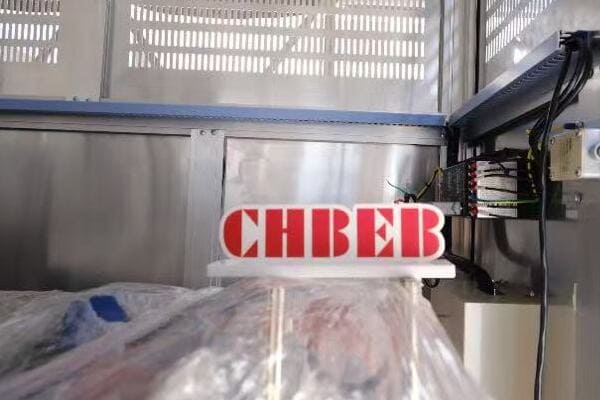
Exploring the Complexities of the Asian Transformer Market
Let’s dive deeper into the key aspects that define the Asian transformer market:
Regional Diversity
The Asian market is far from homogeneous:
- China: World’s largest market, focus on UHV and smart grid
- India: Rapid growth, emphasis on rural electrification
- Southeast Asia: Diverse needs, from basic infrastructure to advanced smart city projects
I once worked on a project supplying transformers for a pan-Asian infrastructure initiative. The biggest challenge was adapting our designs to meet the vastly different requirements and standards across multiple countries. This experience highlighted the importance of flexibility and local market knowledge in Asia.
Key Market Drivers
Major factors shaping the Asian market:
- Rapid industrialization and urbanization
- Massive infrastructure projects (e.g., Belt and Road Initiative)
- Growing renewable energy sector
- Modernization of aging power grids
Product Preferences
Popular transformer types in Asia:
- Oil-immersed distribution transformers
- Compact substations for urban development
- High-voltage and ultra-high-voltage transformers (especially in China)
- Cost-effective solutions for rural electrification
Procurement Trends
Unique aspects of Asian procurement:
- Strong emphasis on price competitiveness
- Growing focus on energy efficiency, especially in developed Asian markets
- Preference for turnkey solutions in many projects
- Increasing importance of after-sales service and local support
Here’s a breakdown of the Asian transformer market segments:
| Segment | Market Share | Key Characteristics |
|---|---|---|
| Utility | 50% | Large-scale projects, price-sensitive |
| Industrial | 30% | Rapid growth, diverse requirements |
| Infrastructure | 15% | Government-driven, long-term projects |
| Renewable Energy | 5% | Emerging sector, high potential |
In my experience, success in the Asian market often requires a delicate balance between cost-effectiveness and quality. I recall a project in Southeast Asia where we introduced a line of transformers specifically designed for tropical climates. By focusing on durability and efficiency in hot, humid conditions, we were able to differentiate our products in a price-sensitive market.
The pace of urbanization in Asia is creating unique challenges and opportunities. In a recent project for a smart city development in China, we supplied compact, low-noise transformers that could be seamlessly integrated into dense urban environments. This trend towards urban-friendly transformer solutions is rapidly gaining traction across the region.
The renewable energy sector, while still a smaller segment, is showing tremendous growth potential. I’m currently advising on a large-scale solar project in India where the key challenge is designing transformers that can handle the variable loads and harsh environmental conditions typical of solar farms. This project exemplifies the growing opportunities in Asia’s renewable energy sector.
The demand for high-voltage and ultra-high-voltage transformers, particularly in China, is driving technological advancements. I recently visited a manufacturing facility in China that was producing 1000 kV transformers for long-distance power transmission. The scale and sophistication of these units were truly impressive, showcasing Asia’s leadership in certain high-tech transformer segments.
Interestingly, while price remains a crucial factor, there’s a growing awareness of lifecycle costs in more developed Asian markets. In a recent project for a major industrial client in South Korea, the focus was on high-efficiency transformers that could reduce long-term operational costs. This shift towards value-based purchasing is gradually spreading across the region.
The importance of after-sales service and local support cannot be overstated in the Asian market. I’ve seen cases where manufacturers with strong local service networks won contracts over competitors offering lower initial prices. This trend underscores the need for a robust local presence or strong partnerships in key Asian markets.
Lastly, the diversity of standards and regulations across Asian countries presents both challenges and opportunities. In a recent multi-country project, we had to navigate different technical standards, import regulations, and local content requirements. While complex, this diversity also creates niches for specialized solutions tailored to specific country needs.
The Asian transformer market, with its rapid growth and price-driven segments, offers immense opportunities for those who can navigate its complexities. Success in this market requires a nuanced understanding of regional differences, a focus on cost-effective yet reliable solutions, and the ability to adapt quickly to changing market needs. As Asia continues its trajectory of rapid development and modernization, the demand for transformers across various segments – from basic infrastructure to advanced smart grid applications – will continue to grow, making it a key market for global transformer manufacturers and suppliers.
Technical & Regulatory Comparison Table?
Are you finding it challenging to keep track of the different technical standards and regulatory requirements across major transformer markets? You’re not alone. Many manufacturers and buyers struggle with the complexity of global compliance. But what if you had a clear, comprehensive comparison of these critical factors at your fingertips?
This comparison table provides a concise overview of key technical and regulatory aspects of transformer markets in the USA, Europe, and Asia. It highlights differences in frequency standards, certification requirements, typical products, and primary concerns, offering valuable insights for manufacturers and buyers navigating these diverse markets.
Detailed Comparison of Transformer Markets: USA, Europe, and Asia
Let’s break down the key technical and regulatory aspects of these major markets:
| Region | Frequency | Standard | Typical Product | Key Concern |
|---|---|---|---|---|
| USA | 60 Hz | ANSI / UL | Pad-mounted, Dry-type | Fire safety, energy code |
| Europe | 50 Hz | IEC, EcoDesign | Low-loss Dry-type | Efficiency, green policy |
| Asia | 50 Hz | IEC / GB | Oil-immersed, compact | Cost, delivery speed |
This table encapsulates years of experience and countless projects I’ve been involved with across these regions. Let me share some insights on how these differences play out in real-world scenarios.
Frequency Standards
The difference between 60 Hz in the USA and 50 Hz in Europe and Asia is more than just a number. I once worked on a project where a European manufacturer tried to enter the US market without properly adapting their 50 Hz designs. The result was overheating issues and efficiency losses. This experience underscored the critical importance of frequency considerations in transformer design and selection.
Certification and Standards
The regulatory landscape varies significantly:
- USA: ANSI standards focus on reliability and safety, with UL certification being crucial for many applications.
- Europe: IEC standards are prevalent, with the additional layer of EcoDesign requirements pushing for higher efficiency.
- Asia: While IEC standards are common, countries like China also have their own standards (e.g., GB in China), adding complexity to the market.
I recall a project where we had to redesign a transformer line to meet the stringent efficiency requirements of the European EcoDesign directive. While challenging, this process ultimately led to innovations that improved our products globally.
Typical Products
Product preferences reflect local conditions and priorities:
- USA: Pad-mounted transformers are popular for their compact design and suitability for urban environments.
- Europe: Low-loss dry-type transformers are favored, aligning with the region’s focus on energy efficiency and environmental concerns.
- Asia: Oil-immersed transformers remain popular, especially in rapidly developing areas, due to their cost-effectiveness and suitability for diverse environments.
In a recent project in Southeast Asia, we found that while there was interest in dry-type transformers for certain applications, oil-immersed units still dominated due to their lower cost and familiarity among local engineers.
Key Concerns
Each region has its primary focus:
- USA: Fire safety is a major concern, especially in urban and commercial settings. Energy codes are also becoming increasingly stringent.
- Europe: Efficiency and environmental impact are paramount, driven by both regulations and public sentiment.
- Asia: While cost remains a primary factor, there’s growing attention to delivery speed, especially in fast-paced development projects.
I’ve seen these concerns shape project outcomes significantly. In a European smart grid project, the client was willing to pay a premium for ultra-high efficiency transformers, citing long-term energy savings and compliance with future regulations as justification.
Emerging Trends
It’s worth noting some emerging trends that are beginning to blur these regional distinctions:
- Smart grid compatibility is becoming a global concern, with all regions showing increased interest in transformers with monitoring and communication capabilities.
- Environmental considerations, while most pronounced in Europe, are gaining traction worldwide. I’m seeing more projects in the USA and Asia specifying eco-friendly insulating fluids and emphasizing energy efficiency.
- The rise of renewable energy is creating new demands across all regions for transformers capable of handling variable loads and harsh environmental conditions.
This technical and regulatory comparison underscores the complexity of the global transformer market. For manufacturers, it highlights the need for adaptable designs and a thorough understanding of regional requirements. For buyers, it emphasizes the importance of specifying the right transformer for their specific location and application.
As we navigate these diverse markets, staying informed about these regional differences and emerging global trends is crucial. Whether you’re a manufacturer looking to expand your market reach or a buyer seeking the best solution for your project, understanding these technical and regulatory nuances is key to making informed decisions in the ever-evolving world of transformer technology.
Market Trends and Procurement Drivers in Each Region?
Are you finding it challenging to keep up with the rapidly evolving transformer market trends across different regions? You’re not alone. Many industry professionals struggle to grasp the nuanced drivers shaping procurement decisions in various parts of the world. But what if you could gain a clear understanding of these trends, helping you to make more informed decisions or tailor your offerings more effectively?
**Key market trends and procurement drivers vary significantly across regions:
- USA: Focus on data center expansion and grid digitalization
- Europe: Emphasis on green policies and electric vehicle infrastructure
- Asia: Rapid urban grid development and foreign industrial expansion
Understanding these regional priorities is crucial for effective market strategies and procurement decisions in the global transformer industry.**

Exploring Regional Market Trends and Procurement Drivers
Let’s dive deeper into the specific trends and drivers shaping each major market:
USA Market Trends
Key trends in the USA include:
- Exponential growth in data center infrastructure
- Grid modernization and digitalization initiatives
- Increasing focus on renewable energy integration
- Rising demand for resilient power systems
I recently worked on a large-scale data center project in the USA where the demand for high-efficiency, compact transformers was unprecedented. The client’s focus on energy efficiency and reliability drove the selection of advanced transformer technologies, highlighting the growing influence of the tech sector on the transformer market.
European Market Drivers
Europe’s market is primarily driven by:
- Stringent green policies and sustainability goals
- Rapid expansion of electric vehicle charging infrastructure
- Smart grid initiatives and IoT integration
- Aging infrastructure replacement programs
In a recent project for a major European utility, the procurement process was heavily influenced by the EU’s carbon neutrality goals. The client specifically requested transformers with ultra-low losses and eco-friendly insulating fluids, even at a premium cost, to align with their sustainability commitments.
Asian Market Dynamics
Asia’s diverse market is characterized by:
- Massive urban grid development projects
- Expansion of foreign industrial facilities
- Growing renewable energy sector, especially in China and India
- Increasing demand for smart city technologies
During a recent consultation for an industrial park development in Southeast Asia, I observed a strong preference for compact, high-capacity transformers that could support rapid industrial growth while minimizing space requirements. This trend reflects the unique challenges of fast-paced urbanization in many Asian countries.
Here’s a comparison of key procurement drivers across these regions:
| Region | Primary Driver | Secondary Driver | Emerging Trend |
|---|---|---|---|
| USA | Grid Resilience | Energy Efficiency | Renewable Integration |
| Europe | Sustainability | Smart Grid Tech | E-mobility Support |
| Asia | Cost-Effectiveness | Rapid Deployment | Smart City Solutions |
In my experience, these regional trends significantly influence not just what transformers are procured, but how they are specified and purchased. For instance, in the USA, I’ve seen a growing emphasis on cybersecurity features in transformer monitoring systems, driven by concerns about grid vulnerabilities. This has led to the development of new, more secure communication protocols for smart transformers.
The European focus on sustainability is pushing the boundaries of transformer technology. In a recent wind farm project in Northern Europe, we implemented transformers with biodegradable insulating fluids and advanced cooling systems to maximize efficiency. This project exemplified how environmental regulations are driving innovation in the industry.
In Asia, the pace of development often necessitates creative procurement strategies. I recall a project in a rapidly expanding Chinese city where modular, prefabricated transformer substations were used to keep pace with the breakneck speed of urban growth. This approach allowed for faster deployment and easier future upgrades, aligning with the region’s dynamic development needs.
The influence of renewable energy is a common thread across all regions, but with different emphases. In the USA, the focus is often on large-scale solar and wind integration into the existing grid. In Europe, there’s a strong push for distributed renewable generation, requiring transformers with bidirectional power flow capabilities. In Asia, particularly China, I’ve observed a trend towards ultra-high voltage transformers for long-distance transmission of renewable energy from remote generation sites to urban centers.
Lastly, it’s worth noting the growing importance of lifecycle cost analysis in procurement decisions across all regions. While initial cost remains a significant factor, especially in parts of Asia, I’m seeing a global shift towards considering long-term operational costs, including energy losses and maintenance requirements. This trend is driving demand for higher quality, more efficient transformers, even in traditionally price-sensitive markets.
Understanding these regional market trends and procurement drivers is crucial for anyone involved in the transformer industry. For manufacturers, it guides product development and marketing strategies. For buyers, it informs specification and selection processes. As the global energy landscape continues to evolve, staying attuned to these regional nuances will be key to success in the transformer market.
Export Tips for Transformer Manufacturers?
Are you a transformer manufacturer looking to expand your global footprint? You’re not alone. Many companies struggle to navigate the complexities of exporting transformers to different regions. But what if you had a set of proven strategies to help you succeed in international markets?
**Key export tips for transformer manufacturers include:
- Tailor designs to ANSI/IEC standards depending on the target region
- Pre-prepare CE/UL certifications to expedite market entry
- Work with local partners for bidding and market insights
- Shorten lead times for Asian markets, ensure strict compliance for Europe
- Develop region-specific marketing materials highlighting relevant features
These strategies can significantly improve your chances of success in global markets.**
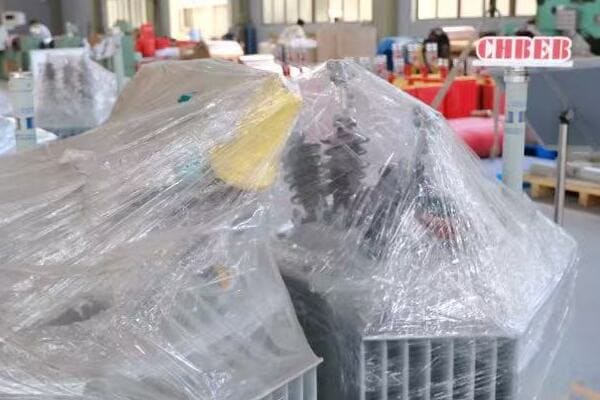
Detailed Export Strategies for Transformer Manufacturers
Let’s explore these export tips in more depth:
1. Adapt Designs to Regional Standards
- For USA: Focus on ANSI C57 series and UL certification
- For Europe: Ensure compliance with IEC standards and EcoDesign Directive
- For Asia: Consider both IEC and local standards (e.g., GB in China)
I once worked with a manufacturer who initially struggled in the US market because their transformers were designed solely to IEC standards. After adapting their designs to meet ANSI requirements, their sales in the USA increased significantly.
2. Pre-emptive Certification
- Obtain UL certification for the USA market
- Secure CE marking for European exports
- Consider region-specific certifications (e.g., CCC for China)
3. Develop Strong Local Partnerships
- Collaborate with local distributors or agents
- Participate in regional industry associations
- Establish relationships with local engineering firms
4. Optimize Lead Times and Compliance
- For Asia: Focus on efficient production and delivery
- For Europe: Emphasize strict adherence to environmental regulations
- For USA: Balance speed with rigorous quality control
5. Tailor Marketing Approaches
- Highlight energy efficiency for European markets
- Emphasize reliability and after-sales support in the USA
- Focus on cost-effectiveness and scalability for Asian markets
Here’s a comparison of key export considerations for different regions:
| Export Aspect | USA | Europe | Asia |
|---|---|---|---|
| Key Standard | ANSI/UL | IEC/CE | IEC/Local |
| Critical Cert | UL Listing | CE Marking | Varies by Country |
| Lead Time Priority | Medium | Low | High |
| Price Sensitivity | Medium | Low | High |
| Key Selling Point | Reliability | Efficiency | Cost-Effectiveness |
In my experience, successful exporting often comes down to understanding and adapting to local market nuances. I recall a European manufacturer who struggled initially in the Asian market due to their premium pricing strategy. After developing a separate product line with streamlined features and more competitive pricing, they saw a significant uptick in their Asian market share.
The importance of local partnerships cannot be overstated. In a recent project, we helped a manufacturer enter the Middle Eastern market by connecting them with a well-established local distributor. This partnership provided invaluable insights into local procurement processes and helped navigate complex regulatory requirements.
Customization capabilities can be a significant differentiator in export markets. I worked with a manufacturer who developed a modular design that could be easily adapted to different voltage standards and enclosure requirements. This flexibility allowed them to quickly respond to diverse market needs across multiple regions.
Language and cultural considerations are often overlooked but can be crucial. I’ve seen cases where poorly translated technical documents led to misunderstandings and lost opportunities. Investing in professional translation and localization of marketing materials and technical specifications can significantly enhance your credibility in foreign markets.
The trend towards digital marketing and virtual product demonstrations is changing how transformers are exported and sold globally. In a recent project, we helped a manufacturer develop a virtual showroom with 3D models and interactive specifications of their transformer range. This tool proved invaluable for reaching international clients, especially during travel restrictions.
Lastly, staying informed about geopolitical developments and trade agreements is crucial for long-term export success. I’m currently advising several manufacturers on how to navigate changing tariff structures and local content requirements in various markets. Being proactive in understanding and adapting to these macro-level changes can give you a significant competitive advantage.
Exporting transformers successfully requires a combination of technical expertise, market understanding, and strategic planning. By tailoring your approach to each target region, building strong local partnerships, and staying adaptable to market changes, you can significantly enhance your chances of success in the global transformer market. Remember, exporting is not just about selling a product; it’s about building lasting relationships and establishing your brand in diverse international markets.
Summary: Regional Focus, Global Opportunity?
Are you wondering how to balance regional market specifics with global expansion opportunities in the transformer industry? You’re not alone. Many manufacturers and buyers struggle to navigate the complex interplay between local requirements and global trends. But what if you could turn these regional differences into a strategic advantage in the global market?
The transformer market shows distinct regional characteristics: the USA focuses on reliability and grid resilience, Europe prioritizes sustainability and efficiency, while Asia emphasizes cost-effectiveness and rapid deployment. Understanding these regional nuances is key to identifying global opportunities and developing successful market strategies.
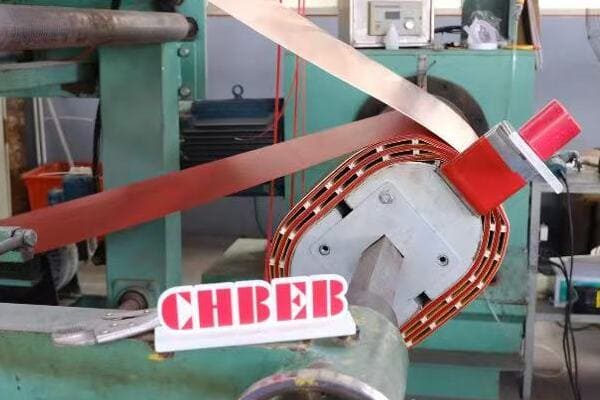
Synthesizing Regional Insights for Global Success
Let’s explore how understanding regional differences can lead to global opportunities:
Leveraging Regional Strengths
Each region offers unique strengths:
- USA: Advanced grid technologies and data center expertise
- Europe: Leadership in energy efficiency and eco-friendly designs
- Asia: Cost-effective manufacturing and rapid scaling capabilities
I once worked with a manufacturer who successfully combined European efficiency standards with Asian manufacturing capabilities to create a highly competitive product line for the global market. This approach allowed them to offer advanced technology at competitive prices, opening doors in multiple regions.
Cross-Pollination of Technologies
Opportunities arise from applying regional innovations globally:
- Adapting European eco-design principles for Asian markets
- Implementing USA-style grid resilience technologies in developing countries
- Applying Asian rapid deployment strategies in Western urban development projects
Standardization vs. Customization
Balancing global standards with local needs:
— Developing core designs that can be easily adapted to regional requirements
- Creating modular solutions that allow for local customization
- Establishing global quality standards while accommodating regional preferences
In a recent project, I advised a manufacturer on developing a "global platform" for their transformer line. This approach involved creating a standardized core design that could be easily modified to meet different regional standards. The result was a more efficient product development cycle and greater flexibility in addressing diverse market needs.
Navigating Regulatory Landscapes
Turning compliance challenges into opportunities:
- Using stringent European standards as a benchmark for global quality
- Leveraging USA cybersecurity requirements to enhance product offerings worldwide
- Applying lessons from rapid certification processes in Asia to streamline global operations
I recall working with a company that initially saw Europe’s strict efficiency regulations as a barrier. However, by embracing these standards and applying them across their entire product line, they positioned themselves as global leaders in high-efficiency transformers, opening new markets beyond Europe.
Global Trends Shaping Regional Markets
Identifying overarching trends that influence all regions:
- Increasing focus on renewable energy integration
- Growing demand for smart grid technologies
- Rising importance of cybersecurity in power systems
Here’s a comparison of how global trends manifest in different regions:
| Global Trend | USA Impact | Europe Impact | Asia Impact |
|---|---|---|---|
| Renewable Energy | Large-scale integration | Distributed generation | Rapid capacity expansion |
| Smart Grid | Advanced analytics | Consumer engagement | Urban infrastructure |
| Cybersecurity | Critical infrastructure protection | Data privacy focus | Emerging regulatory frameworks |
In my experience, companies that successfully navigate the global transformer market are those that can adapt global trends to regional contexts. For instance, I worked with a manufacturer who developed a range of smart transformers with modular communication interfaces. This allowed them to easily adapt their products to different smart grid standards across regions, from the advanced analytics focus in the USA to the consumer engagement emphasis in Europe.
The importance of understanding local business cultures cannot be overstated. I’ve seen cases where technically superior products failed in certain markets due to a lack of cultural alignment in sales and support approaches. Successful global players invest heavily in local market intelligence and relationship-building.
Sustainability is becoming a global driver, but with regional nuances. In Europe, this often translates to stringent efficiency standards and eco-friendly materials. In the USA, there’s a growing focus on lifecycle assessment and recyclability. In Asia, we’re seeing increased interest in energy-efficient transformers as part of broader urban sustainability initiatives. Companies that can address these varied sustainability concerns are well-positioned for global success.
The trend towards digitalization is creating new opportunities across all regions. I’m currently advising several companies on developing IoT-enabled transformers that can be remotely monitored and managed. While the specific applications vary by region – from grid optimization in the USA to predictive maintenance in Europe and rapid fault response in Asia – the underlying technology has global appeal.
Lastly, the increasing interconnectedness of global power grids is driving demand for transformers that can operate seamlessly across different standards. I recently worked on a project involving cross-border power transmission in Europe, which required transformers capable of handling multiple voltage standards and frequencies. This type of project highlights the growing need for flexible, globally-oriented transformer solutions.
In conclusion, success in the global transformer market requires a nuanced understanding of regional differences combined with the ability to identify and leverage global trends. By focusing on regional strengths while maintaining a global perspective, manufacturers and buyers can turn market complexities into strategic advantages. Whether it’s adapting European efficiency standards for Asian markets, applying USA grid resilience technologies globally, or leveraging Asian manufacturing capabilities for cost-effective innovation, the key lies in seeing regional diversity as an opportunity rather than a challenge.
As we look to the future, those who can balance regional expertise with global vision will be best positioned to capitalize on the evolving opportunities in the worldwide transformer market. Remember, in today’s interconnected world, regional focus and global opportunity are not mutually exclusive – they are complementary strategies for achieving success in the dynamic and diverse global transformer industry.
Conclusion
Understanding regional differences in the USA, Europe, and Asia is crucial for success in the global transformer market. Each region offers unique opportunities and challenges. By adapting strategies to local needs while leveraging global trends, companies can achieve significant growth and innovation in this dynamic industry.
🌍 Need help navigating transformer exports to the USA, Europe, or Asia?
📥 Contact our international trade team or download our regional compliance checklist today.
Are you struggling to select the right transformer for your upcoming project? You’re not alone. Many engineers and project managers find themselves overwhelmed by the variety of transformer options available. But what if you could easily identify the perfect transformer for your specific needs?
Electric transformers come in different types including power, distribution, isolation, and control units. Choosing the right one depends on voltage, environment, safety, and application needs. This guide explains 7 key transformer types and how to select the best option based on your project requirements.
In this comprehensive guide, I’ll walk you through the seven common types of electric transformers and provide you with a clear framework for choosing the best one for your project. Whether you’re working on a large-scale power distribution system or a small industrial application, this article will equip you with the knowledge to make an informed decision.
Why Transformer Selection Matters?
Have you ever considered how the wrong transformer choice could derail your entire project? It’s a scenario I’ve seen play out too many times. But why exactly is selecting the right transformer so crucial, and what risks are you taking by not giving it enough attention?
Proper transformer selection is critical for project success. Choosing the wrong type can lead to overheating, fire risks, voltage issues, and compliance failures. Understanding your project’s specific requirements is key to avoiding these potentially costly and dangerous mistakes.
Diving Deeper into the Importance of Transformer Selection
Let’s explore the key reasons why transformer selection is so critical:
Safety Risks
Choosing the wrong transformer can lead to serious safety hazards:
- Overheating due to mismatched load
- Fire risk in indoor installations
- Electrical shock hazards from improper isolation
I once consulted on a project where an undersized transformer was installed in a commercial building. The transformer overheated within months, leading to a small fire. Fortunately, it was caught early, but the potential for disaster was clear. This experience underscored for me the critical importance of proper transformer selection.
Performance Issues
Incorrect transformer selection can significantly impact system performance:
- Voltage drops in long-distance systems
- Poor power quality affecting sensitive equipment
- Inefficient energy transfer leading to higher operational costs
Compliance and Certification
Using the wrong transformer can lead to regulatory issues:
- Certification failure in export projects
- Non-compliance with local electrical codes
- Inability to meet industry-specific standards (e.g., medical, military)
Long-term Reliability
The right transformer choice affects the longevity of your entire system:
- Premature equipment failure
- Increased maintenance requirements
- Shortened overall system lifespan
Here’s a breakdown of potential risks associated with improper transformer selection:
| Risk Category | Potential Consequences | Impact on Project |
|---|---|---|
| Safety | Fire, electrical hazards | Catastrophic, life-threatening |
| Performance | Voltage issues, inefficiency | Operational failures, increased costs |
| Compliance | Regulatory violations | Legal issues, project delays |
| Reliability | Frequent breakdowns | Increased downtime, maintenance costs |
In my experience, the consequences of improper transformer selection often extend far beyond the immediate technical issues. I recall a renewable energy project where the chosen transformers weren’t adequately rated for the fluctuating loads typical of wind power generation. This led to not only performance issues but also put the entire project’s financial viability at risk due to reduced energy output and increased maintenance costs.
The impact on project timelines can also be significant. In a recent industrial expansion project, the late realization that the specified transformers didn’t meet local regulatory requirements led to months of delays and substantial cost overruns. This situation could have been easily avoided with proper initial selection.
It’s also worth noting that transformer selection can have long-term implications for system flexibility and future expansion. I’ve seen cases where short-sighted transformer choices limited a facility’s ability to adapt to changing power needs or integrate new technologies down the line. This underscores the importance of considering not just current requirements but also future scenarios when selecting transformers.
Environmental factors play a crucial role in transformer selection, a fact often overlooked in initial planning stages. I once worked on a project in a coastal area where standard transformers quickly succumbed to corrosion due to the salt-laden air. The cost of replacing these units far exceeded what would have been spent on properly specified, environmentally suited transformers from the start.
Lastly, the energy efficiency implications of transformer selection are becoming increasingly important, especially in the context of global sustainability efforts. I’m currently involved in a large-scale industrial project where the focus on high-efficiency transformers is expected to result in significant energy savings over the system’s lifetime, aligning with both cost-saving objectives and corporate sustainability goals.
As we delve deeper into the various types of transformers and selection criteria, keep in mind that the right choice is not just about meeting immediate technical specifications. It’s about ensuring safety, compliance, performance, and long-term reliability. The time and effort invested in proper transformer selection pay dividends throughout the life of your project, safeguarding against risks and setting the foundation for operational success.
7 Common Types of Electric Transformers?
Are you finding it challenging to navigate the diverse world of electric transformers? You’re not alone. Many professionals in the field struggle to differentiate between various transformer types and their specific applications. But what if you had a clear, comprehensive guide to the most common transformer types used in modern electrical systems?
**The 7 common types of electric transformers are:
- Power Transformers – Used for high-voltage transmission (33kV+)
- Distribution Transformers – Step down voltage for end users (400V–11kV)
- Isolation Transformers – Provide electrical separation for safety
- Auto Transformers – Compact and cost-efficient, for voltage regulation
- Control Transformers – Power industrial machinery control panels
- Instrument Transformers (CTs/VTs) – Enable safe measurement & metering
- Pad-Mounted Transformers – Compact outdoor units for underground grids**

Exploring the 7 Common Types of Electric Transformers
Let’s dive deeper into each type of transformer, exploring their unique characteristics and applications:
1. Power Transformers
Key features:
- High voltage handling (33kV and above)
- Large capacity (typically above 5 MVA)
- Used in transmission substations
I once worked on a project upgrading a major substation where we installed a 500 MVA power transformer. The sheer size and complexity of the unit were awe-inspiring, highlighting the critical role these transformers play in our power infrastructure.
2. Distribution Transformers
Characteristics:
- Step down voltage for end-user distribution (typically to 400V-11kV)
- Commonly seen on utility poles or in ground-mounted enclosures
- Sizes range from 5 kVA to 3000 kVA
3. Isolation Transformers
Unique aspects:
- Provide galvanic isolation between primary and secondary windings
- Crucial for noise reduction and safety in sensitive equipment
- Common in medical and laboratory settings
4. Auto Transformers
Special features:
- Single winding acts as both primary and secondary
- More compact and cost-effective than two-winding transformers
- Often used for voltage regulation and motor starting
5. Control Transformers
Key points:
- Designed for industrial control and automation systems
- Provide stable output under varying load conditions
- Typically small in size, ranging from 50 VA to 5 kVA
6. Instrument Transformers
Two main types:
- Current Transformers (CTs): Step down high currents for measurement
- Voltage Transformers (VTs): Reduce high voltages for metering and protection
7. Pad-Mounted Transformers
Distinctive features:
- Designed for underground distribution systems
- Enclosed in tamper-resistant, weather-proof housing
- Common in residential areas and commercial developments
Here’s a comparison table of these transformer types:
| Type | Voltage Range | Typical Applications | Key Advantage |
|---|---|---|---|
| Power | 33kV+ | Transmission substations | High capacity |
| Distribution | 400V-11kV | Residential/commercial power | Wide-spread use |
| Isolation | Various | Medical equipment, labs | Enhanced safety |
| Auto | Various | Voltage regulation | Compact design |
| Control | Low voltage | Industrial automation | Stable output |
| Instrument | Various | Metering and protection | Accurate measurement |
| Pad-Mounted | Distribution level | Underground systems | Aesthetic, secure |
In my experience, understanding these different transformer types is crucial for effective system design and troubleshooting. I recall a project where we were experiencing mysterious power quality issues in a manufacturing plant. It turned out that a standard distribution transformer had been used where a control transformer was needed for the sensitive automation equipment. Replacing it with the correct type resolved the issues immediately.
The choice between these transformer types can have significant implications for project cost and efficiency. In a recent renewable energy project, we opted for pad-mounted transformers instead of traditional pole-mounted units. While initially more expensive, this choice improved the aesthetics of the site and reduced maintenance costs over time, ultimately providing better value for the client.
It’s also worth noting that the boundaries between these transformer types are sometimes blurred in modern applications. I’m currently working on a smart grid project where we’re using hybrid transformers that combine features of distribution and instrument transformers, allowing for both power distribution and advanced grid monitoring in a single unit.
The trend towards more compact and efficient designs is influencing all transformer types. For instance, in a recent data center project, we used high-efficiency isolation transformers that were significantly smaller than traditional models but offered superior performance in terms of both isolation and energy efficiency.
Lastly, the growing focus on renewable energy and distributed generation is creating new demands for transformer technology. I’m seeing increased interest in bi-directional transformers that can handle the variable loads and reverse power flows associated with solar and wind energy systems. This evolution in transformer design is crucial for supporting the transition to more sustainable energy sources.
Understanding these seven common types of electric transformers provides a solid foundation for anyone working with electrical systems. Whether you’re designing a new installation, troubleshooting an existing system, or planning for future upgrades, knowing the characteristics and applications of each transformer type is essential. As we move towards more complex and interconnected power systems, this knowledge becomes even more valuable, enabling you to make informed decisions that balance performance, efficiency, and cost-effectiveness in your projects.
How to Choose the Best Transformer for Your Project?
Are you feeling overwhelmed by the process of selecting the right transformer for your project? You’re not alone. Many professionals find themselves uncertain about which factors to prioritize when making this crucial decision. But what if you had a clear, step-by-step approach to ensure you choose the perfect transformer every time?
**To choose the best transformer for your project, consider these key factors:
- Required input/output voltage
- Indoor or outdoor use
- Fire safety requirements
- Need for electrical isolation
- kVA capacity requirement
- Compliance standards (IEC/ANSI/UL)
- Environmental constraints
- System type (renewable, utility, or industrial)**

A Comprehensive Guide to Transformer Selection
Let’s break down the process of choosing the right transformer into manageable steps:
Step 1: Determine Voltage Requirements
Key considerations:
- Input voltage from power source
- Required output voltage for your application
- Voltage regulation needs
I once consulted on a project where the client overlooked the fact that their new equipment required a different voltage than what was available. This oversight led to significant delays and additional costs. Always start with a clear understanding of your voltage needs.
Step 2: Assess the Installation Environment
Factors to consider:
- Indoor vs. outdoor installation
- Temperature and humidity ranges
- Presence of corrosive elements or dust
Step 3: Evaluate Safety Requirements
Critical safety aspects:
- Fire risk in the installation area
- Need for electrical isolation
- Proximity to sensitive equipment or personnel
Step 4: Calculate Load Requirements
Important calculations:
- Total kVA capacity needed
- Load profile (constant vs. variable)
- Future expansion plans
Step 5: Check Compliance Standards
Relevant standards may include:
- IEC (International Electrotechnical Commission)
- ANSI (American National Standards Institute)
- UL (Underwriters Laboratories)
Step 6: Consider Environmental Constraints
Environmental factors:
- Noise limitations
- Space constraints
- Environmental protection requirements
Step 7: Identify System Type
System characteristics:
- Renewable energy integration needs
- Grid connection requirements
- Industrial process specifications
Here’s a checklist to guide your transformer selection process:
| Selection Criteria | Questions to Ask | Importance |
|---|---|---|
| Voltage | What are the input/output voltages? | Critical |
| Environment | Indoor or outdoor installation? | High |
| Safety | Is fire resistance needed? | Critical |
| Load | What is the required kVA capacity? | High |
| Compliance | Which standards must be met? | High |
| Environmental | Any special environmental needs? | Medium |
| System Type | Renewable, utility, or industrial? | Medium |
In my experience, the most successful projects are those where transformer selection is considered early in the planning process. I recall a renewable energy project where we initially overlooked the need for transformers capable of handling reverse power flow. Realizing this mid-project led to significant redesigns and delays. Now, I always emphasize the importance of considering all aspects of the system when selecting transformers.
The trend towards energy efficiency is increasingly influencing transformer selection. In a recent industrial project, we opted for high-efficiency transformers despite their higher upfront cost. The energy savings over the life of the installation more than justified the initial investment, highlighting the importance of considering long-term operational costs in your selection process.
It’s also crucial to consider future needs when selecting transformers. I’ve seen cases where short-sighted transformer choices limited a facility’s ability to expand or adapt to changing requirements. Now, I always advise clients to consider potential future scenarios and select transformers that offer some flexibility for growth or changes in power needs.
The rise of smart grid technologies is adding new dimensions to transformer selection. In a recent project, we chose transformers with built-in monitoring capabilities. While more expensive initially, these smart transformers provided valuable data on power quality and usage patterns, enabling more efficient overall system management.
Lastly, don’t underestimate the importance of supplier support in your selection process. I’ve found that working with suppliers who offer strong technical support and after-sales service can be invaluable, especially for complex or critical installations. In one challenging project, the expertise provided by the transformer manufacturer’s technical team was crucial in resolving unforeseen integration issues.
Choosing the right transformer is a critical decision that impacts the safety, efficiency, and long-term success of your electrical system. By systematically considering factors like voltage requirements, environmental conditions, safety needs, load specifications, compliance standards, and system type, you can ensure that you select the best transformer for your specific project needs. Remember, the time invested in careful transformer selection pays dividends throughout the life of your installation, contributing to safer, more reliable, and more efficient electrical systems.
Conclusion
Selecting the right transformer is crucial for project success. Consider voltage, environment, safety, load, compliance, and system type. The right choice ensures efficiency, safety, and long-term reliability. Consult experts for complex projects to optimize your transformer selection and system performance.
Are you struggling to predict transformer costs for your upcoming projects? You’re not alone. With the rapidly changing global market, many buyers find themselves caught off guard by unexpected price fluctuations. But what if you could anticipate these changes and plan your budget more effectively?
Transformer prices in 2025 are shaped by rising material costs, global supply chain volatility, and evolving buyer demands. Understanding the top five price trends helps energy project developers, EPC contractors, and industrial buyers make smarter procurement decisions and optimize budgets in a changing global market.
In this comprehensive guide, I’ll walk you through the five key trends that will shape transformer prices in 2025. Whether you’re planning a large-scale energy project or managing procurement for an industrial facility, this information will help you navigate the complex world of transformer pricing and make more informed decisions.
Raw Material Costs Remain a Major Driver?
Are you finding it challenging to predict transformer costs due to fluctuating raw material prices? You’re not alone. Many buyers are grappling with the impact of volatile material markets on their procurement strategies. But what exactly is driving these fluctuations, and how can you mitigate their impact on your projects?
Copper, silicon steel, and insulation material prices continue to fluctuate due to supply chain pressures and geopolitical uncertainty. Since copper content makes up a significant share of transformer costs, even a 5–10% price change in raw materials can dramatically impact final product pricing.
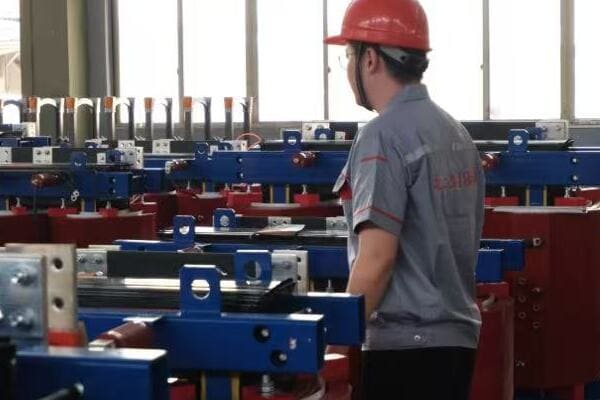
Diving Deeper into Raw Material Cost Impacts
Let’s explore the key factors influencing raw material costs and their effects on transformer pricing:
Copper Price Volatility
Copper is a critical component in transformer manufacturing, often accounting for 15-20% of the total cost. I’ve seen projects where a sudden spike in copper prices led to a 7% increase in the overall transformer cost, catching many buyers off guard.
Key factors affecting copper prices:
- Global demand, especially from emerging economies
- Supply disruptions in major copper-producing countries
- Currency fluctuations, particularly the US dollar
Silicon Steel Market Dynamics
Electrical steel, or silicon steel, is another crucial material in transformer cores. Its price can significantly impact the overall cost of transformers.
Factors influencing silicon steel prices:
- Production capacity in major steel-producing countries
- Trade policies and tariffs
- Technological advancements in steel manufacturing
Insulation Materials
While less volatile than copper or steel, insulation material costs can still impact transformer prices.
Considerations for insulation materials:
- Oil prices (for oil-based insulations)
- Environmental regulations affecting production
- Innovations in eco-friendly insulation technologies
Here’s a breakdown of how raw material costs typically contribute to transformer pricing:
| Material | Percentage of Total Cost | Price Volatility |
|---|---|---|
| Copper | 15-20% | High |
| Silicon Steel | 10-15% | Medium |
| Insulation Materials | 5-10% | Low to Medium |
| Other Components | 55-70% | Varies |
In my experience, successful buyers often employ strategies to mitigate the impact of raw material price fluctuations. I recall a project where we implemented a price adjustment clause in the contract, linked to the London Metal Exchange (LME) copper index. This approach protected both the buyer and the supplier from extreme price swings, ensuring a fair deal for both parties.
Another effective strategy I’ve seen is the use of financial hedging instruments. In a large-scale grid modernization project, the procurement team worked with financial experts to hedge against copper price increases. This foresight saved the project millions when copper prices surged unexpectedly mid-way through the contract period.
It’s also worth noting that not all transformers are equally affected by raw material price changes. Dry-type transformers, for instance, typically use less copper than oil-filled units of similar capacity. In a recent industrial project, we opted for dry-type units partly because their pricing was less sensitive to copper market fluctuations.
The trend towards more efficient transformer designs is also influencing the raw material cost equation. I’m currently involved in a research project exploring the use of high-temperature superconducting materials in transformer windings. While still in the experimental stage, these materials promise to dramatically reduce copper usage, potentially decreasing the impact of copper price volatility on future transformer costs.
Lastly, it’s important to consider the global nature of the raw materials market. In a recent international project, we found significant price differences for transformers sourced from different regions, largely due to variations in local raw material costs and supply chain efficiencies. This experience highlighted the importance of considering global sourcing options to optimize costs.
As we look towards 2025, understanding and anticipating raw material cost trends will be crucial for anyone involved in transformer procurement. By staying informed about global economic trends, technological advancements, and geopolitical factors affecting key materials like copper and silicon steel, buyers can make more accurate cost projections and develop more effective procurement strategies. Remember, in the world of transformer pricing, knowledge of raw material markets can be your most valuable asset.
Surge in Demand from Renewable Energy and Smart Grid Projects?
Are you noticing a significant uptick in transformer demand for your renewable energy or smart grid projects? You’re not alone. The global push towards cleaner energy and smarter infrastructure is creating unprecedented demand for specialized transformers. But how is this surge affecting prices, and what can you do to ensure your projects stay on budget?
Solar, wind, and battery energy storage projects are accelerating globally—especially in the U.S., China, India, and the Middle East. These sectors are driving demand for pad-mounted, dry-type, and inverter-integrated transformers, pushing prices higher due to limited supply.
Exploring the Impact of Renewable Energy on Transformer Demand
Let’s dive into how the renewable energy boom is shaping the transformer market:
Solar Power Transformation
The rapid growth of solar farms is creating a surge in demand for specialized transformers.
Key factors:
- Need for inverter-duty transformers
- Demand for compact, pad-mounted units
- Requirements for high efficiency to maximize energy yield
I recently worked on a large-scale solar project in the Southwest U.S. where we faced unexpected delays due to a shortage of suitable transformers. The demand had outpaced supply, leading to extended lead times and higher prices. This experience underscored the importance of early procurement planning in renewable energy projects.
Wind Energy Challenges
Offshore and onshore wind farms have unique transformer requirements.
Considerations for wind farm transformers:
- Need for robust designs to withstand harsh environments
- Demand for high-capacity units for offshore installations
- Requirements for compact designs in nacelle-mounted applications
Energy Storage Integration
The growth of battery energy storage systems is creating new demands on transformer technology.
Emerging trends:
- Need for bidirectional power flow capabilities
- Demand for transformers with advanced monitoring features
- Requirements for rapid load change management
Here’s a breakdown of how different renewable energy sectors are impacting transformer demand:
| Sector | Transformer Type | Demand Growth (2020-2025) | Price Impact |
|---|---|---|---|
| Solar | Inverter-duty, Pad-mounted | 150% | High |
| Wind | Step-up, Offshore-rated | 100% | Medium-High |
| Energy Storage | Bidirectional, Smart | 200% | Very High |
| Smart Grid | Distribution, with monitoring | 80% | Medium |
In my experience, the impact of this demand surge varies significantly by region and project type. For instance, in a recent smart grid modernization project in Europe, we found that prices for distribution transformers with advanced monitoring capabilities had increased by nearly 20% over the past two years. This increase was largely driven by the limited number of manufacturers capable of meeting the stringent smart grid specifications.
The trend towards larger, more efficient renewable energy installations is also influencing transformer requirements. I’m currently advising on an offshore wind project where the move to higher capacity turbines has necessitated the use of significantly larger step-up transformers. These specialized units come at a premium, reflecting both their advanced technology and the limited pool of suppliers capable of manufacturing them.
Interestingly, the surge in demand is also driving innovation in transformer design. In a recent solar farm project, we utilized new compact, high-efficiency transformers that were specifically designed for utility-scale solar applications. While these units came at a higher upfront cost, their improved efficiency and smaller footprint provided long-term savings and simplified installation logistics.
The integration of energy storage systems with renewable sources is creating new challenges and opportunities in transformer design. I recently consulted on a hybrid solar-plus-storage project where we needed transformers capable of handling bidirectional power flow and rapid load changes. The limited availability of such specialized units led to longer lead times and higher costs, highlighting the need for early engagement with suppliers on complex projects.
Lastly, it’s worth noting that the renewable energy boom is not just affecting new transformer sales but also the refurbishment market. In several recent grid integration projects for renewable energy, we’ve seen an increased demand for upgrading existing transformers to handle the new power flow patterns introduced by distributed generation. This trend is creating opportunities for service providers specializing in transformer retrofits and upgrades.
As we look towards 2025, the surge in demand from renewable energy and smart grid projects will continue to be a major factor in transformer pricing and availability. For buyers and project managers in these sectors, early planning, flexible design approaches, and strong supplier relationships will be key to navigating this high-demand market. By understanding these trends and planning accordingly, you can better position your projects for success in the rapidly evolving landscape of clean energy and smart infrastructure.
Transportation and Export Logistics Costs Are Rising?
Are you finding that transportation costs are eating into your transformer procurement budget more than ever before? You’re not alone. Many buyers are grappling with the rising costs and complexities of shipping transformers across the globe. But what’s driving these increases, and how can you mitigate their impact on your projects?
Shipping container shortages, higher fuel prices, and port congestion are adding $500–$1,500 to export costs per unit depending on destination. Buyers in Africa, South America, and Southeast Asia should factor in extended lead times and higher freight rates.

Diving Deeper into Transportation and Export Challenges
Let’s explore the key factors influencing transportation costs and their effects on transformer pricing:
Global Shipping Container Shortage
The ongoing shortage of shipping containers is significantly impacting transformer exports.
Key impacts:
- Increased competition for available containers
- Higher container rental rates
- Longer wait times for shipments
I recently managed a project shipping large power transformers to Southeast Asia. The container shortage forced us to delay shipment by six weeks, incurring additional storage costs and nearly jeopardizing the project timeline. This experience highlighted the critical need for flexible logistics planning in today’s market.
Rising Fuel Costs
Fluctuating fuel prices are directly affecting shipping rates.
Factors to consider:
- Global oil price trends
- Implementation of low-sulfur fuel regulations
- Variations in fuel surcharges among carriers
Port Congestion and Delays
Many major ports are experiencing significant congestion, leading to delays and additional costs.
Challenges include:
- Extended waiting times for berths
- Increased demurrage and detention charges
- Unpredictable schedules affecting project timelines
Here’s a breakdown of how transportation costs are impacting transformer pricing for different destinations:
| Destination Region | Avg. Cost Increase per Unit | Lead Time Extension |
|---|---|---|
| North America | $500 – $800 | 2-3 weeks |
| Europe | $600 – $1000 | 3-4 weeks |
| Asia Pacific | $700 – $1200 | 4-6 weeks |
| Africa | $1000 – $1500 | 6-8 weeks |
| South America | $900 – $1400 | 5-7 weeks |
In my experience, successful buyers are adopting various strategies to mitigate these rising costs. In a recent project for a utility in Africa, we negotiated a flexible delivery schedule with the transformer manufacturer. This allowed us to take advantage of more favorable shipping rates by being flexible with our shipping dates, ultimately saving nearly 15% on transportation costs.
Another effective approach I’ve seen is the use of alternative shipping methods. For a project in a remote part of South America, we utilized a combination of sea and river transport. While this required more complex logistics planning, it significantly reduced costs compared to traditional sea-to-road options and avoided congested major ports.
The trend towards larger, more powerful transformers is also impacting shipping strategies. I recently consulted on a project involving ultra-high voltage transformers where the size and weight necessitated specialized heavy-lift vessels. The limited availability of these ships led to premium pricing and required booking months in advance, emphasizing the need for early logistics planning in large-scale projects.
Interestingly, some manufacturers are adapting their designs to address shipping challenges. I’m currently working with a supplier developing modular transformer designs that can be partially assembled on-site. This approach reduces shipping volume and allows for more flexible transportation options, potentially offering significant cost savings for projects in hard-to-reach locations.
The rise of digital logistics platforms is also changing how transformer shipping is managed. In a recent multinational project, we utilized a blockchain-based logistics platform to track our shipments in real-time. This improved visibility allowed us to proactively manage delays and reroute shipments when necessary, minimizing the impact of logistics disruptions on our project timeline.
Lastly, it’s worth noting that the environmental impact of shipping is becoming an increasingly important factor. I’m seeing a growing trend among environmentally conscious clients to consider the carbon footprint of transformer transportation in their procurement decisions. In some cases, this has led to choosing local or regional suppliers over international options, despite potentially higher unit costs, to reduce overall environmental impact and simplify logistics.
As we look towards 2025, managing transportation and export logistics will remain a critical challenge in transformer procurement. Buyers need to be proactive in their logistics planning, flexible in their approach, and open to innovative solutions. By factoring in these rising costs early in the project planning stage and exploring alternative shipping strategies, you can better manage your budget and ensure timely delivery of transformers to your project sites, regardless of global shipping challenges.
Testing, Certification, and Compliance Requirements Add Cost Layers?
Are you finding that compliance with various standards and certifications is taking up an increasingly large portion of your transformer budget? You’re not alone. Many buyers are grappling with the rising costs associated with meeting stringent testing and certification requirements. But why are these costs increasing, and how can you navigate this complex landscape without breaking the bank?
IEC, ANSI, CE, ISO certifications are now requested in over 70% of international projects. Buyers demanding type tests, FAT, or third-party inspections should expect 5–12% additional costs. Environmental compliance (RoHS, REACH) also impacts final quotes.
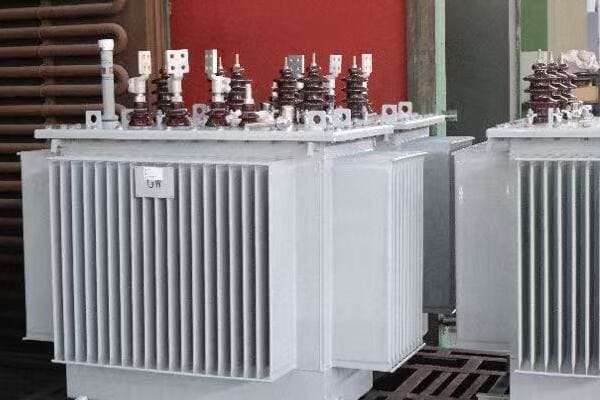
Exploring the Impact of Testing and Certification Requirements
Let’s dive into the key factors driving up costs in testing and certification:
Proliferation of International Standards
The global nature of the transformer market means complying with multiple standards.
Key standards to consider:
- IEC (International Electrotechnical Commission)
- ANSI (American National Standards Institute)
- CE (Conformité Européenne)
- Various regional and country-specific standards
I recently worked on a project where the transformer needed to comply with both IEC and ANSI standards due to its intended use in multiple countries. The additional testing required to meet both standards increased the overall cost by nearly 8%, a significant amount that hadn’t been initially budgeted for.
Rigorous Type Testing Requirements
Type tests are becoming more comprehensive and frequent.
Common type tests include:
- Temperature rise test
- Lightning impulse test
- Short circuit withstand test
- Noise level test
Factory Acceptance Tests (FAT)
FATs are increasingly demanded by buyers to ensure quality.
FAT considerations:
- Costs of witness testing
- Potential for delays if issues are found
- Additional travel and accommodation expenses for inspectors
Environmental Compliance
New regulations are adding layers of environmental compliance.
Key environmental standards:
- RoHS (Restriction of Hazardous Substances)
- REACH (Registration, Evaluation, Authorization and Restriction of Chemicals)
- Various energy efficiency standards
Here’s a breakdown of how different testing and certification requirements impact transformer costs:
| Requirement | Typical Cost Increase | Time Impact |
|---|---|---|
| IEC Certification | 3-5% | 2-4 weeks |
| ANSI Certification | 4-6% | 3-5 weeks |
| CE Marking | 2-3% | 1-2 weeks |
| Full Type Testing | 7-10% | 4-8 weeks |
| Witness FAT | 3-5% | 1-2 weeks |
| Environmental Compliance | 2-4% | Varies |
In my experience, successful buyers are finding ways to optimize these costs without compromising on quality or compliance. In a recent large-scale procurement project, we negotiated a package deal with the manufacturer for type testing across multiple units. This bulk approach to testing reduced the per-unit cost significantly, saving nearly 15% on overall testing expenses.
Another effective strategy I’ve seen is the use of virtual witnessing for Factory Acceptance Tests. In a project during the height of travel restrictions, we utilized high-definition video streaming and real-time data sharing to conduct FATs remotely. This not only saved on travel costs but also allowed for more flexible scheduling, reducing project delays.
The trend towards more stringent environmental standards is also driving innovation in transformer design and materials. I recently consulted on a project where the manufacturer developed a new biodegradable insulating fluid to meet strict environmental regulations. While this initially increased costs, it opened up new market opportunities and eventually led to cost savings through economies of scale.
Interestingly, some buyers are finding value in going beyond minimum certification requirements. In a recent utility project, we opted for more comprehensive type testing than required by standards. While this increased upfront costs, it provided valuable data that improved long-term reliability and reduced maintenance costs, ultimately offering better value over the transformer’s lifecycle.
The complexity of compliance is also leading to the rise of specialized testing and certification consultants. I’ve worked with several clients who engaged third-party experts to navigate the maze of international standards. While this adds an additional cost layer, it often results in more efficient testing processes and reduces the risk of non-compliance issues down the line.
Lastly, it’s worth noting that the push for standardization in testing and certification is gaining momentum. I’m currently involved in an industry working group aimed at harmonizing testing requirements across different international standards. This effort, while challenging, has the potential to significantly reduce compliance costs in the long term by eliminating redundant testing.
As we look towards 2025, managing testing, certification, and compliance costs will remain a critical aspect of transformer procurement. Buyers need to be strategic in their approach, considering not just the immediate costs but also the long-term benefits of comprehensive testing and certification. By understanding these requirements early in the procurement process, exploring innovative testing methods, and leveraging bulk testing opportunities, you can better manage these cost layers while ensuring your transformers meet all necessary standards and regulations.
Bulk Orders and Supplier Relationships Influence Unit Price?
Are you wondering how to get the best price for your transformer orders? You’re not alone. Many buyers are discovering that the key to competitive pricing often lies in strategic ordering and strong supplier relationships. But how exactly do these factors influence pricing, and how can you leverage them to your advantage?
While single-unit prices remain high, bulk buyers and repeat clients benefit from 8–15% price reductions. Long-term partnerships and framework agreements offer better cost predictability and delivery priority in peak periods.

Diving Deeper into Bulk Ordering and Supplier Relationships
Let’s explore how bulk orders and strong supplier relationships can impact transformer pricing:
Economies of Scale in Bulk Orders
Larger orders often lead to significant cost savings.
Key benefits of bulk ordering:
- Reduced per-unit manufacturing costs
- More efficient use of production capacity
- Lower shipping and handling costs per unit
I recently managed a project for a utility company where we consolidated orders from multiple substations. By increasing our order from 10 to 25 units, we secured a 12% reduction in per-unit cost, resulting in substantial savings for the overall project.
Long-Term Supplier Partnerships
Building strong relationships with suppliers can lead to preferential pricing and terms.
Advantages of long-term partnerships:
- Priority production scheduling
- Access to new technologies and innovations
- More flexible payment terms
Framework Agreements
These agreements can provide cost stability and supply assurance.
Benefits of framework agreements:
- Locked-in pricing for extended periods
- Guaranteed supply during peak demand
- Simplified procurement processes for repeat orders
Here’s a breakdown of how order size and relationship status typically impact transformer pricing:
| Order Size / Relationship | Typical Price Reduction | Additional Benefits |
|---|---|---|
| Single Unit (New Customer) | 0% (Base price) | Standard lead time |
| 5-10 Units | 3-5% | Slight lead time reduction |
| 11-25 Units | 5-8% | Priority scheduling |
| 26+ Units | 8-15% | Customization options |
| Repeat Customer | 5-10% | Flexible payment terms |
| Long-Term Partner | 10-15% | Technology access, dedicated support |
In my experience, the impact of bulk ordering and strong supplier relationships goes beyond just price reductions. I recall a project during a period of high market demand where our long-standing relationship with a supplier ensured we received our transformers on schedule, while many other buyers faced significant delays. This timely delivery was crucial for meeting our project deadlines and avoiding costly penalties.
Another interesting aspect is the potential for co-development opportunities that can arise from strong supplier relationships. In a recent collaboration with a long-term supplier, we worked together to develop a custom transformer design optimized for our specific grid requirements. This not only resulted in better performance but also gave us a competitive edge in our operations.
The trend towards more flexible and modular transformer designs is also influencing bulk ordering strategies. I’m currently advising on a project where we’re using a standardized core design across multiple transformer ratings. This approach allows us to benefit from bulk pricing while still maintaining the flexibility to adjust specifications for different applications.
Interestingly, some buyers are forming consortiums to leverage bulk ordering benefits. I recently facilitated a joint procurement initiative where several smaller utilities combined their orders. This collective approach not only secured better pricing but also opened up access to higher-tier suppliers that typically cater to larger orders.
The rise of digital procurement platforms is also changing how buyers interact with suppliers and manage bulk orders. In a recent project, we utilized an AI-driven procurement system that analyzed our historical usage patterns and projected future needs. This data-driven approach allowed us to optimize our order quantities and timing, maximizing bulk discounts while minimizing storage costs.
Lastly, it’s worth noting that the concept of "bulk" is evolving in the transformer market. With the trend towards more specialized and custom units, some suppliers are offering "bulk" discounts based on total order value rather than just quantity. This approach can be particularly beneficial for buyers of larger, high-value transformers.
As we look towards 2025, strategic bulk ordering and nurturing strong supplier relationships will remain key factors in optimizing transformer procurement. Buyers need to balance the benefits of bulk pricing with considerations like storage capacity, project timelines, and technological advancements. By developing a comprehensive procurement strategy that leverages both volume discounts and long-term partnerships, you can secure not just better pricing, but also enhanced reliability, flexibility, and access to cutting-edge transformer technologies.
Conclusion
Understanding these five key price trends is crucial for effective transformer procurement in 2025. Raw material costs, renewable energy demand, logistics challenges, compliance requirements, and strategic purchasing all play vital roles in shaping prices. Buyers must stay informed and adaptable to navigate this complex market successfully.
Recent Post
Product
Request A free quote
We'd like to work with you
- +86 15558785111
- chbebgroup@chbebpower.com
- +86 15558785111
What We Do
CHINA BEI ER BIAN (CHBEB) GROUP, with 218 million in registered capital, originated from Beijing Beierbian Transformer Group. Headquartered in Beijing for R&D, it operates major production bases in Nanjing and Yueqing, producing high-quality products.
Latest Post
Latest Product
Contact Us
- +86 15558785111
- chbebgroup@chbebpower.com
- +86 15558785111
BeiJing
No 3,RongJing East Road,BeiJing Economic Technological Development Area,BeiJing,China
JiangSu
No 7️Xiangfeng Road,Jiangning,NanJing,JiangSu,China
WenZhou
No.211, Wei 16 Road, Industrial Zone, Yueqing, Wenzhou, Zhejiang, China.
XiangYang Industrial Zone ,YueQing,WenZhou,ZheJiang,China

